Literature Review on Wearable Sensor Technology
VerifiedAdded on 2023/04/17
|54
|11470
|146
AI Summary
This literature review explores the impact of wearable sensor technology on healthcare and physical fitness. It discusses the history and development of wearable sensors, including their use in the Apollo Space Program. The review also examines the future of wearable technology and its potential applications. It highlights the FitBit Surge as a revolutionary fitness tracker and discusses its features. The review concludes with an analysis of the strengths and weaknesses of existing research and development in wearable sensor technology.
Contribute Materials
Your contribution can guide someone’s learning journey. Share your
documents today.

Literature review 1
LITERATURE REVIEW
By Name
Course
Instructor
Institution
Location
Date
LITERATURE REVIEW
By Name
Course
Instructor
Institution
Location
Date
Secure Best Marks with AI Grader
Need help grading? Try our AI Grader for instant feedback on your assignments.

Literature review 2
Table of content
Table of content...........................................................................................................................................2
List of figures..............................................................................................................................................3
INTRODUCTION.......................................................................................................................................4
STATE OF ART AND DEVELOPMENT OF WEARABLE SENSORS...................................................5
How wearable sensor technology changing the world............................................................................8
Future of wearable technology...............................................................................................................9
WEARABLE SENSOR TECHNOLOGY...................................................................................................9
Wearable sensor technology in physical fitness.......................................................................................9
FitBit Surge..........................................................................................................................................9
Gymwatch Fitness Tracker.................................................................................................................13
Pebble Time.......................................................................................................................................15
Android Sleep App.............................................................................................................................17
PIP......................................................................................................................................................18
Fitbit Aria...........................................................................................................................................22
Wearable sensor technology in healthcare.............................................................................................25
iTBra..................................................................................................................................................25
Aira sensor.........................................................................................................................................30
Quell Relief........................................................................................................................................33
QardioCore........................................................................................................................................36
Embrace Watch Wearable sensor......................................................................................................39
HealthPatch MD................................................................................................................................41
Novocure...........................................................................................................................................43
DRAW CONCLUSIONS OF THE STRENGTHS AND WEAKNESSES OF EXISTING RESEARCH
AND DEVELOPMENT OF WEARABLE SENSORS.............................................................................48
Identify open research problems and derive insights and visions into future research, development, and
applications................................................................................................................................................50
Speculate, conceive and design a novel sensing architecture and platform................................................51
Conclusion.................................................................................................................................................52
Bibliography..............................................................................................................................................53
Table of content
Table of content...........................................................................................................................................2
List of figures..............................................................................................................................................3
INTRODUCTION.......................................................................................................................................4
STATE OF ART AND DEVELOPMENT OF WEARABLE SENSORS...................................................5
How wearable sensor technology changing the world............................................................................8
Future of wearable technology...............................................................................................................9
WEARABLE SENSOR TECHNOLOGY...................................................................................................9
Wearable sensor technology in physical fitness.......................................................................................9
FitBit Surge..........................................................................................................................................9
Gymwatch Fitness Tracker.................................................................................................................13
Pebble Time.......................................................................................................................................15
Android Sleep App.............................................................................................................................17
PIP......................................................................................................................................................18
Fitbit Aria...........................................................................................................................................22
Wearable sensor technology in healthcare.............................................................................................25
iTBra..................................................................................................................................................25
Aira sensor.........................................................................................................................................30
Quell Relief........................................................................................................................................33
QardioCore........................................................................................................................................36
Embrace Watch Wearable sensor......................................................................................................39
HealthPatch MD................................................................................................................................41
Novocure...........................................................................................................................................43
DRAW CONCLUSIONS OF THE STRENGTHS AND WEAKNESSES OF EXISTING RESEARCH
AND DEVELOPMENT OF WEARABLE SENSORS.............................................................................48
Identify open research problems and derive insights and visions into future research, development, and
applications................................................................................................................................................50
Speculate, conceive and design a novel sensing architecture and platform................................................51
Conclusion.................................................................................................................................................52
Bibliography..............................................................................................................................................53
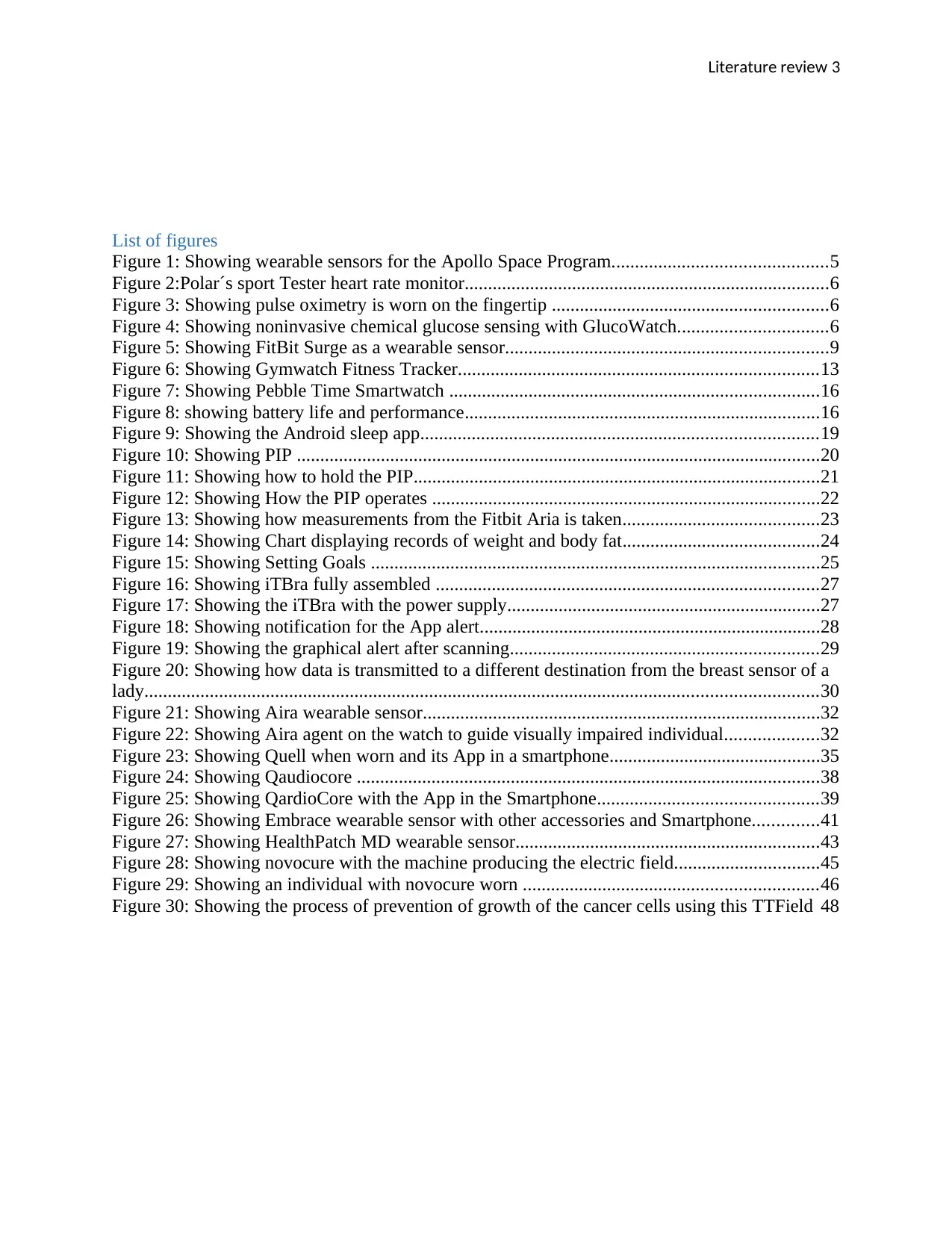
Literature review 3
List of figures
Figure 1: Showing wearable sensors for the Apollo Space Program..............................................5
Figure 2:Polar´s sport Tester heart rate monitor..............................................................................6
Figure 3: Showing pulse oximetry is worn on the fingertip ...........................................................6
Figure 4: Showing noninvasive chemical glucose sensing with GlucoWatch................................6
Figure 5: Showing FitBit Surge as a wearable sensor.....................................................................9
Figure 6: Showing Gymwatch Fitness Tracker.............................................................................13
Figure 7: Showing Pebble Time Smartwatch ...............................................................................16
Figure 8: showing battery life and performance............................................................................16
Figure 9: Showing the Android sleep app.....................................................................................19
Figure 10: Showing PIP ................................................................................................................20
Figure 11: Showing how to hold the PIP.......................................................................................21
Figure 12: Showing How the PIP operates ...................................................................................22
Figure 13: Showing how measurements from the Fitbit Aria is taken..........................................23
Figure 14: Showing Chart displaying records of weight and body fat..........................................24
Figure 15: Showing Setting Goals ................................................................................................25
Figure 16: Showing iTBra fully assembled ..................................................................................27
Figure 17: Showing the iTBra with the power supply...................................................................27
Figure 18: Showing notification for the App alert.........................................................................28
Figure 19: Showing the graphical alert after scanning..................................................................29
Figure 20: Showing how data is transmitted to a different destination from the breast sensor of a
lady................................................................................................................................................30
Figure 21: Showing Aira wearable sensor.....................................................................................32
Figure 22: Showing Aira agent on the watch to guide visually impaired individual....................32
Figure 23: Showing Quell when worn and its App in a smartphone.............................................35
Figure 24: Showing Qaudiocore ...................................................................................................38
Figure 25: Showing QardioCore with the App in the Smartphone...............................................39
Figure 26: Showing Embrace wearable sensor with other accessories and Smartphone..............41
Figure 27: Showing HealthPatch MD wearable sensor.................................................................43
Figure 28: Showing novocure with the machine producing the electric field...............................45
Figure 29: Showing an individual with novocure worn ...............................................................46
Figure 30: Showing the process of prevention of growth of the cancer cells using this TTField 48
List of figures
Figure 1: Showing wearable sensors for the Apollo Space Program..............................................5
Figure 2:Polar´s sport Tester heart rate monitor..............................................................................6
Figure 3: Showing pulse oximetry is worn on the fingertip ...........................................................6
Figure 4: Showing noninvasive chemical glucose sensing with GlucoWatch................................6
Figure 5: Showing FitBit Surge as a wearable sensor.....................................................................9
Figure 6: Showing Gymwatch Fitness Tracker.............................................................................13
Figure 7: Showing Pebble Time Smartwatch ...............................................................................16
Figure 8: showing battery life and performance............................................................................16
Figure 9: Showing the Android sleep app.....................................................................................19
Figure 10: Showing PIP ................................................................................................................20
Figure 11: Showing how to hold the PIP.......................................................................................21
Figure 12: Showing How the PIP operates ...................................................................................22
Figure 13: Showing how measurements from the Fitbit Aria is taken..........................................23
Figure 14: Showing Chart displaying records of weight and body fat..........................................24
Figure 15: Showing Setting Goals ................................................................................................25
Figure 16: Showing iTBra fully assembled ..................................................................................27
Figure 17: Showing the iTBra with the power supply...................................................................27
Figure 18: Showing notification for the App alert.........................................................................28
Figure 19: Showing the graphical alert after scanning..................................................................29
Figure 20: Showing how data is transmitted to a different destination from the breast sensor of a
lady................................................................................................................................................30
Figure 21: Showing Aira wearable sensor.....................................................................................32
Figure 22: Showing Aira agent on the watch to guide visually impaired individual....................32
Figure 23: Showing Quell when worn and its App in a smartphone.............................................35
Figure 24: Showing Qaudiocore ...................................................................................................38
Figure 25: Showing QardioCore with the App in the Smartphone...............................................39
Figure 26: Showing Embrace wearable sensor with other accessories and Smartphone..............41
Figure 27: Showing HealthPatch MD wearable sensor.................................................................43
Figure 28: Showing novocure with the machine producing the electric field...............................45
Figure 29: Showing an individual with novocure worn ...............................................................46
Figure 30: Showing the process of prevention of growth of the cancer cells using this TTField 48
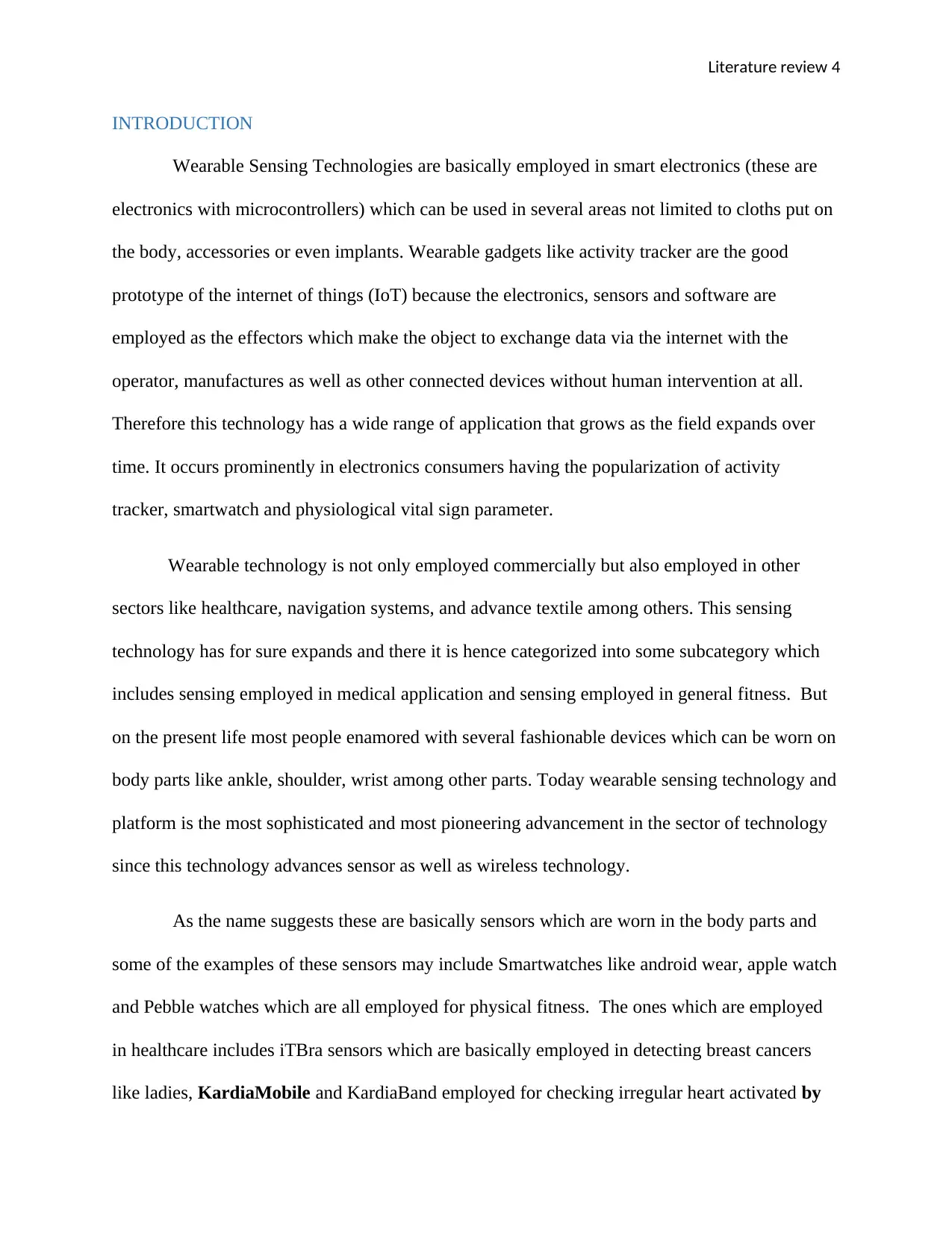
Literature review 4
INTRODUCTION
Wearable Sensing Technologies are basically employed in smart electronics (these are
electronics with microcontrollers) which can be used in several areas not limited to cloths put on
the body, accessories or even implants. Wearable gadgets like activity tracker are the good
prototype of the internet of things (IoT) because the electronics, sensors and software are
employed as the effectors which make the object to exchange data via the internet with the
operator, manufactures as well as other connected devices without human intervention at all.
Therefore this technology has a wide range of application that grows as the field expands over
time. It occurs prominently in electronics consumers having the popularization of activity
tracker, smartwatch and physiological vital sign parameter.
Wearable technology is not only employed commercially but also employed in other
sectors like healthcare, navigation systems, and advance textile among others. This sensing
technology has for sure expands and there it is hence categorized into some subcategory which
includes sensing employed in medical application and sensing employed in general fitness. But
on the present life most people enamored with several fashionable devices which can be worn on
body parts like ankle, shoulder, wrist among other parts. Today wearable sensing technology and
platform is the most sophisticated and most pioneering advancement in the sector of technology
since this technology advances sensor as well as wireless technology.
As the name suggests these are basically sensors which are worn in the body parts and
some of the examples of these sensors may include Smartwatches like android wear, apple watch
and Pebble watches which are all employed for physical fitness. The ones which are employed
in healthcare includes iTBra sensors which are basically employed in detecting breast cancers
like ladies, KardiaMobile and KardiaBand employed for checking irregular heart activated by
INTRODUCTION
Wearable Sensing Technologies are basically employed in smart electronics (these are
electronics with microcontrollers) which can be used in several areas not limited to cloths put on
the body, accessories or even implants. Wearable gadgets like activity tracker are the good
prototype of the internet of things (IoT) because the electronics, sensors and software are
employed as the effectors which make the object to exchange data via the internet with the
operator, manufactures as well as other connected devices without human intervention at all.
Therefore this technology has a wide range of application that grows as the field expands over
time. It occurs prominently in electronics consumers having the popularization of activity
tracker, smartwatch and physiological vital sign parameter.
Wearable technology is not only employed commercially but also employed in other
sectors like healthcare, navigation systems, and advance textile among others. This sensing
technology has for sure expands and there it is hence categorized into some subcategory which
includes sensing employed in medical application and sensing employed in general fitness. But
on the present life most people enamored with several fashionable devices which can be worn on
body parts like ankle, shoulder, wrist among other parts. Today wearable sensing technology and
platform is the most sophisticated and most pioneering advancement in the sector of technology
since this technology advances sensor as well as wireless technology.
As the name suggests these are basically sensors which are worn in the body parts and
some of the examples of these sensors may include Smartwatches like android wear, apple watch
and Pebble watches which are all employed for physical fitness. The ones which are employed
in healthcare includes iTBra sensors which are basically employed in detecting breast cancers
like ladies, KardiaMobile and KardiaBand employed for checking irregular heart activated by
Secure Best Marks with AI Grader
Need help grading? Try our AI Grader for instant feedback on your assignments.

Literature review 5
chaotic electrical signals, Aira which is employed to guide the blind people as they walk around.
Wearable sensing technology is very key in our life today and we will look into some major
wearable sensing technology which is already in place. The major technology will be discussed
under the technology which is used in healthcare as well as those which are used in physical
fitness but this will not be limited to those which are employed for general wellbeing like those
which are employed for earing walking and as well as seeing.
STATE OF ART AND DEVELOPMENT OF WEARABLE SENSORS
By the year 1960, most frontiers of space exploration faced some challenges as the
Apollo space program would actually expose this astronaut to serious weather problems. This
hence created a need to monitor the health of these astronauts while in the space as well as the
moon (Sazonov, 2014). And this could be done through a clouding transmitting of signals from
where they are up to the earth. In some cases, this transmission is referred to as telemetry. The
diagram below illustrates some of the early times during the Apollo astronaut.
Figure 1: Showing wearable sensors for the Apollo Space Program. (Sazonov, 2014)
chaotic electrical signals, Aira which is employed to guide the blind people as they walk around.
Wearable sensing technology is very key in our life today and we will look into some major
wearable sensing technology which is already in place. The major technology will be discussed
under the technology which is used in healthcare as well as those which are used in physical
fitness but this will not be limited to those which are employed for general wellbeing like those
which are employed for earing walking and as well as seeing.
STATE OF ART AND DEVELOPMENT OF WEARABLE SENSORS
By the year 1960, most frontiers of space exploration faced some challenges as the
Apollo space program would actually expose this astronaut to serious weather problems. This
hence created a need to monitor the health of these astronauts while in the space as well as the
moon (Sazonov, 2014). And this could be done through a clouding transmitting of signals from
where they are up to the earth. In some cases, this transmission is referred to as telemetry. The
diagram below illustrates some of the early times during the Apollo astronaut.
Figure 1: Showing wearable sensors for the Apollo Space Program. (Sazonov, 2014)
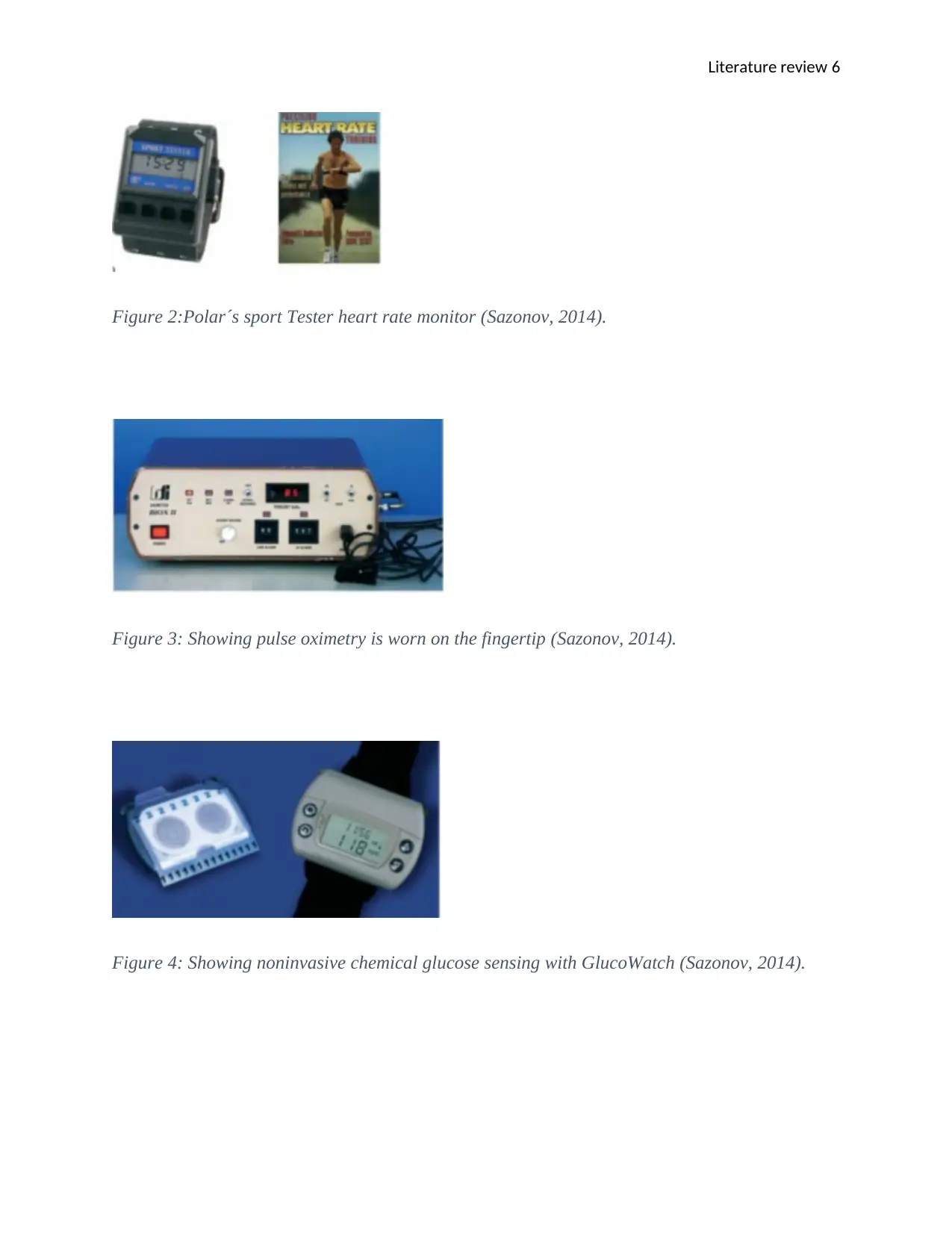
Literature review 6
Figure 2:Polar´s sport Tester heart rate monitor (Sazonov, 2014).
Figure 3: Showing pulse oximetry is worn on the fingertip (Sazonov, 2014).
Figure 4: Showing noninvasive chemical glucose sensing with GlucoWatch (Sazonov, 2014).
Figure 2:Polar´s sport Tester heart rate monitor (Sazonov, 2014).
Figure 3: Showing pulse oximetry is worn on the fingertip (Sazonov, 2014).
Figure 4: Showing noninvasive chemical glucose sensing with GlucoWatch (Sazonov, 2014).
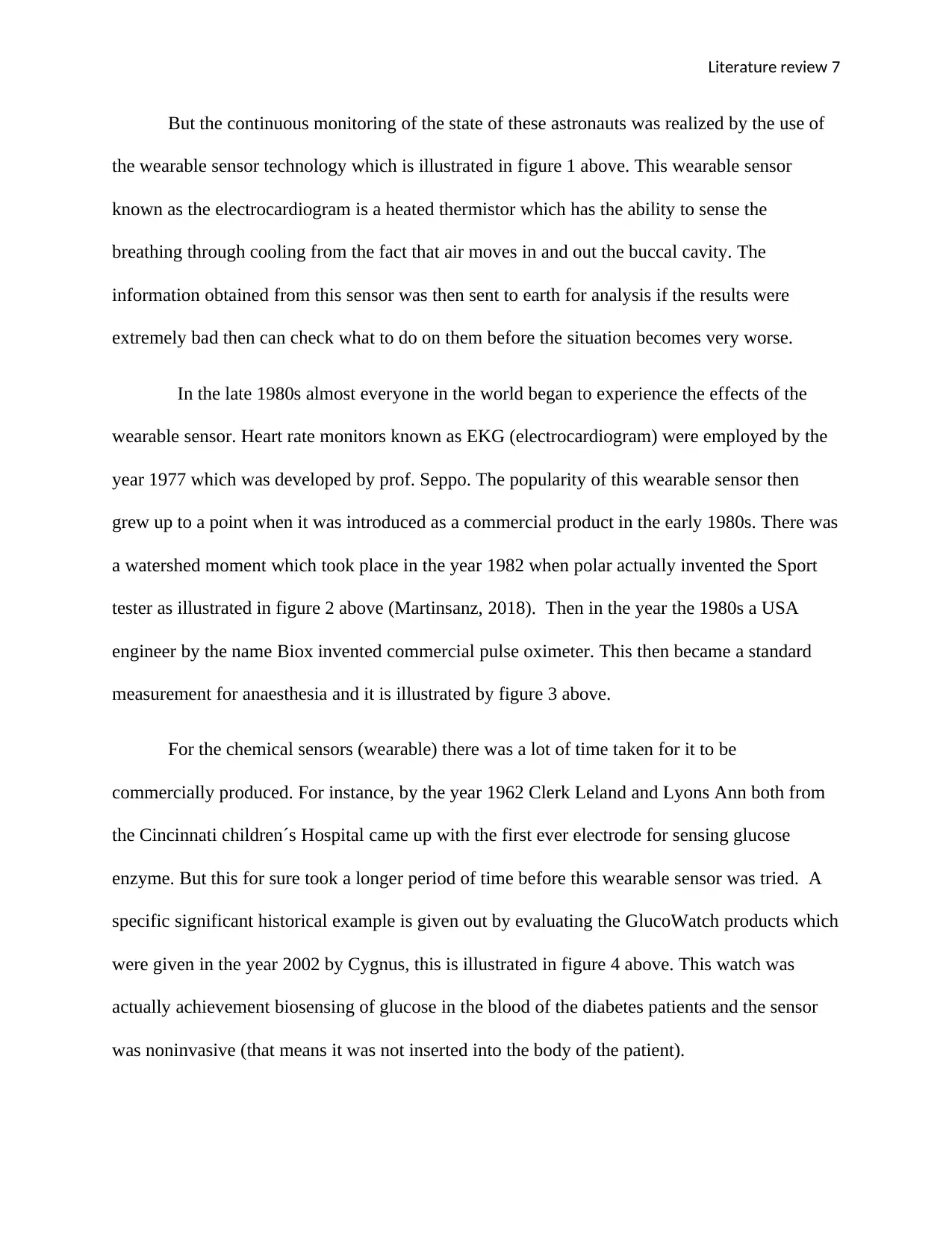
Literature review 7
But the continuous monitoring of the state of these astronauts was realized by the use of
the wearable sensor technology which is illustrated in figure 1 above. This wearable sensor
known as the electrocardiogram is a heated thermistor which has the ability to sense the
breathing through cooling from the fact that air moves in and out the buccal cavity. The
information obtained from this sensor was then sent to earth for analysis if the results were
extremely bad then can check what to do on them before the situation becomes very worse.
In the late 1980s almost everyone in the world began to experience the effects of the
wearable sensor. Heart rate monitors known as EKG (electrocardiogram) were employed by the
year 1977 which was developed by prof. Seppo. The popularity of this wearable sensor then
grew up to a point when it was introduced as a commercial product in the early 1980s. There was
a watershed moment which took place in the year 1982 when polar actually invented the Sport
tester as illustrated in figure 2 above (Martinsanz, 2018). Then in the year the 1980s a USA
engineer by the name Biox invented commercial pulse oximeter. This then became a standard
measurement for anaesthesia and it is illustrated by figure 3 above.
For the chemical sensors (wearable) there was a lot of time taken for it to be
commercially produced. For instance, by the year 1962 Clerk Leland and Lyons Ann both from
the Cincinnati children´s Hospital came up with the first ever electrode for sensing glucose
enzyme. But this for sure took a longer period of time before this wearable sensor was tried. A
specific significant historical example is given out by evaluating the GlucoWatch products which
were given in the year 2002 by Cygnus, this is illustrated in figure 4 above. This watch was
actually achievement biosensing of glucose in the blood of the diabetes patients and the sensor
was noninvasive (that means it was not inserted into the body of the patient).
But the continuous monitoring of the state of these astronauts was realized by the use of
the wearable sensor technology which is illustrated in figure 1 above. This wearable sensor
known as the electrocardiogram is a heated thermistor which has the ability to sense the
breathing through cooling from the fact that air moves in and out the buccal cavity. The
information obtained from this sensor was then sent to earth for analysis if the results were
extremely bad then can check what to do on them before the situation becomes very worse.
In the late 1980s almost everyone in the world began to experience the effects of the
wearable sensor. Heart rate monitors known as EKG (electrocardiogram) were employed by the
year 1977 which was developed by prof. Seppo. The popularity of this wearable sensor then
grew up to a point when it was introduced as a commercial product in the early 1980s. There was
a watershed moment which took place in the year 1982 when polar actually invented the Sport
tester as illustrated in figure 2 above (Martinsanz, 2018). Then in the year the 1980s a USA
engineer by the name Biox invented commercial pulse oximeter. This then became a standard
measurement for anaesthesia and it is illustrated by figure 3 above.
For the chemical sensors (wearable) there was a lot of time taken for it to be
commercially produced. For instance, by the year 1962 Clerk Leland and Lyons Ann both from
the Cincinnati children´s Hospital came up with the first ever electrode for sensing glucose
enzyme. But this for sure took a longer period of time before this wearable sensor was tried. A
specific significant historical example is given out by evaluating the GlucoWatch products which
were given in the year 2002 by Cygnus, this is illustrated in figure 4 above. This watch was
actually achievement biosensing of glucose in the blood of the diabetes patients and the sensor
was noninvasive (that means it was not inserted into the body of the patient).
Paraphrase This Document
Need a fresh take? Get an instant paraphrase of this document with our AI Paraphraser
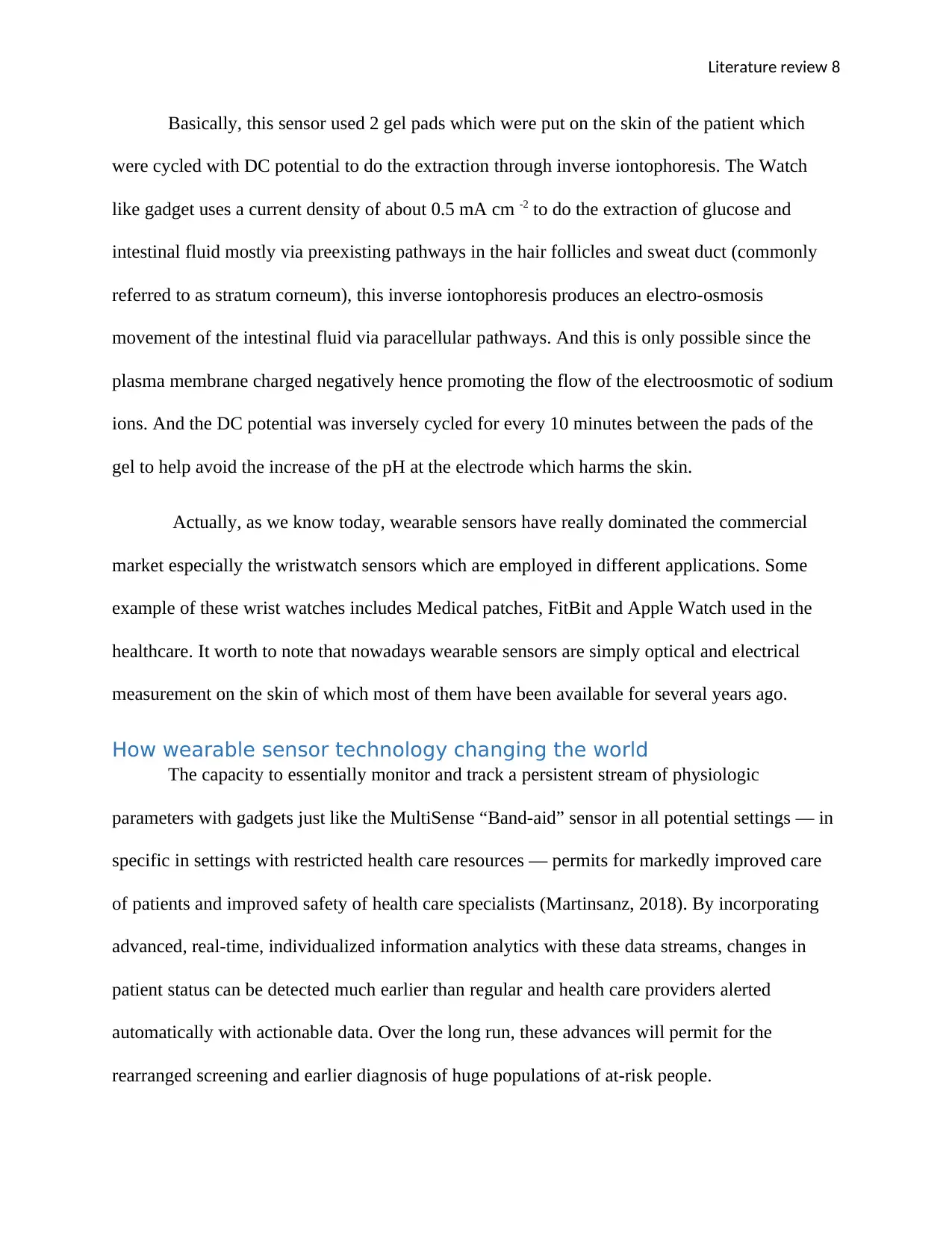
Literature review 8
Basically, this sensor used 2 gel pads which were put on the skin of the patient which
were cycled with DC potential to do the extraction through inverse iontophoresis. The Watch
like gadget uses a current density of about 0.5 mA cm -2 to do the extraction of glucose and
intestinal fluid mostly via preexisting pathways in the hair follicles and sweat duct (commonly
referred to as stratum corneum), this inverse iontophoresis produces an electro-osmosis
movement of the intestinal fluid via paracellular pathways. And this is only possible since the
plasma membrane charged negatively hence promoting the flow of the electroosmotic of sodium
ions. And the DC potential was inversely cycled for every 10 minutes between the pads of the
gel to help avoid the increase of the pH at the electrode which harms the skin.
Actually, as we know today, wearable sensors have really dominated the commercial
market especially the wristwatch sensors which are employed in different applications. Some
example of these wrist watches includes Medical patches, FitBit and Apple Watch used in the
healthcare. It worth to note that nowadays wearable sensors are simply optical and electrical
measurement on the skin of which most of them have been available for several years ago.
How wearable sensor technology changing the world
The capacity to essentially monitor and track a persistent stream of physiologic
parameters with gadgets just like the MultiSense “Band-aid” sensor in all potential settings — in
specific in settings with restricted health care resources — permits for markedly improved care
of patients and improved safety of health care specialists (Martinsanz, 2018). By incorporating
advanced, real-time, individualized information analytics with these data streams, changes in
patient status can be detected much earlier than regular and health care providers alerted
automatically with actionable data. Over the long run, these advances will permit for the
rearranged screening and earlier diagnosis of huge populations of at-risk people.
Basically, this sensor used 2 gel pads which were put on the skin of the patient which
were cycled with DC potential to do the extraction through inverse iontophoresis. The Watch
like gadget uses a current density of about 0.5 mA cm -2 to do the extraction of glucose and
intestinal fluid mostly via preexisting pathways in the hair follicles and sweat duct (commonly
referred to as stratum corneum), this inverse iontophoresis produces an electro-osmosis
movement of the intestinal fluid via paracellular pathways. And this is only possible since the
plasma membrane charged negatively hence promoting the flow of the electroosmotic of sodium
ions. And the DC potential was inversely cycled for every 10 minutes between the pads of the
gel to help avoid the increase of the pH at the electrode which harms the skin.
Actually, as we know today, wearable sensors have really dominated the commercial
market especially the wristwatch sensors which are employed in different applications. Some
example of these wrist watches includes Medical patches, FitBit and Apple Watch used in the
healthcare. It worth to note that nowadays wearable sensors are simply optical and electrical
measurement on the skin of which most of them have been available for several years ago.
How wearable sensor technology changing the world
The capacity to essentially monitor and track a persistent stream of physiologic
parameters with gadgets just like the MultiSense “Band-aid” sensor in all potential settings — in
specific in settings with restricted health care resources — permits for markedly improved care
of patients and improved safety of health care specialists (Martinsanz, 2018). By incorporating
advanced, real-time, individualized information analytics with these data streams, changes in
patient status can be detected much earlier than regular and health care providers alerted
automatically with actionable data. Over the long run, these advances will permit for the
rearranged screening and earlier diagnosis of huge populations of at-risk people.
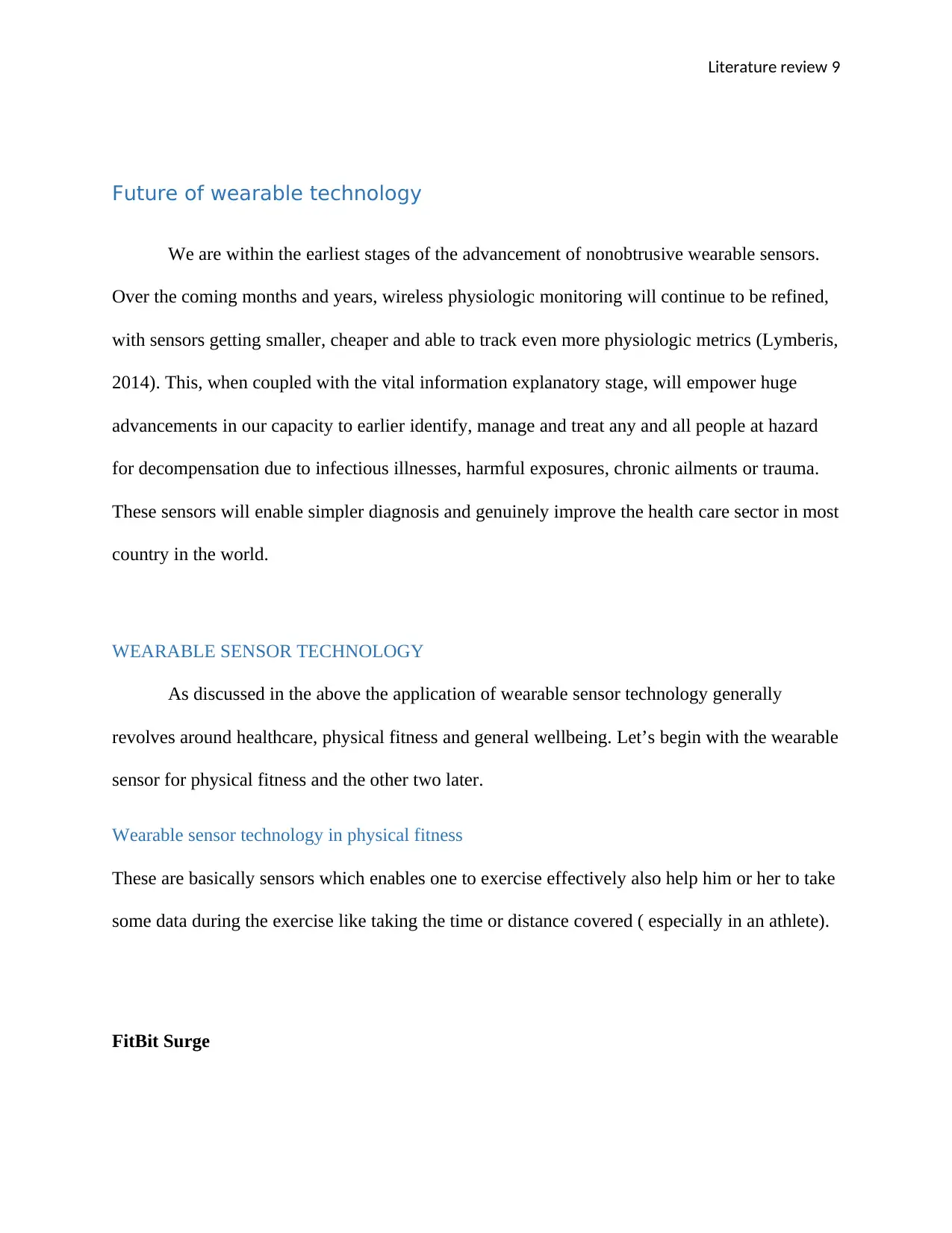
Literature review 9
Future of wearable technology
We are within the earliest stages of the advancement of nonobtrusive wearable sensors.
Over the coming months and years, wireless physiologic monitoring will continue to be refined,
with sensors getting smaller, cheaper and able to track even more physiologic metrics (Lymberis,
2014). This, when coupled with the vital information explanatory stage, will empower huge
advancements in our capacity to earlier identify, manage and treat any and all people at hazard
for decompensation due to infectious illnesses, harmful exposures, chronic ailments or trauma.
These sensors will enable simpler diagnosis and genuinely improve the health care sector in most
country in the world.
WEARABLE SENSOR TECHNOLOGY
As discussed in the above the application of wearable sensor technology generally
revolves around healthcare, physical fitness and general wellbeing. Let’s begin with the wearable
sensor for physical fitness and the other two later.
Wearable sensor technology in physical fitness
These are basically sensors which enables one to exercise effectively also help him or her to take
some data during the exercise like taking the time or distance covered ( especially in an athlete).
FitBit Surge
Future of wearable technology
We are within the earliest stages of the advancement of nonobtrusive wearable sensors.
Over the coming months and years, wireless physiologic monitoring will continue to be refined,
with sensors getting smaller, cheaper and able to track even more physiologic metrics (Lymberis,
2014). This, when coupled with the vital information explanatory stage, will empower huge
advancements in our capacity to earlier identify, manage and treat any and all people at hazard
for decompensation due to infectious illnesses, harmful exposures, chronic ailments or trauma.
These sensors will enable simpler diagnosis and genuinely improve the health care sector in most
country in the world.
WEARABLE SENSOR TECHNOLOGY
As discussed in the above the application of wearable sensor technology generally
revolves around healthcare, physical fitness and general wellbeing. Let’s begin with the wearable
sensor for physical fitness and the other two later.
Wearable sensor technology in physical fitness
These are basically sensors which enables one to exercise effectively also help him or her to take
some data during the exercise like taking the time or distance covered ( especially in an athlete).
FitBit Surge
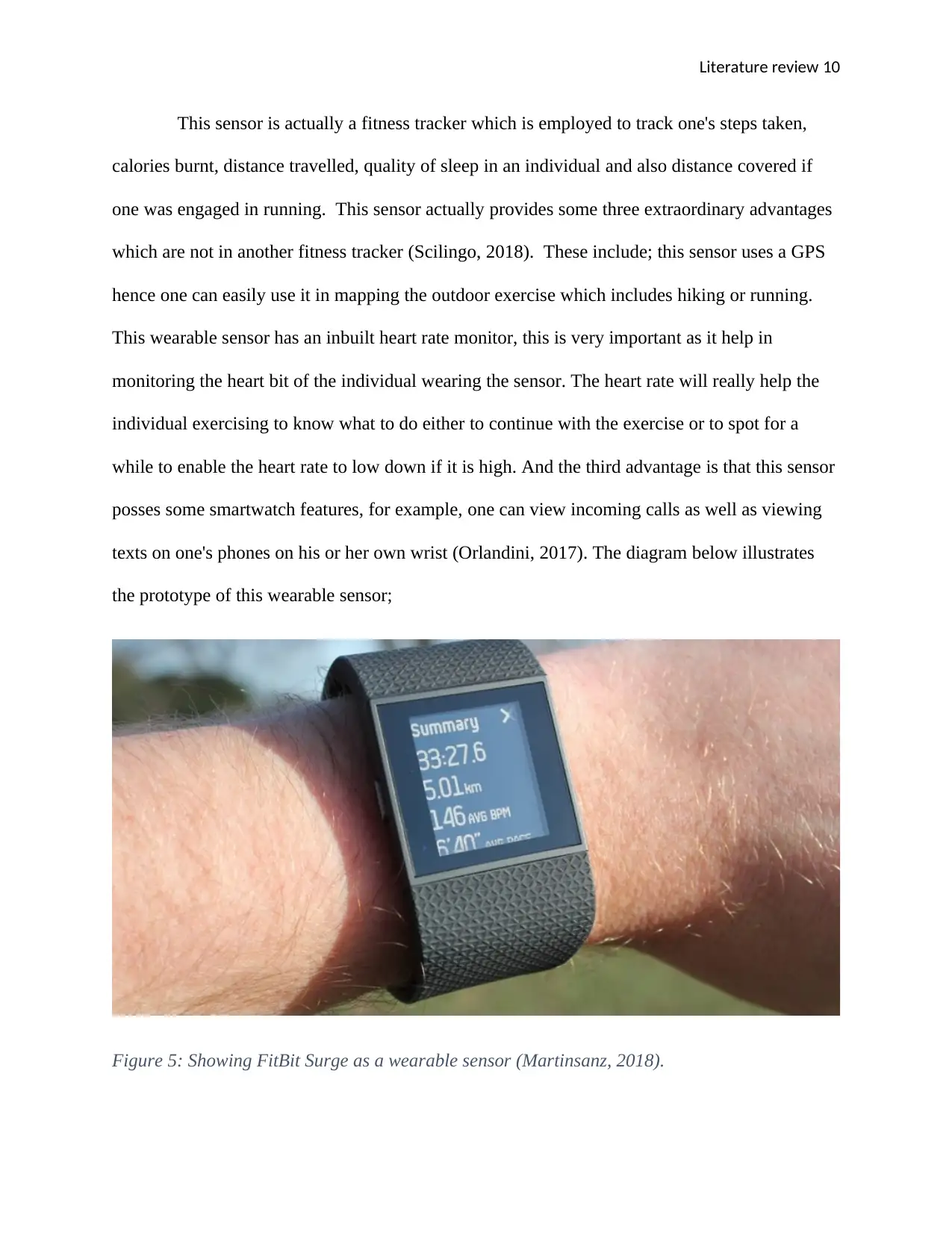
Literature review 10
This sensor is actually a fitness tracker which is employed to track one's steps taken,
calories burnt, distance travelled, quality of sleep in an individual and also distance covered if
one was engaged in running. This sensor actually provides some three extraordinary advantages
which are not in another fitness tracker (Scilingo, 2018). These include; this sensor uses a GPS
hence one can easily use it in mapping the outdoor exercise which includes hiking or running.
This wearable sensor has an inbuilt heart rate monitor, this is very important as it help in
monitoring the heart bit of the individual wearing the sensor. The heart rate will really help the
individual exercising to know what to do either to continue with the exercise or to spot for a
while to enable the heart rate to low down if it is high. And the third advantage is that this sensor
posses some smartwatch features, for example, one can view incoming calls as well as viewing
texts on one's phones on his or her own wrist (Orlandini, 2017). The diagram below illustrates
the prototype of this wearable sensor;
Figure 5: Showing FitBit Surge as a wearable sensor (Martinsanz, 2018).
This sensor is actually a fitness tracker which is employed to track one's steps taken,
calories burnt, distance travelled, quality of sleep in an individual and also distance covered if
one was engaged in running. This sensor actually provides some three extraordinary advantages
which are not in another fitness tracker (Scilingo, 2018). These include; this sensor uses a GPS
hence one can easily use it in mapping the outdoor exercise which includes hiking or running.
This wearable sensor has an inbuilt heart rate monitor, this is very important as it help in
monitoring the heart bit of the individual wearing the sensor. The heart rate will really help the
individual exercising to know what to do either to continue with the exercise or to spot for a
while to enable the heart rate to low down if it is high. And the third advantage is that this sensor
posses some smartwatch features, for example, one can view incoming calls as well as viewing
texts on one's phones on his or her own wrist (Orlandini, 2017). The diagram below illustrates
the prototype of this wearable sensor;
Figure 5: Showing FitBit Surge as a wearable sensor (Martinsanz, 2018).
Secure Best Marks with AI Grader
Need help grading? Try our AI Grader for instant feedback on your assignments.
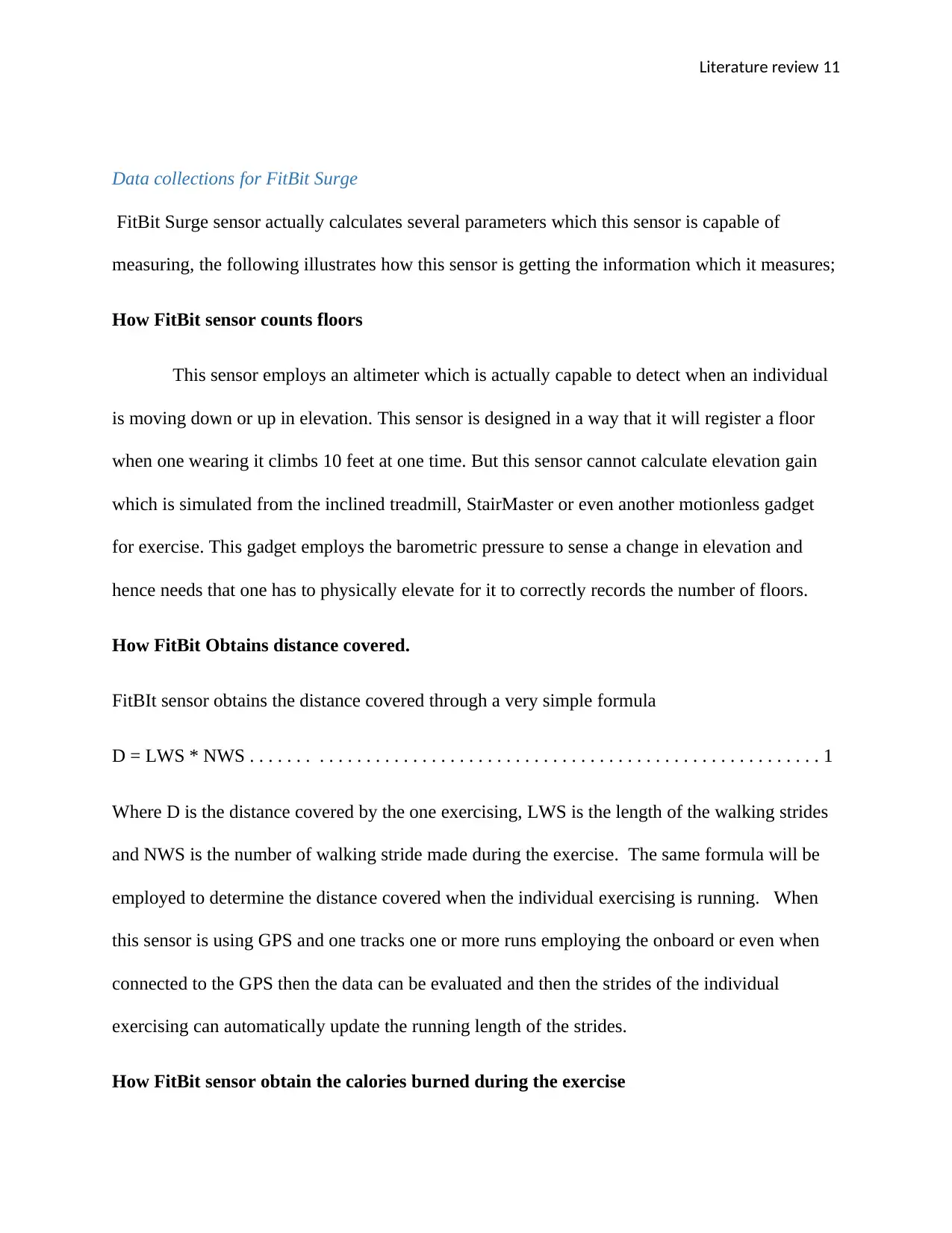
Literature review 11
Data collections for FitBit Surge
FitBit Surge sensor actually calculates several parameters which this sensor is capable of
measuring, the following illustrates how this sensor is getting the information which it measures;
How FitBit sensor counts floors
This sensor employs an altimeter which is actually capable to detect when an individual
is moving down or up in elevation. This sensor is designed in a way that it will register a floor
when one wearing it climbs 10 feet at one time. But this sensor cannot calculate elevation gain
which is simulated from the inclined treadmill, StairMaster or even another motionless gadget
for exercise. This gadget employs the barometric pressure to sense a change in elevation and
hence needs that one has to physically elevate for it to correctly records the number of floors.
How FitBit Obtains distance covered.
FitBIt sensor obtains the distance covered through a very simple formula
D = LWS * NWS . . . . . . . . . . . . . . . . . . . . . . . . . . . . . . . . . . . . . . . . . . . . . . . . . . . . . . . . . . . . . 1
Where D is the distance covered by the one exercising, LWS is the length of the walking strides
and NWS is the number of walking stride made during the exercise. The same formula will be
employed to determine the distance covered when the individual exercising is running. When
this sensor is using GPS and one tracks one or more runs employing the onboard or even when
connected to the GPS then the data can be evaluated and then the strides of the individual
exercising can automatically update the running length of the strides.
How FitBit sensor obtain the calories burned during the exercise
Data collections for FitBit Surge
FitBit Surge sensor actually calculates several parameters which this sensor is capable of
measuring, the following illustrates how this sensor is getting the information which it measures;
How FitBit sensor counts floors
This sensor employs an altimeter which is actually capable to detect when an individual
is moving down or up in elevation. This sensor is designed in a way that it will register a floor
when one wearing it climbs 10 feet at one time. But this sensor cannot calculate elevation gain
which is simulated from the inclined treadmill, StairMaster or even another motionless gadget
for exercise. This gadget employs the barometric pressure to sense a change in elevation and
hence needs that one has to physically elevate for it to correctly records the number of floors.
How FitBit Obtains distance covered.
FitBIt sensor obtains the distance covered through a very simple formula
D = LWS * NWS . . . . . . . . . . . . . . . . . . . . . . . . . . . . . . . . . . . . . . . . . . . . . . . . . . . . . . . . . . . . . 1
Where D is the distance covered by the one exercising, LWS is the length of the walking strides
and NWS is the number of walking stride made during the exercise. The same formula will be
employed to determine the distance covered when the individual exercising is running. When
this sensor is using GPS and one tracks one or more runs employing the onboard or even when
connected to the GPS then the data can be evaluated and then the strides of the individual
exercising can automatically update the running length of the strides.
How FitBit sensor obtain the calories burned during the exercise
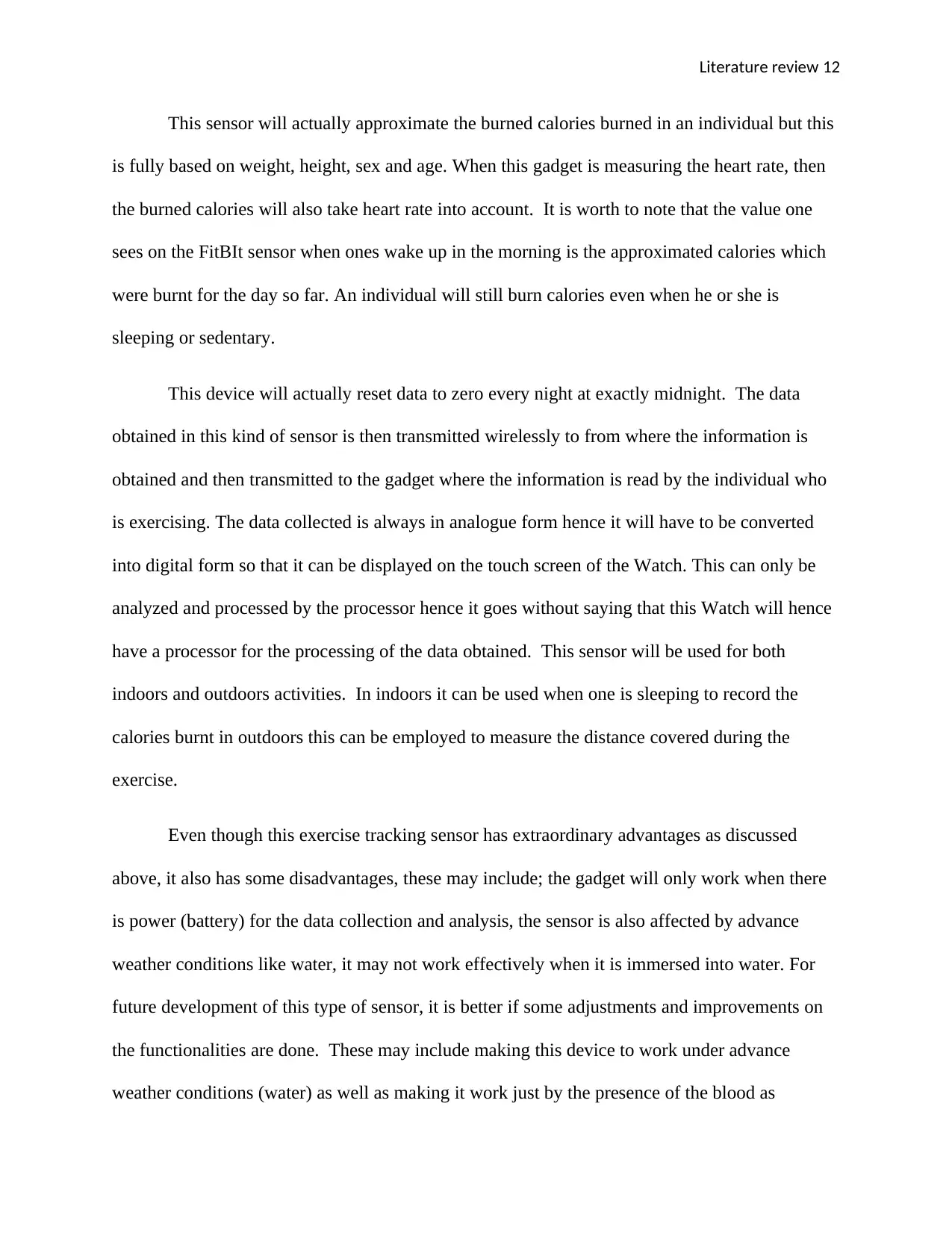
Literature review 12
This sensor will actually approximate the burned calories burned in an individual but this
is fully based on weight, height, sex and age. When this gadget is measuring the heart rate, then
the burned calories will also take heart rate into account. It is worth to note that the value one
sees on the FitBIt sensor when ones wake up in the morning is the approximated calories which
were burnt for the day so far. An individual will still burn calories even when he or she is
sleeping or sedentary.
This device will actually reset data to zero every night at exactly midnight. The data
obtained in this kind of sensor is then transmitted wirelessly to from where the information is
obtained and then transmitted to the gadget where the information is read by the individual who
is exercising. The data collected is always in analogue form hence it will have to be converted
into digital form so that it can be displayed on the touch screen of the Watch. This can only be
analyzed and processed by the processor hence it goes without saying that this Watch will hence
have a processor for the processing of the data obtained. This sensor will be used for both
indoors and outdoors activities. In indoors it can be used when one is sleeping to record the
calories burnt in outdoors this can be employed to measure the distance covered during the
exercise.
Even though this exercise tracking sensor has extraordinary advantages as discussed
above, it also has some disadvantages, these may include; the gadget will only work when there
is power (battery) for the data collection and analysis, the sensor is also affected by advance
weather conditions like water, it may not work effectively when it is immersed into water. For
future development of this type of sensor, it is better if some adjustments and improvements on
the functionalities are done. These may include making this device to work under advance
weather conditions (water) as well as making it work just by the presence of the blood as
This sensor will actually approximate the burned calories burned in an individual but this
is fully based on weight, height, sex and age. When this gadget is measuring the heart rate, then
the burned calories will also take heart rate into account. It is worth to note that the value one
sees on the FitBIt sensor when ones wake up in the morning is the approximated calories which
were burnt for the day so far. An individual will still burn calories even when he or she is
sleeping or sedentary.
This device will actually reset data to zero every night at exactly midnight. The data
obtained in this kind of sensor is then transmitted wirelessly to from where the information is
obtained and then transmitted to the gadget where the information is read by the individual who
is exercising. The data collected is always in analogue form hence it will have to be converted
into digital form so that it can be displayed on the touch screen of the Watch. This can only be
analyzed and processed by the processor hence it goes without saying that this Watch will hence
have a processor for the processing of the data obtained. This sensor will be used for both
indoors and outdoors activities. In indoors it can be used when one is sleeping to record the
calories burnt in outdoors this can be employed to measure the distance covered during the
exercise.
Even though this exercise tracking sensor has extraordinary advantages as discussed
above, it also has some disadvantages, these may include; the gadget will only work when there
is power (battery) for the data collection and analysis, the sensor is also affected by advance
weather conditions like water, it may not work effectively when it is immersed into water. For
future development of this type of sensor, it is better if some adjustments and improvements on
the functionalities are done. These may include making this device to work under advance
weather conditions (water) as well as making it work just by the presence of the blood as
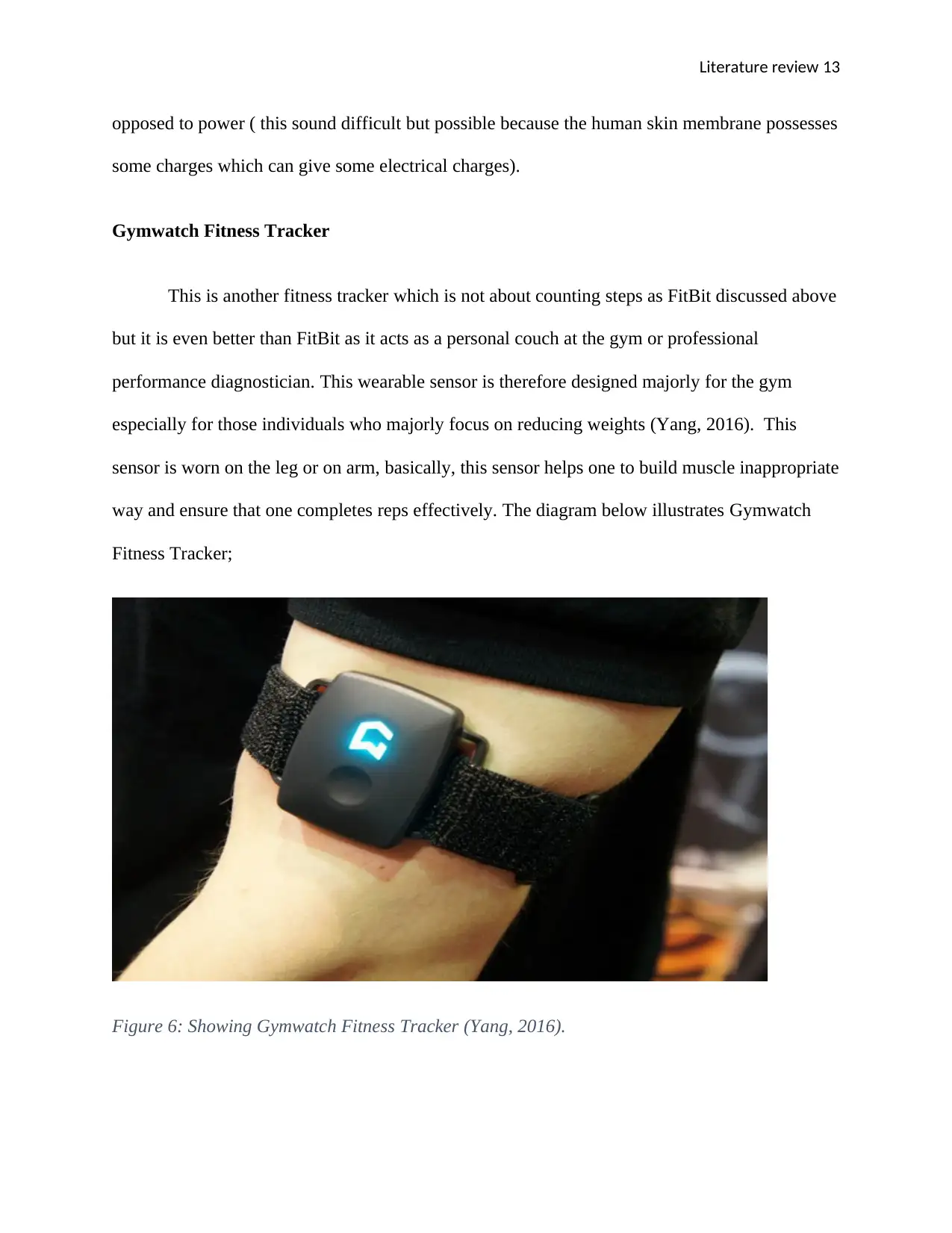
Literature review 13
opposed to power ( this sound difficult but possible because the human skin membrane possesses
some charges which can give some electrical charges).
Gymwatch Fitness Tracker
This is another fitness tracker which is not about counting steps as FitBit discussed above
but it is even better than FitBit as it acts as a personal couch at the gym or professional
performance diagnostician. This wearable sensor is therefore designed majorly for the gym
especially for those individuals who majorly focus on reducing weights (Yang, 2016). This
sensor is worn on the leg or on arm, basically, this sensor helps one to build muscle inappropriate
way and ensure that one completes reps effectively. The diagram below illustrates Gymwatch
Fitness Tracker;
Figure 6: Showing Gymwatch Fitness Tracker (Yang, 2016).
opposed to power ( this sound difficult but possible because the human skin membrane possesses
some charges which can give some electrical charges).
Gymwatch Fitness Tracker
This is another fitness tracker which is not about counting steps as FitBit discussed above
but it is even better than FitBit as it acts as a personal couch at the gym or professional
performance diagnostician. This wearable sensor is therefore designed majorly for the gym
especially for those individuals who majorly focus on reducing weights (Yang, 2016). This
sensor is worn on the leg or on arm, basically, this sensor helps one to build muscle inappropriate
way and ensure that one completes reps effectively. The diagram below illustrates Gymwatch
Fitness Tracker;
Figure 6: Showing Gymwatch Fitness Tracker (Yang, 2016).
Paraphrase This Document
Need a fresh take? Get an instant paraphrase of this document with our AI Paraphraser

Literature review 14
This sensor is capable to track regimes like cardio, strength, weight lifting among another
exercise one can do at home.
Data recorded by GymWatch
This device is able to record some fitness information during a workout. It also helps in a
workout with the help of earpiece that will alert one when he or she is doing exercise in a wrong
way. This sensor will as well alert one about the correct amount of weight he or he needs to carry
depending on his or her BMI. The gadget will as well help one on the speed or force of every
workout in detail by the help of earplug (Mähönen, 2010). The earplug is connected to the
Gymwatch Fitness Tracker by the use of a Bluetooth (wireless communication. Gymwatch
Fitness Tracker hence records workout data like speed strength, starting strength applied, muscle
strength. This sensor can as well be employed to determine distance, step counts, steps length,
step duration and stroke rate.
The working principle of Gymwatch
This gadget is composed of several sensors such as Gyroscope, Accelerometer and
Magnetometer that operates in tandem to trace and then record one´s limbs movements in every
axes to provide very accurate information. This hence operates by the operator enters his or her
height, weight into the gadget and then it calculates the information and let the one know the
exact weight that can be employed to work out without overloading one´s workout.
Features of the GymWatch
The sensor location is very vital depending on the kind of exercise one is doing, when
one is doing upper body or arm exercise then he or she needs to wear the sensor on his or her
arm and not his or her leg. But when one is doing a lower body exercise then he or she should
wear the sensor on the leg and not on the arm. During the workout injuries may occur hence this
This sensor is capable to track regimes like cardio, strength, weight lifting among another
exercise one can do at home.
Data recorded by GymWatch
This device is able to record some fitness information during a workout. It also helps in a
workout with the help of earpiece that will alert one when he or she is doing exercise in a wrong
way. This sensor will as well alert one about the correct amount of weight he or he needs to carry
depending on his or her BMI. The gadget will as well help one on the speed or force of every
workout in detail by the help of earplug (Mähönen, 2010). The earplug is connected to the
Gymwatch Fitness Tracker by the use of a Bluetooth (wireless communication. Gymwatch
Fitness Tracker hence records workout data like speed strength, starting strength applied, muscle
strength. This sensor can as well be employed to determine distance, step counts, steps length,
step duration and stroke rate.
The working principle of Gymwatch
This gadget is composed of several sensors such as Gyroscope, Accelerometer and
Magnetometer that operates in tandem to trace and then record one´s limbs movements in every
axes to provide very accurate information. This hence operates by the operator enters his or her
height, weight into the gadget and then it calculates the information and let the one know the
exact weight that can be employed to work out without overloading one´s workout.
Features of the GymWatch
The sensor location is very vital depending on the kind of exercise one is doing, when
one is doing upper body or arm exercise then he or she needs to wear the sensor on his or her
arm and not his or her leg. But when one is doing a lower body exercise then he or she should
wear the sensor on the leg and not on the arm. During the workout injuries may occur hence this
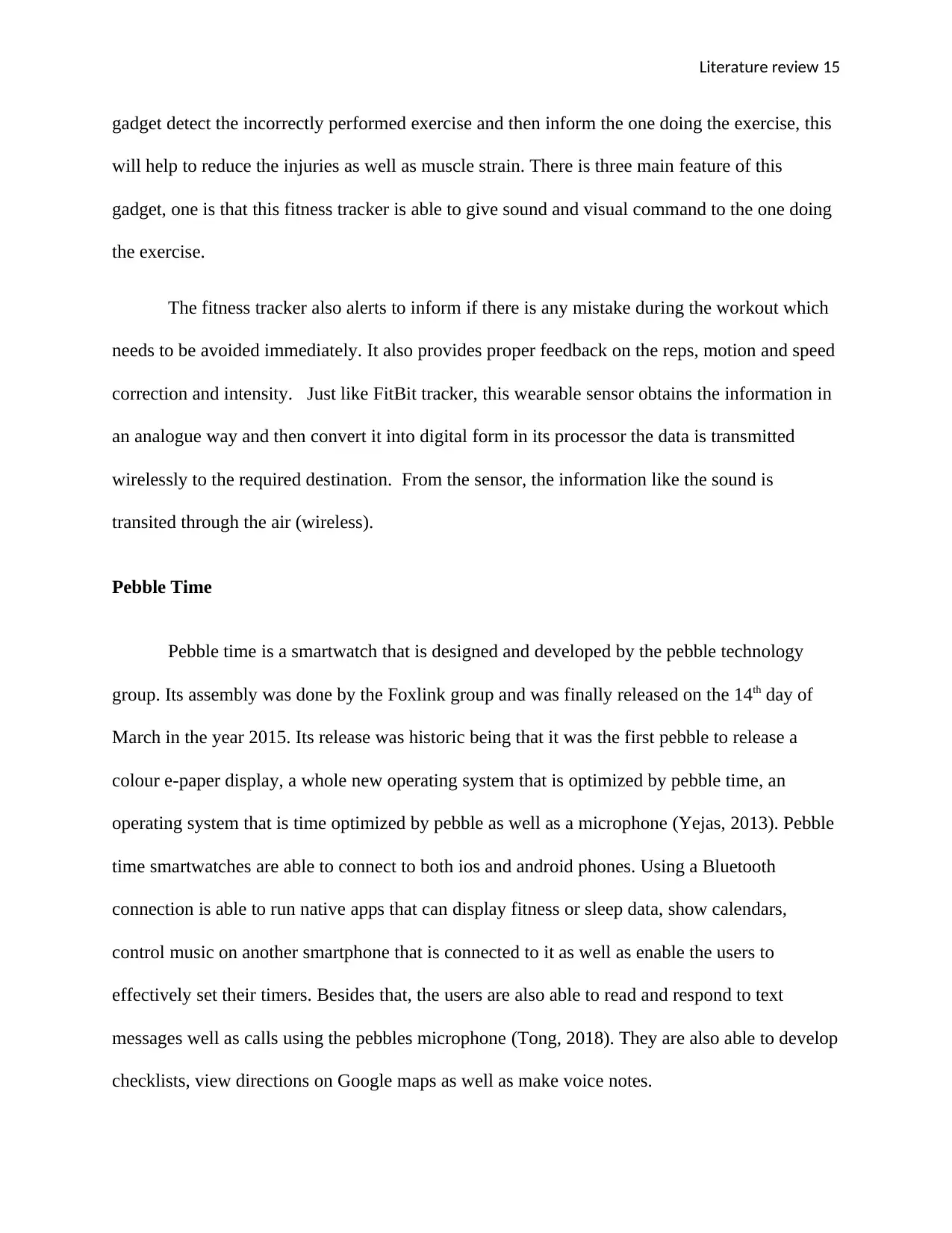
Literature review 15
gadget detect the incorrectly performed exercise and then inform the one doing the exercise, this
will help to reduce the injuries as well as muscle strain. There is three main feature of this
gadget, one is that this fitness tracker is able to give sound and visual command to the one doing
the exercise.
The fitness tracker also alerts to inform if there is any mistake during the workout which
needs to be avoided immediately. It also provides proper feedback on the reps, motion and speed
correction and intensity. Just like FitBit tracker, this wearable sensor obtains the information in
an analogue way and then convert it into digital form in its processor the data is transmitted
wirelessly to the required destination. From the sensor, the information like the sound is
transited through the air (wireless).
Pebble Time
Pebble time is a smartwatch that is designed and developed by the pebble technology
group. Its assembly was done by the Foxlink group and was finally released on the 14th day of
March in the year 2015. Its release was historic being that it was the first pebble to release a
colour e-paper display, a whole new operating system that is optimized by pebble time, an
operating system that is time optimized by pebble as well as a microphone (Yejas, 2013). Pebble
time smartwatches are able to connect to both ios and android phones. Using a Bluetooth
connection is able to run native apps that can display fitness or sleep data, show calendars,
control music on another smartphone that is connected to it as well as enable the users to
effectively set their timers. Besides that, the users are also able to read and respond to text
messages well as calls using the pebbles microphone (Tong, 2018). They are also able to develop
checklists, view directions on Google maps as well as make voice notes.
gadget detect the incorrectly performed exercise and then inform the one doing the exercise, this
will help to reduce the injuries as well as muscle strain. There is three main feature of this
gadget, one is that this fitness tracker is able to give sound and visual command to the one doing
the exercise.
The fitness tracker also alerts to inform if there is any mistake during the workout which
needs to be avoided immediately. It also provides proper feedback on the reps, motion and speed
correction and intensity. Just like FitBit tracker, this wearable sensor obtains the information in
an analogue way and then convert it into digital form in its processor the data is transmitted
wirelessly to the required destination. From the sensor, the information like the sound is
transited through the air (wireless).
Pebble Time
Pebble time is a smartwatch that is designed and developed by the pebble technology
group. Its assembly was done by the Foxlink group and was finally released on the 14th day of
March in the year 2015. Its release was historic being that it was the first pebble to release a
colour e-paper display, a whole new operating system that is optimized by pebble time, an
operating system that is time optimized by pebble as well as a microphone (Yejas, 2013). Pebble
time smartwatches are able to connect to both ios and android phones. Using a Bluetooth
connection is able to run native apps that can display fitness or sleep data, show calendars,
control music on another smartphone that is connected to it as well as enable the users to
effectively set their timers. Besides that, the users are also able to read and respond to text
messages well as calls using the pebbles microphone (Tong, 2018). They are also able to develop
checklists, view directions on Google maps as well as make voice notes.

Literature review 16
The smartwatch comes with a new operating system known as the timeline. This implies
that the interface of this pebble time smartwatch is mainly based on the concept of time. All the
users' notifications, news, events and reminders are well put up in chronological order (Xu,
2012). Records of items from the previous day such as the total step count from the pedometer
readings installed in the phone can be easily viewed as well as both the weather of the previous
day and a forecast of the same. This timeline interface, therefore, enables the user to have his or
her events as well as app notifications easily accessible, in chronological order as well as
reducing the need to access app whenever the user requires information. Pebble time can be
illustrated using the following diagram;
Figure 7: Showing Pebble Time Smartwatch (Xu, 2012).
The smartwatch comes with a new operating system known as the timeline. This implies
that the interface of this pebble time smartwatch is mainly based on the concept of time. All the
users' notifications, news, events and reminders are well put up in chronological order (Xu,
2012). Records of items from the previous day such as the total step count from the pedometer
readings installed in the phone can be easily viewed as well as both the weather of the previous
day and a forecast of the same. This timeline interface, therefore, enables the user to have his or
her events as well as app notifications easily accessible, in chronological order as well as
reducing the need to access app whenever the user requires information. Pebble time can be
illustrated using the following diagram;
Figure 7: Showing Pebble Time Smartwatch (Xu, 2012).
Secure Best Marks with AI Grader
Need help grading? Try our AI Grader for instant feedback on your assignments.
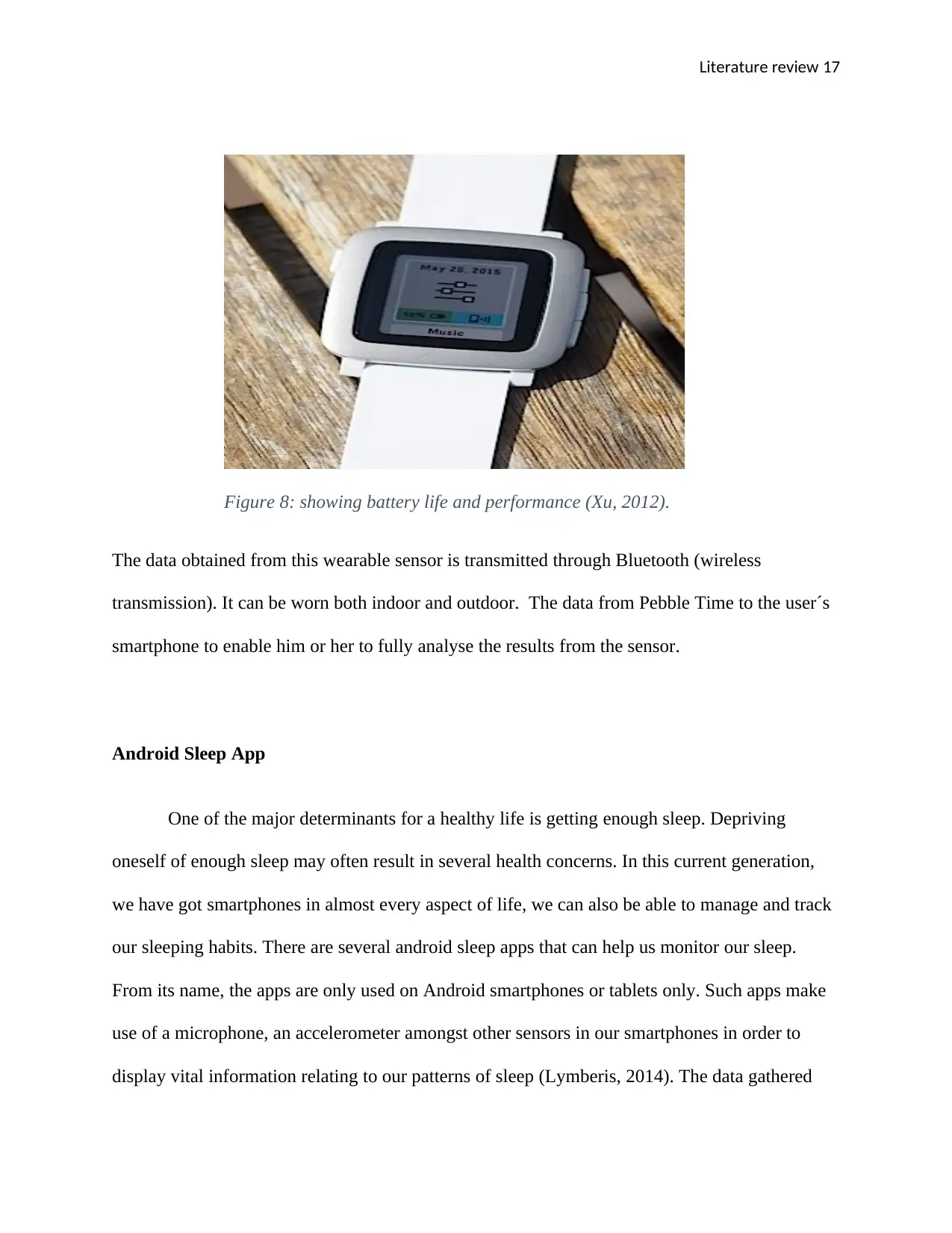
Literature review 17
Figure 8: showing battery life and performance (Xu, 2012).
The data obtained from this wearable sensor is transmitted through Bluetooth (wireless
transmission). It can be worn both indoor and outdoor. The data from Pebble Time to the user´s
smartphone to enable him or her to fully analyse the results from the sensor.
Android Sleep App
One of the major determinants for a healthy life is getting enough sleep. Depriving
oneself of enough sleep may often result in several health concerns. In this current generation,
we have got smartphones in almost every aspect of life, we can also be able to manage and track
our sleeping habits. There are several android sleep apps that can help us monitor our sleep.
From its name, the apps are only used on Android smartphones or tablets only. Such apps make
use of a microphone, an accelerometer amongst other sensors in our smartphones in order to
display vital information relating to our patterns of sleep (Lymberis, 2014). The data gathered
Figure 8: showing battery life and performance (Xu, 2012).
The data obtained from this wearable sensor is transmitted through Bluetooth (wireless
transmission). It can be worn both indoor and outdoor. The data from Pebble Time to the user´s
smartphone to enable him or her to fully analyse the results from the sensor.
Android Sleep App
One of the major determinants for a healthy life is getting enough sleep. Depriving
oneself of enough sleep may often result in several health concerns. In this current generation,
we have got smartphones in almost every aspect of life, we can also be able to manage and track
our sleeping habits. There are several android sleep apps that can help us monitor our sleep.
From its name, the apps are only used on Android smartphones or tablets only. Such apps make
use of a microphone, an accelerometer amongst other sensors in our smartphones in order to
display vital information relating to our patterns of sleep (Lymberis, 2014). The data gathered
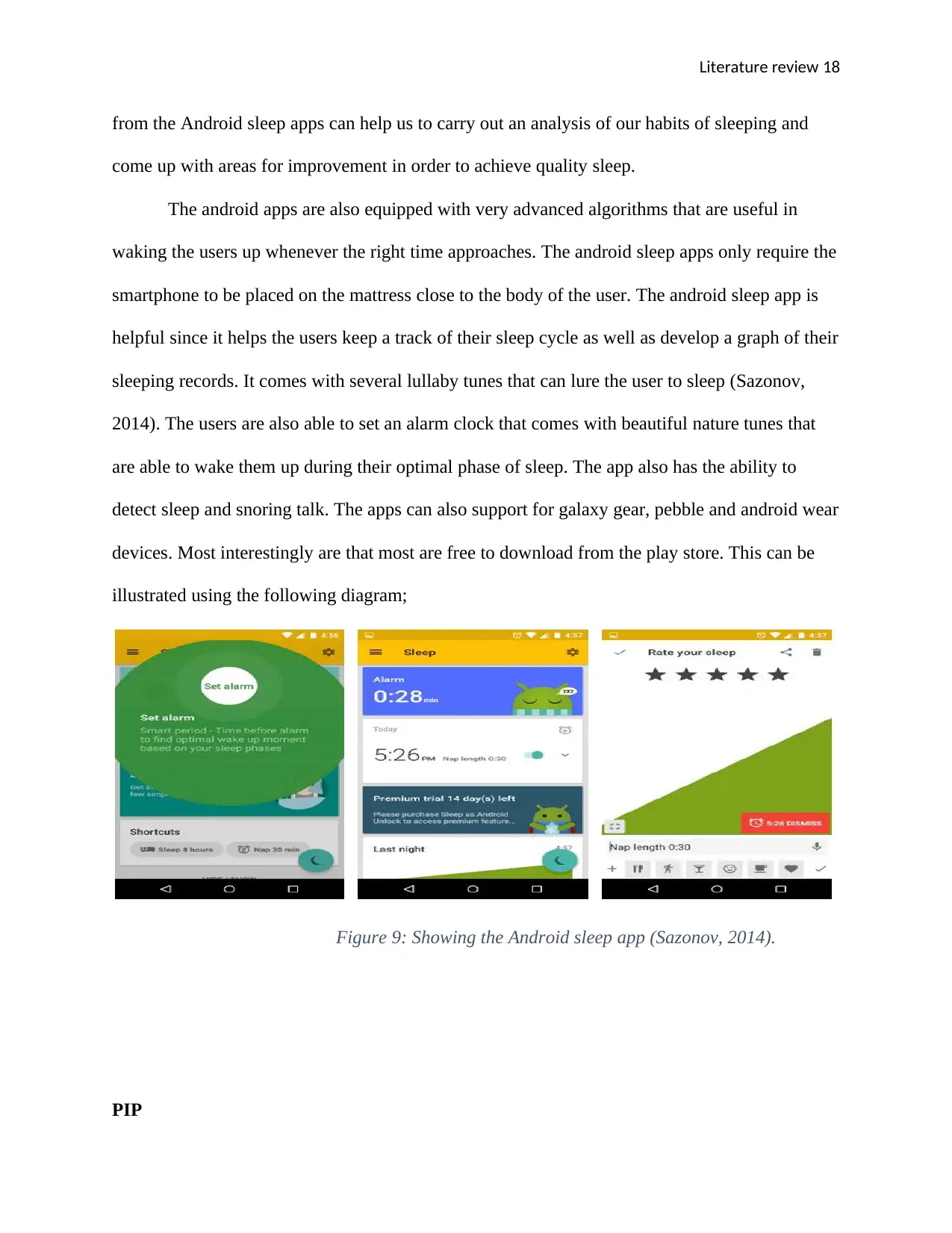
Literature review 18
from the Android sleep apps can help us to carry out an analysis of our habits of sleeping and
come up with areas for improvement in order to achieve quality sleep.
The android apps are also equipped with very advanced algorithms that are useful in
waking the users up whenever the right time approaches. The android sleep apps only require the
smartphone to be placed on the mattress close to the body of the user. The android sleep app is
helpful since it helps the users keep a track of their sleep cycle as well as develop a graph of their
sleeping records. It comes with several lullaby tunes that can lure the user to sleep (Sazonov,
2014). The users are also able to set an alarm clock that comes with beautiful nature tunes that
are able to wake them up during their optimal phase of sleep. The app also has the ability to
detect sleep and snoring talk. The apps can also support for galaxy gear, pebble and android wear
devices. Most interestingly are that most are free to download from the play store. This can be
illustrated using the following diagram;
Figure 9: Showing the Android sleep app (Sazonov, 2014).
PIP
from the Android sleep apps can help us to carry out an analysis of our habits of sleeping and
come up with areas for improvement in order to achieve quality sleep.
The android apps are also equipped with very advanced algorithms that are useful in
waking the users up whenever the right time approaches. The android sleep apps only require the
smartphone to be placed on the mattress close to the body of the user. The android sleep app is
helpful since it helps the users keep a track of their sleep cycle as well as develop a graph of their
sleeping records. It comes with several lullaby tunes that can lure the user to sleep (Sazonov,
2014). The users are also able to set an alarm clock that comes with beautiful nature tunes that
are able to wake them up during their optimal phase of sleep. The app also has the ability to
detect sleep and snoring talk. The apps can also support for galaxy gear, pebble and android wear
devices. Most interestingly are that most are free to download from the play store. This can be
illustrated using the following diagram;
Figure 9: Showing the Android sleep app (Sazonov, 2014).
PIP
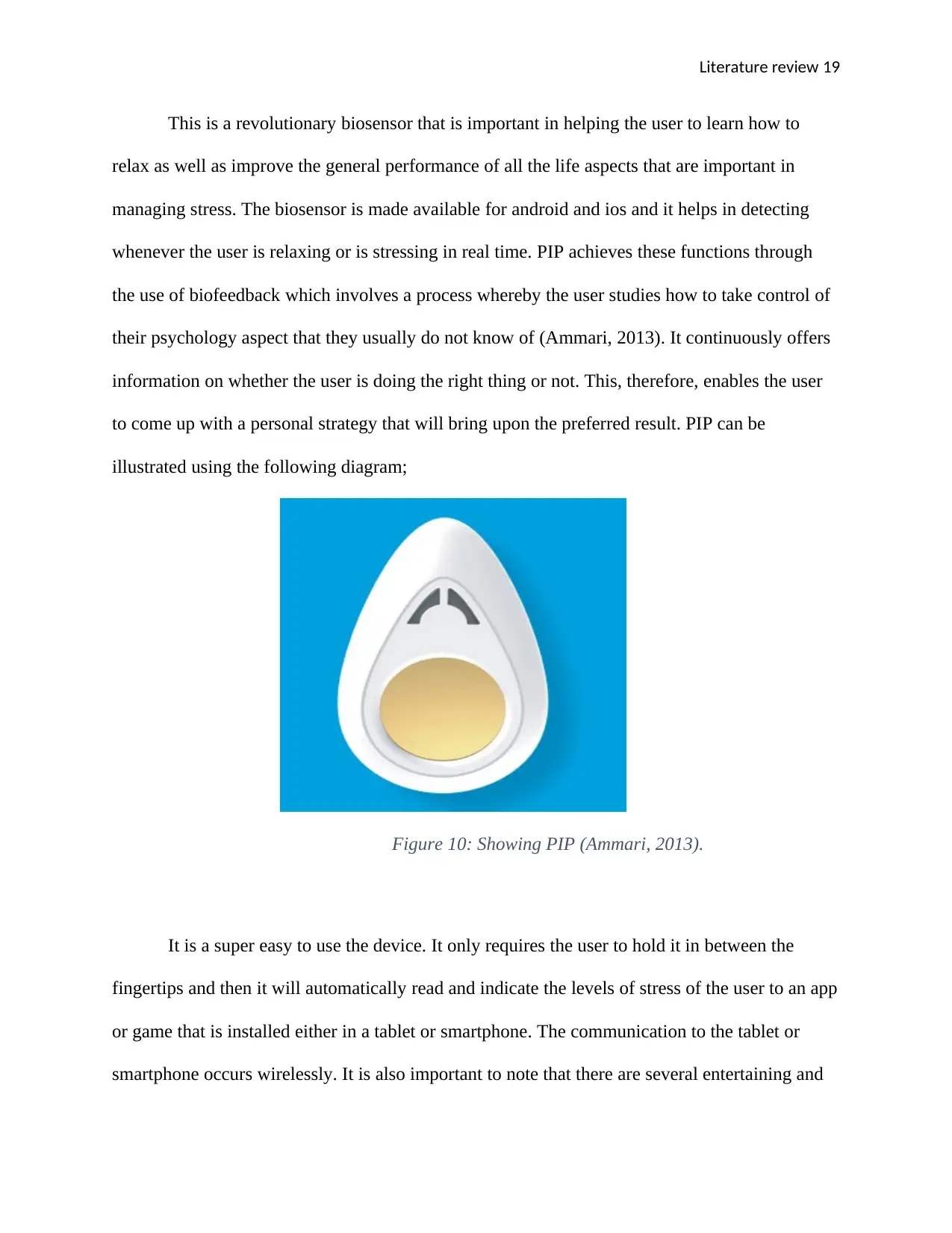
Literature review 19
This is a revolutionary biosensor that is important in helping the user to learn how to
relax as well as improve the general performance of all the life aspects that are important in
managing stress. The biosensor is made available for android and ios and it helps in detecting
whenever the user is relaxing or is stressing in real time. PIP achieves these functions through
the use of biofeedback which involves a process whereby the user studies how to take control of
their psychology aspect that they usually do not know of (Ammari, 2013). It continuously offers
information on whether the user is doing the right thing or not. This, therefore, enables the user
to come up with a personal strategy that will bring upon the preferred result. PIP can be
illustrated using the following diagram;
Figure 10: Showing PIP (Ammari, 2013).
It is a super easy to use the device. It only requires the user to hold it in between the
fingertips and then it will automatically read and indicate the levels of stress of the user to an app
or game that is installed either in a tablet or smartphone. The communication to the tablet or
smartphone occurs wirelessly. It is also important to note that there are several entertaining and
This is a revolutionary biosensor that is important in helping the user to learn how to
relax as well as improve the general performance of all the life aspects that are important in
managing stress. The biosensor is made available for android and ios and it helps in detecting
whenever the user is relaxing or is stressing in real time. PIP achieves these functions through
the use of biofeedback which involves a process whereby the user studies how to take control of
their psychology aspect that they usually do not know of (Ammari, 2013). It continuously offers
information on whether the user is doing the right thing or not. This, therefore, enables the user
to come up with a personal strategy that will bring upon the preferred result. PIP can be
illustrated using the following diagram;
Figure 10: Showing PIP (Ammari, 2013).
It is a super easy to use the device. It only requires the user to hold it in between the
fingertips and then it will automatically read and indicate the levels of stress of the user to an app
or game that is installed either in a tablet or smartphone. The communication to the tablet or
smartphone occurs wirelessly. It is also important to note that there are several entertaining and
Paraphrase This Document
Need a fresh take? Get an instant paraphrase of this document with our AI Paraphraser
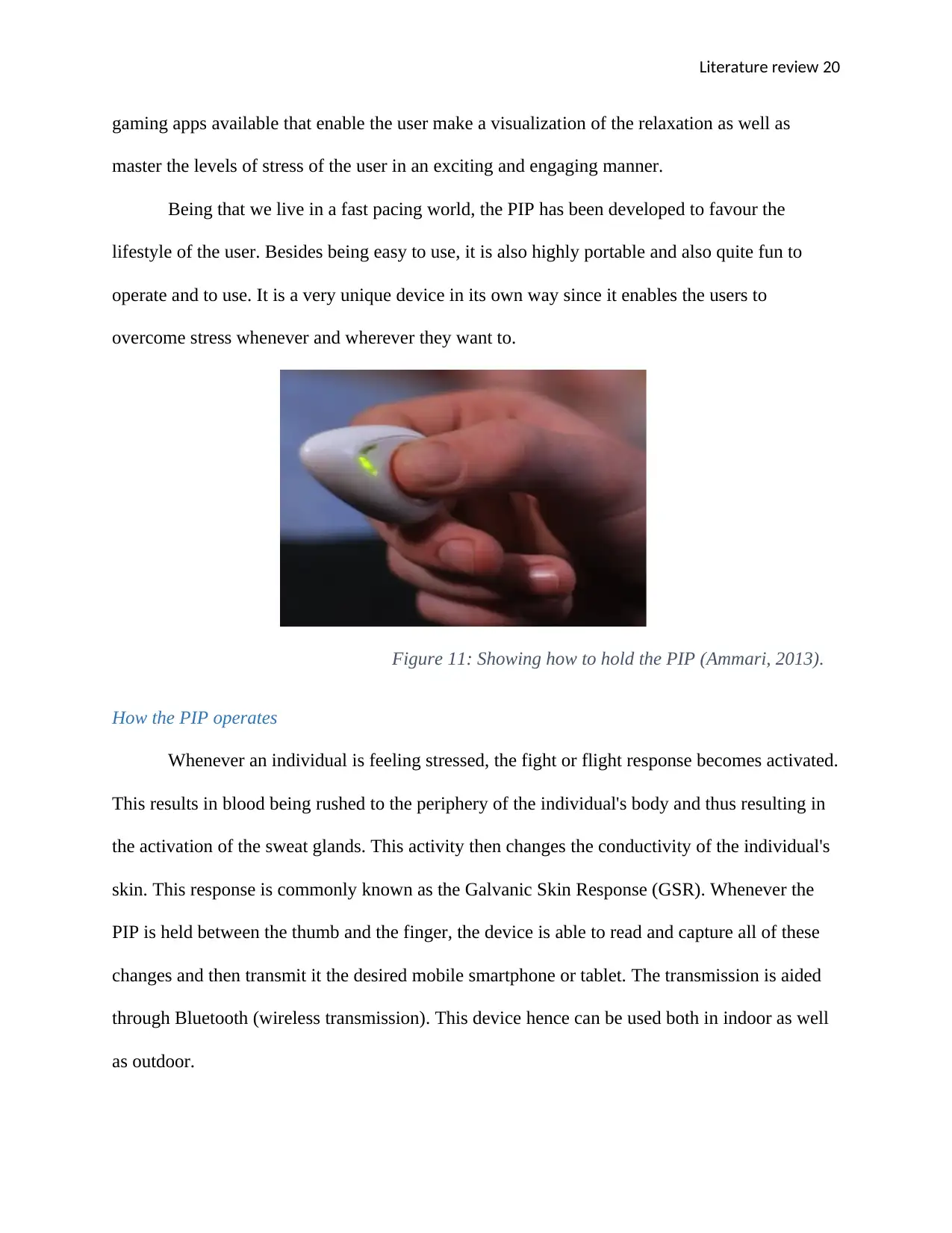
Literature review 20
gaming apps available that enable the user make a visualization of the relaxation as well as
master the levels of stress of the user in an exciting and engaging manner.
Being that we live in a fast pacing world, the PIP has been developed to favour the
lifestyle of the user. Besides being easy to use, it is also highly portable and also quite fun to
operate and to use. It is a very unique device in its own way since it enables the users to
overcome stress whenever and wherever they want to.
Figure 11: Showing how to hold the PIP (Ammari, 2013).
How the PIP operates
Whenever an individual is feeling stressed, the fight or flight response becomes activated.
This results in blood being rushed to the periphery of the individual's body and thus resulting in
the activation of the sweat glands. This activity then changes the conductivity of the individual's
skin. This response is commonly known as the Galvanic Skin Response (GSR). Whenever the
PIP is held between the thumb and the finger, the device is able to read and capture all of these
changes and then transmit it the desired mobile smartphone or tablet. The transmission is aided
through Bluetooth (wireless transmission). This device hence can be used both in indoor as well
as outdoor.
gaming apps available that enable the user make a visualization of the relaxation as well as
master the levels of stress of the user in an exciting and engaging manner.
Being that we live in a fast pacing world, the PIP has been developed to favour the
lifestyle of the user. Besides being easy to use, it is also highly portable and also quite fun to
operate and to use. It is a very unique device in its own way since it enables the users to
overcome stress whenever and wherever they want to.
Figure 11: Showing how to hold the PIP (Ammari, 2013).
How the PIP operates
Whenever an individual is feeling stressed, the fight or flight response becomes activated.
This results in blood being rushed to the periphery of the individual's body and thus resulting in
the activation of the sweat glands. This activity then changes the conductivity of the individual's
skin. This response is commonly known as the Galvanic Skin Response (GSR). Whenever the
PIP is held between the thumb and the finger, the device is able to read and capture all of these
changes and then transmit it the desired mobile smartphone or tablet. The transmission is aided
through Bluetooth (wireless transmission). This device hence can be used both in indoor as well
as outdoor.

Literature review 21
Figure 12: Showing How the PIP operates (Ammari,
2013).
Stress deducing algorithm
The device is able to measure the Galvanic Skin Response (GSR) quite effectively.
Besides that, there also has been the development of several complex systems for the analysis of
the GSR. Such detailed analysis helps in providing precise feedback for the individuals using the
PIP without regarding the conditions of the environment or the type of skin of the individuals.
Biofeedback
The PIP is a product of research and development that is purposefully designed to enable
the users to achieve skills of relaxation by the use of biofeedback. The device monitors the
electrical conductance of the individual's skin continuously and in real time. An algorithm then
performs analysis by retrieval vital features from the available data. Such features are then used
to offer the user information on how they perform in a game does affect the change in response
to their galvanic skin. This is vital since it brings upon several opportunities for the users to be
Figure 12: Showing How the PIP operates (Ammari,
2013).
Stress deducing algorithm
The device is able to measure the Galvanic Skin Response (GSR) quite effectively.
Besides that, there also has been the development of several complex systems for the analysis of
the GSR. Such detailed analysis helps in providing precise feedback for the individuals using the
PIP without regarding the conditions of the environment or the type of skin of the individuals.
Biofeedback
The PIP is a product of research and development that is purposefully designed to enable
the users to achieve skills of relaxation by the use of biofeedback. The device monitors the
electrical conductance of the individual's skin continuously and in real time. An algorithm then
performs analysis by retrieval vital features from the available data. Such features are then used
to offer the user information on how they perform in a game does affect the change in response
to their galvanic skin. This is vital since it brings upon several opportunities for the users to be
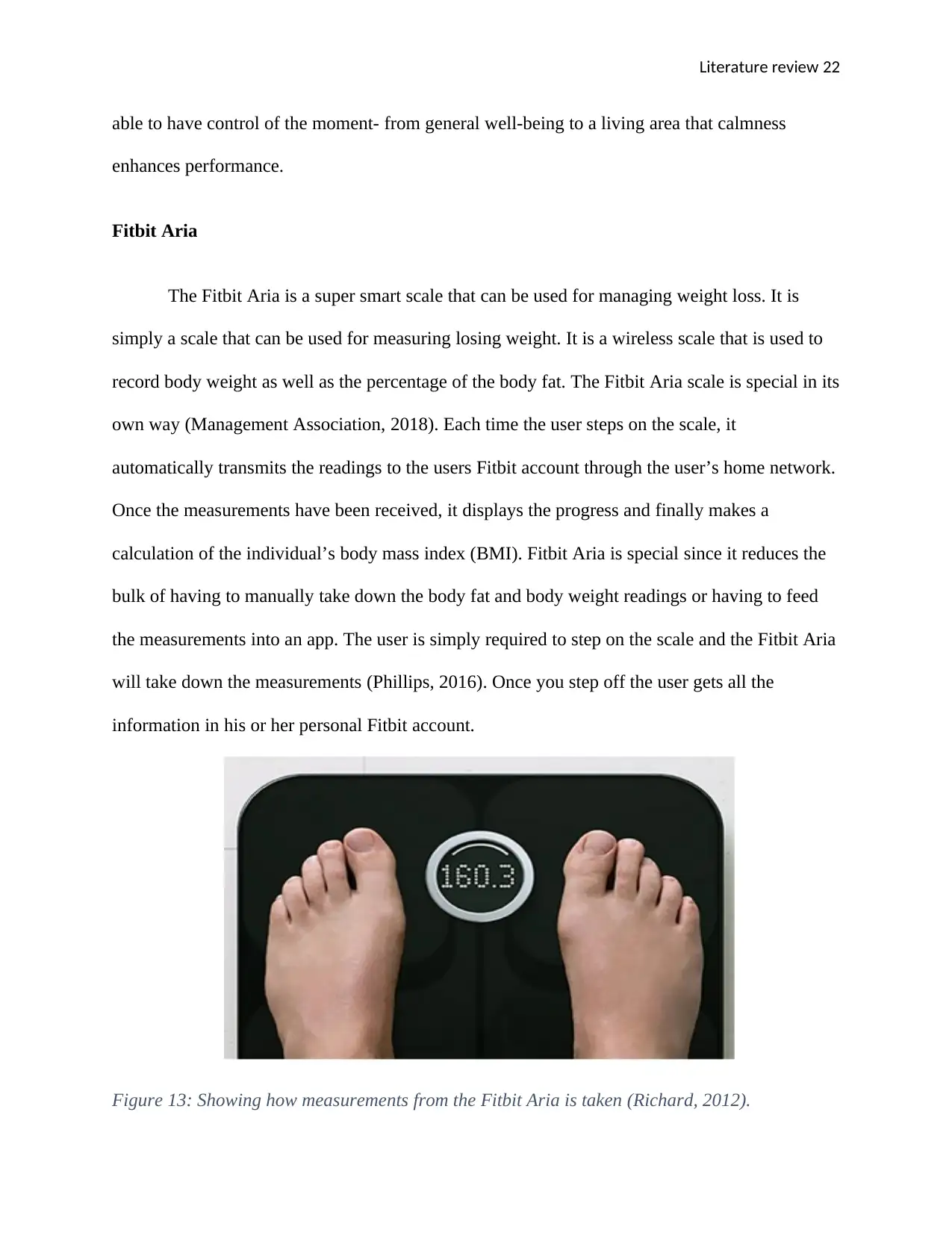
Literature review 22
able to have control of the moment- from general well-being to a living area that calmness
enhances performance.
Fitbit Aria
The Fitbit Aria is a super smart scale that can be used for managing weight loss. It is
simply a scale that can be used for measuring losing weight. It is a wireless scale that is used to
record body weight as well as the percentage of the body fat. The Fitbit Aria scale is special in its
own way (Management Association, 2018). Each time the user steps on the scale, it
automatically transmits the readings to the users Fitbit account through the user’s home network.
Once the measurements have been received, it displays the progress and finally makes a
calculation of the individual’s body mass index (BMI). Fitbit Aria is special since it reduces the
bulk of having to manually take down the body fat and body weight readings or having to feed
the measurements into an app. The user is simply required to step on the scale and the Fitbit Aria
will take down the measurements (Phillips, 2016). Once you step off the user gets all the
information in his or her personal Fitbit account.
Figure 13: Showing how measurements from the Fitbit Aria is taken (Richard, 2012).
able to have control of the moment- from general well-being to a living area that calmness
enhances performance.
Fitbit Aria
The Fitbit Aria is a super smart scale that can be used for managing weight loss. It is
simply a scale that can be used for measuring losing weight. It is a wireless scale that is used to
record body weight as well as the percentage of the body fat. The Fitbit Aria scale is special in its
own way (Management Association, 2018). Each time the user steps on the scale, it
automatically transmits the readings to the users Fitbit account through the user’s home network.
Once the measurements have been received, it displays the progress and finally makes a
calculation of the individual’s body mass index (BMI). Fitbit Aria is special since it reduces the
bulk of having to manually take down the body fat and body weight readings or having to feed
the measurements into an app. The user is simply required to step on the scale and the Fitbit Aria
will take down the measurements (Phillips, 2016). Once you step off the user gets all the
information in his or her personal Fitbit account.
Figure 13: Showing how measurements from the Fitbit Aria is taken (Richard, 2012).
Secure Best Marks with AI Grader
Need help grading? Try our AI Grader for instant feedback on your assignments.

Literature review 23
Collection and storage of information
With the Fitbit Aria scale, the user is able to track and make a review of his or her
progress. The scale does all these activities online through getting access to the interface of a
desktop in a PC or Mac. Alternatively, the scale can also use the Fitbit mobile app that is
accessible by all modern smartphones and tablets, either Android, Ios, or windows enabled. The
most interesting part with this scale is that a minute after stepping off the scale, the user is able to
access the measurements by logging in to the connected computer or by opening the Fitbit app
on the user's smartphone or tablet. The Fitbit Aria does not only keep a log of the user's body fat
and weight readings it also makes a chart of those readings such that the user is able to monitor
his or her progress. This is important since the user is also able to set goals.
Figure 14: Showing Chart displaying records of weight and body fat (Richard, 2012).
Collection and storage of information
With the Fitbit Aria scale, the user is able to track and make a review of his or her
progress. The scale does all these activities online through getting access to the interface of a
desktop in a PC or Mac. Alternatively, the scale can also use the Fitbit mobile app that is
accessible by all modern smartphones and tablets, either Android, Ios, or windows enabled. The
most interesting part with this scale is that a minute after stepping off the scale, the user is able to
access the measurements by logging in to the connected computer or by opening the Fitbit app
on the user's smartphone or tablet. The Fitbit Aria does not only keep a log of the user's body fat
and weight readings it also makes a chart of those readings such that the user is able to monitor
his or her progress. This is important since the user is also able to set goals.
Figure 14: Showing Chart displaying records of weight and body fat (Richard, 2012).
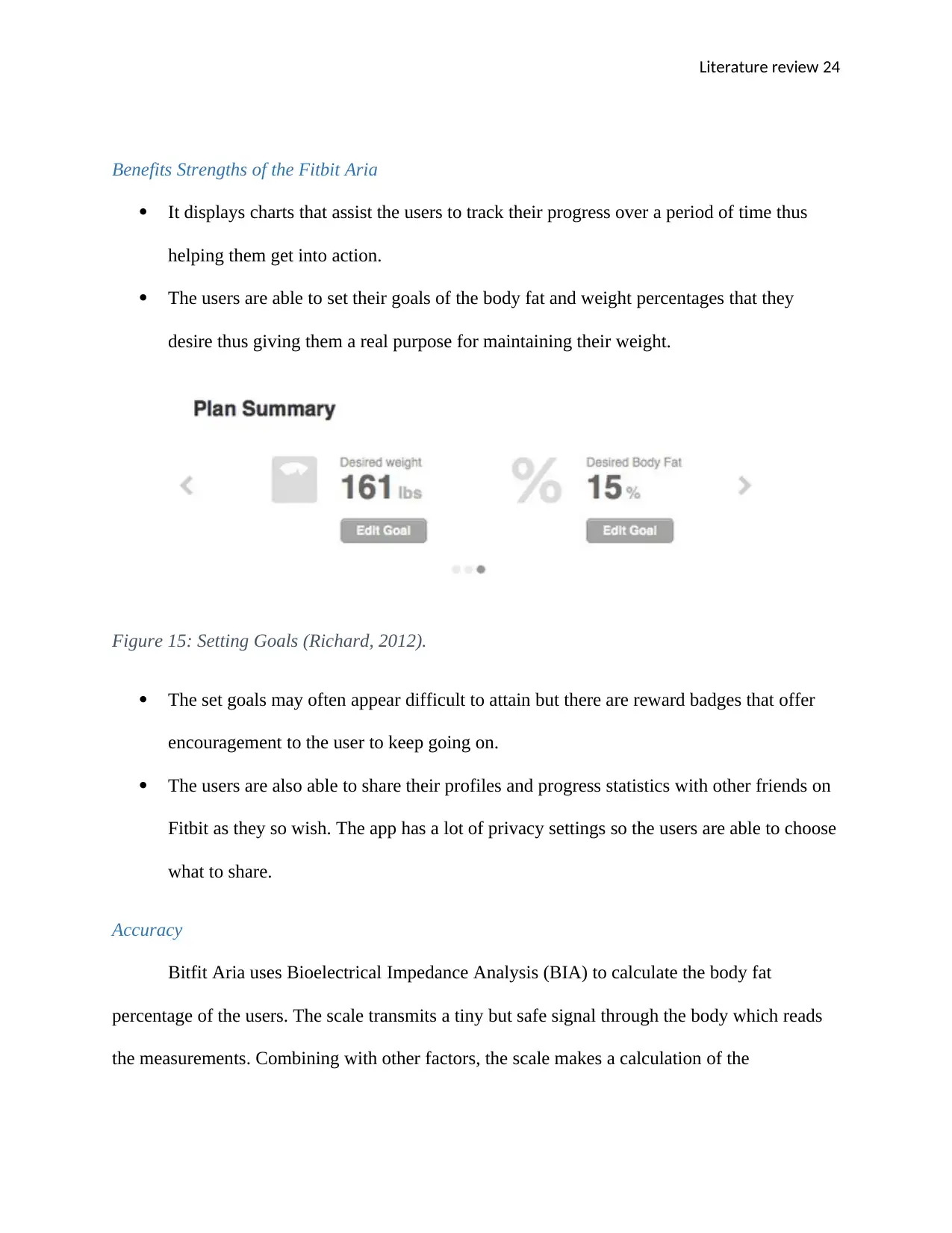
Literature review 24
Benefits Strengths of the Fitbit Aria
It displays charts that assist the users to track their progress over a period of time thus
helping them get into action.
The users are able to set their goals of the body fat and weight percentages that they
desire thus giving them a real purpose for maintaining their weight.
Figure 15: Setting Goals (Richard, 2012).
The set goals may often appear difficult to attain but there are reward badges that offer
encouragement to the user to keep going on.
The users are also able to share their profiles and progress statistics with other friends on
Fitbit as they so wish. The app has a lot of privacy settings so the users are able to choose
what to share.
Accuracy
Bitfit Aria uses Bioelectrical Impedance Analysis (BIA) to calculate the body fat
percentage of the users. The scale transmits a tiny but safe signal through the body which reads
the measurements. Combining with other factors, the scale makes a calculation of the
Benefits Strengths of the Fitbit Aria
It displays charts that assist the users to track their progress over a period of time thus
helping them get into action.
The users are able to set their goals of the body fat and weight percentages that they
desire thus giving them a real purpose for maintaining their weight.
Figure 15: Setting Goals (Richard, 2012).
The set goals may often appear difficult to attain but there are reward badges that offer
encouragement to the user to keep going on.
The users are also able to share their profiles and progress statistics with other friends on
Fitbit as they so wish. The app has a lot of privacy settings so the users are able to choose
what to share.
Accuracy
Bitfit Aria uses Bioelectrical Impedance Analysis (BIA) to calculate the body fat
percentage of the users. The scale transmits a tiny but safe signal through the body which reads
the measurements. Combining with other factors, the scale makes a calculation of the

Literature review 25
measurement that helps to determine the body fat. This is a common technology that has been
used by several brands in their body fat scales and has never disappointed.
Wearable sensor technology in healthcare
These are wearable sensors which are basically employed to improve the health condition of a
patient. There are several wearable sensors which are used in the healthcare sector and some of
these include;
iTBra
This is a smart bra which was invented by Cycadia healthcare to help detect breast cancer
in its early stages when it can easily be treated. This wearable sensor employs the use of a heat
sensor to detect the temperature of the lady´s circadian. It detects if there has been an abrupt
change which illustrates abnormal growth within breast cells (MacManus, 2016). An evaluation
using this type of wearable sensor takes a period between 2 hours to 24 hours and it only
demands that the iTbra is worn by a lady. This wearable sensor is less embarrassing as compared
to a physical examination since it is less intrusive. The examination using this type of sensor
does not require a lady´s time since it is going on as the lady goes on with her daily business.
This sensor is synchronized to the wearer smartphone hence the result from the sensor can easily
be displayed on her smartphone which is in most cases displayed as a notification on the phone.
In some cases, the result is sent in the lay´s laptop for further consultation. The diagrams below
illustrate the iTBra;
measurement that helps to determine the body fat. This is a common technology that has been
used by several brands in their body fat scales and has never disappointed.
Wearable sensor technology in healthcare
These are wearable sensors which are basically employed to improve the health condition of a
patient. There are several wearable sensors which are used in the healthcare sector and some of
these include;
iTBra
This is a smart bra which was invented by Cycadia healthcare to help detect breast cancer
in its early stages when it can easily be treated. This wearable sensor employs the use of a heat
sensor to detect the temperature of the lady´s circadian. It detects if there has been an abrupt
change which illustrates abnormal growth within breast cells (MacManus, 2016). An evaluation
using this type of wearable sensor takes a period between 2 hours to 24 hours and it only
demands that the iTbra is worn by a lady. This wearable sensor is less embarrassing as compared
to a physical examination since it is less intrusive. The examination using this type of sensor
does not require a lady´s time since it is going on as the lady goes on with her daily business.
This sensor is synchronized to the wearer smartphone hence the result from the sensor can easily
be displayed on her smartphone which is in most cases displayed as a notification on the phone.
In some cases, the result is sent in the lay´s laptop for further consultation. The diagrams below
illustrate the iTBra;
Paraphrase This Document
Need a fresh take? Get an instant paraphrase of this document with our AI Paraphraser
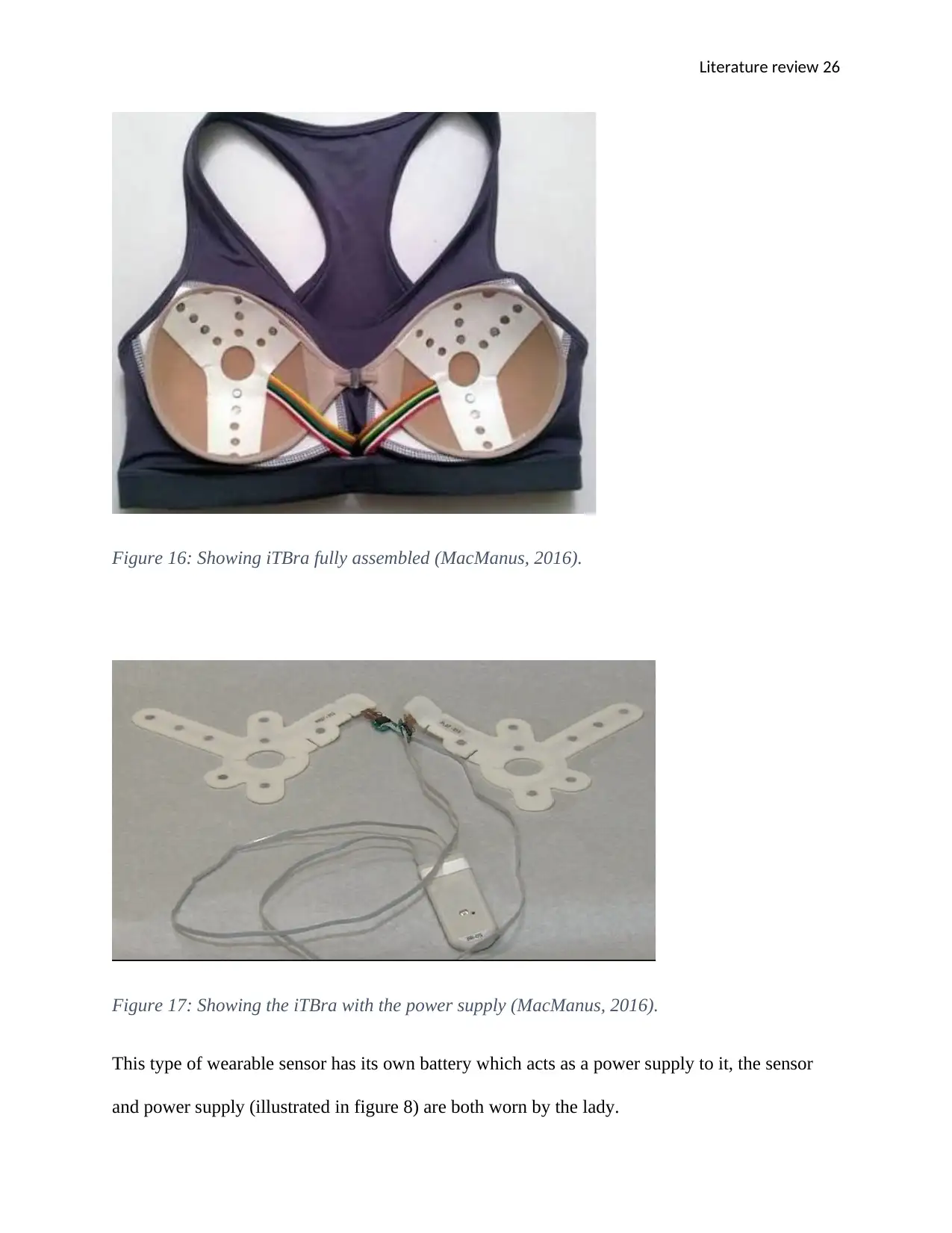
Literature review 26
Figure 16: Showing iTBra fully assembled (MacManus, 2016).
Figure 17: Showing the iTBra with the power supply (MacManus, 2016).
This type of wearable sensor has its own battery which acts as a power supply to it, the sensor
and power supply (illustrated in figure 8) are both worn by the lady.
Figure 16: Showing iTBra fully assembled (MacManus, 2016).
Figure 17: Showing the iTBra with the power supply (MacManus, 2016).
This type of wearable sensor has its own battery which acts as a power supply to it, the sensor
and power supply (illustrated in figure 8) are both worn by the lady.
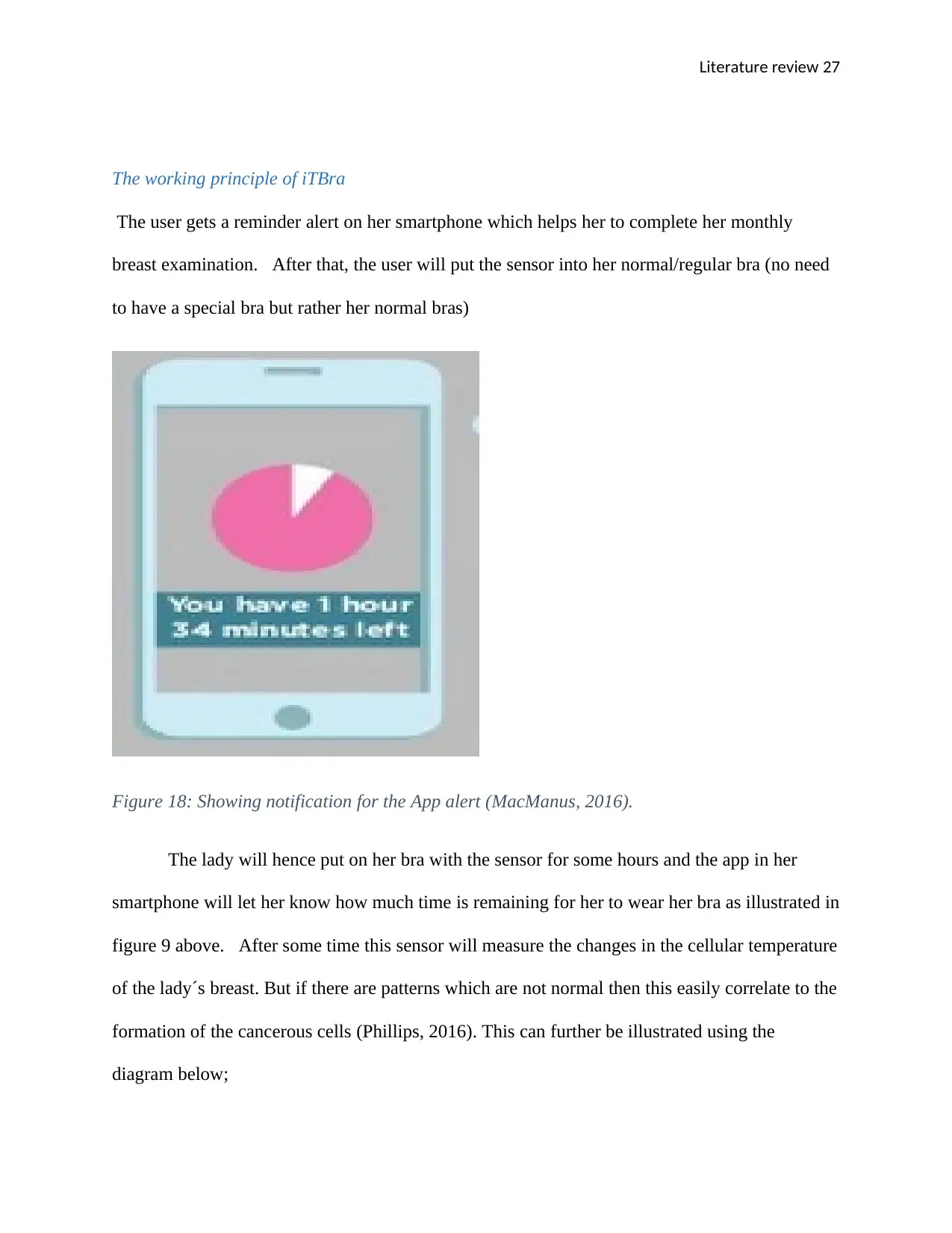
Literature review 27
The working principle of iTBra
The user gets a reminder alert on her smartphone which helps her to complete her monthly
breast examination. After that, the user will put the sensor into her normal/regular bra (no need
to have a special bra but rather her normal bras)
Figure 18: Showing notification for the App alert (MacManus, 2016).
The lady will hence put on her bra with the sensor for some hours and the app in her
smartphone will let her know how much time is remaining for her to wear her bra as illustrated in
figure 9 above. After some time this sensor will measure the changes in the cellular temperature
of the lady´s breast. But if there are patterns which are not normal then this easily correlate to the
formation of the cancerous cells (Phillips, 2016). This can further be illustrated using the
diagram below;
The working principle of iTBra
The user gets a reminder alert on her smartphone which helps her to complete her monthly
breast examination. After that, the user will put the sensor into her normal/regular bra (no need
to have a special bra but rather her normal bras)
Figure 18: Showing notification for the App alert (MacManus, 2016).
The lady will hence put on her bra with the sensor for some hours and the app in her
smartphone will let her know how much time is remaining for her to wear her bra as illustrated in
figure 9 above. After some time this sensor will measure the changes in the cellular temperature
of the lady´s breast. But if there are patterns which are not normal then this easily correlate to the
formation of the cancerous cells (Phillips, 2016). This can further be illustrated using the
diagram below;

Literature review 28
Figure 19: Showing the graphical alert after scanning (MacManus, 2016).
This information will then transmitted to the patient database safely then alerts the user´s doctor.
It is cheaper to use this type of wearable sensor as compared to attempt to treat breast cancer at
late stages. At earlier stages, it relatively cheaper to treat breast cancer and the result for the
treatment is always positive.
The wearable sensor will transmit the signal from the breast to the lady´s smartphone by
the use of Bluetooth (wireless communication) after the two devices have been perfectly
synchronized. This can be illustrated using the diagram below. The information obtained from
this wearable sensor is also shared to the lab for further analysis which is also done through
wireless transmission. In some cases the doctors and the family members may need the
information hence there are also sent this data through wireless transmission. The whole process
is summarized in the diagram below;
Figure 19: Showing the graphical alert after scanning (MacManus, 2016).
This information will then transmitted to the patient database safely then alerts the user´s doctor.
It is cheaper to use this type of wearable sensor as compared to attempt to treat breast cancer at
late stages. At earlier stages, it relatively cheaper to treat breast cancer and the result for the
treatment is always positive.
The wearable sensor will transmit the signal from the breast to the lady´s smartphone by
the use of Bluetooth (wireless communication) after the two devices have been perfectly
synchronized. This can be illustrated using the diagram below. The information obtained from
this wearable sensor is also shared to the lab for further analysis which is also done through
wireless transmission. In some cases the doctors and the family members may need the
information hence there are also sent this data through wireless transmission. The whole process
is summarized in the diagram below;
Secure Best Marks with AI Grader
Need help grading? Try our AI Grader for instant feedback on your assignments.
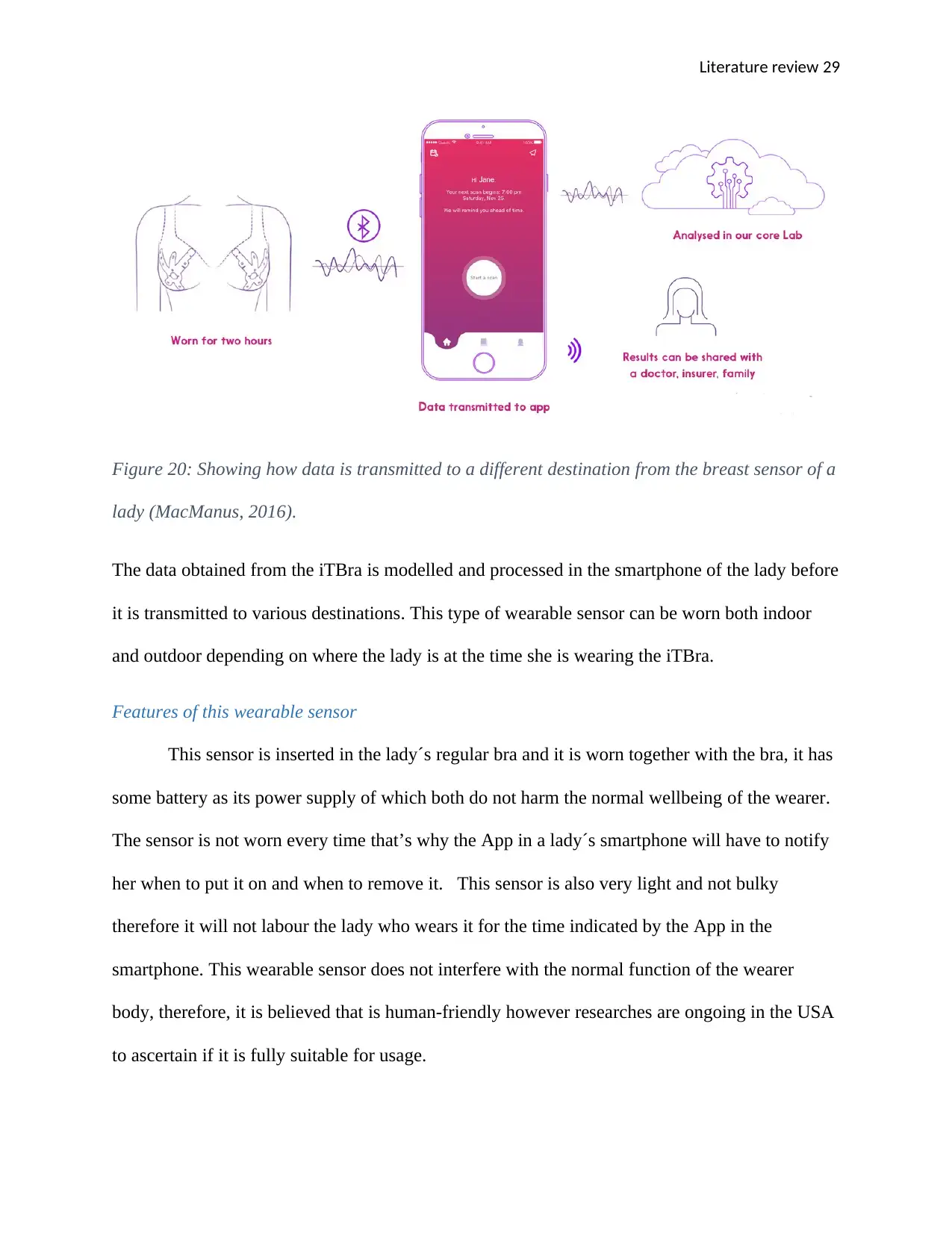
Literature review 29
Figure 20: Showing how data is transmitted to a different destination from the breast sensor of a
lady (MacManus, 2016).
The data obtained from the iTBra is modelled and processed in the smartphone of the lady before
it is transmitted to various destinations. This type of wearable sensor can be worn both indoor
and outdoor depending on where the lady is at the time she is wearing the iTBra.
Features of this wearable sensor
This sensor is inserted in the lady´s regular bra and it is worn together with the bra, it has
some battery as its power supply of which both do not harm the normal wellbeing of the wearer.
The sensor is not worn every time that’s why the App in a lady´s smartphone will have to notify
her when to put it on and when to remove it. This sensor is also very light and not bulky
therefore it will not labour the lady who wears it for the time indicated by the App in the
smartphone. This wearable sensor does not interfere with the normal function of the wearer
body, therefore, it is believed that is human-friendly however researches are ongoing in the USA
to ascertain if it is fully suitable for usage.
Figure 20: Showing how data is transmitted to a different destination from the breast sensor of a
lady (MacManus, 2016).
The data obtained from the iTBra is modelled and processed in the smartphone of the lady before
it is transmitted to various destinations. This type of wearable sensor can be worn both indoor
and outdoor depending on where the lady is at the time she is wearing the iTBra.
Features of this wearable sensor
This sensor is inserted in the lady´s regular bra and it is worn together with the bra, it has
some battery as its power supply of which both do not harm the normal wellbeing of the wearer.
The sensor is not worn every time that’s why the App in a lady´s smartphone will have to notify
her when to put it on and when to remove it. This sensor is also very light and not bulky
therefore it will not labour the lady who wears it for the time indicated by the App in the
smartphone. This wearable sensor does not interfere with the normal function of the wearer
body, therefore, it is believed that is human-friendly however researches are ongoing in the USA
to ascertain if it is fully suitable for usage.
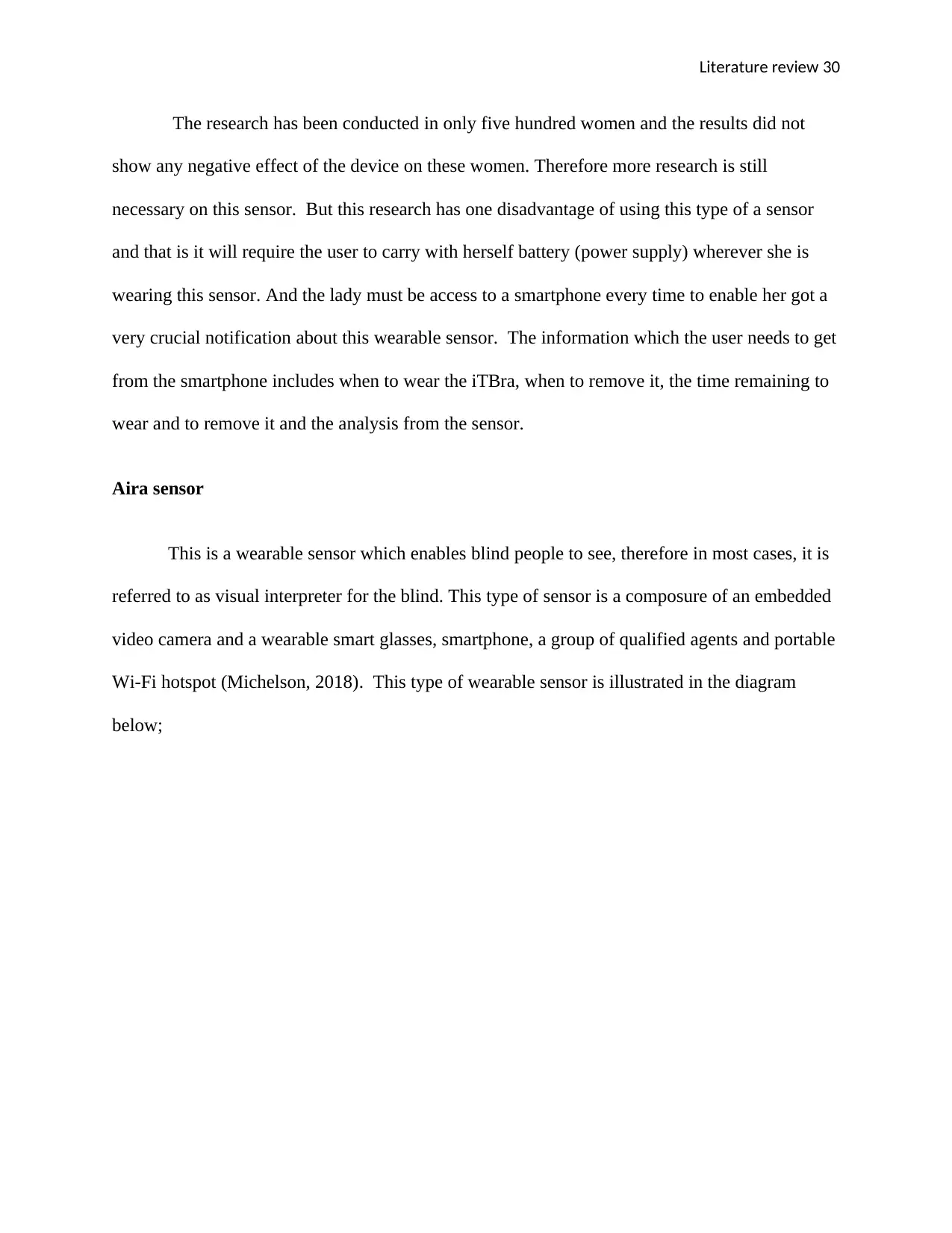
Literature review 30
The research has been conducted in only five hundred women and the results did not
show any negative effect of the device on these women. Therefore more research is still
necessary on this sensor. But this research has one disadvantage of using this type of a sensor
and that is it will require the user to carry with herself battery (power supply) wherever she is
wearing this sensor. And the lady must be access to a smartphone every time to enable her got a
very crucial notification about this wearable sensor. The information which the user needs to get
from the smartphone includes when to wear the iTBra, when to remove it, the time remaining to
wear and to remove it and the analysis from the sensor.
Aira sensor
This is a wearable sensor which enables blind people to see, therefore in most cases, it is
referred to as visual interpreter for the blind. This type of sensor is a composure of an embedded
video camera and a wearable smart glasses, smartphone, a group of qualified agents and portable
Wi-Fi hotspot (Michelson, 2018). This type of wearable sensor is illustrated in the diagram
below;
The research has been conducted in only five hundred women and the results did not
show any negative effect of the device on these women. Therefore more research is still
necessary on this sensor. But this research has one disadvantage of using this type of a sensor
and that is it will require the user to carry with herself battery (power supply) wherever she is
wearing this sensor. And the lady must be access to a smartphone every time to enable her got a
very crucial notification about this wearable sensor. The information which the user needs to get
from the smartphone includes when to wear the iTBra, when to remove it, the time remaining to
wear and to remove it and the analysis from the sensor.
Aira sensor
This is a wearable sensor which enables blind people to see, therefore in most cases, it is
referred to as visual interpreter for the blind. This type of sensor is a composure of an embedded
video camera and a wearable smart glasses, smartphone, a group of qualified agents and portable
Wi-Fi hotspot (Michelson, 2018). This type of wearable sensor is illustrated in the diagram
below;
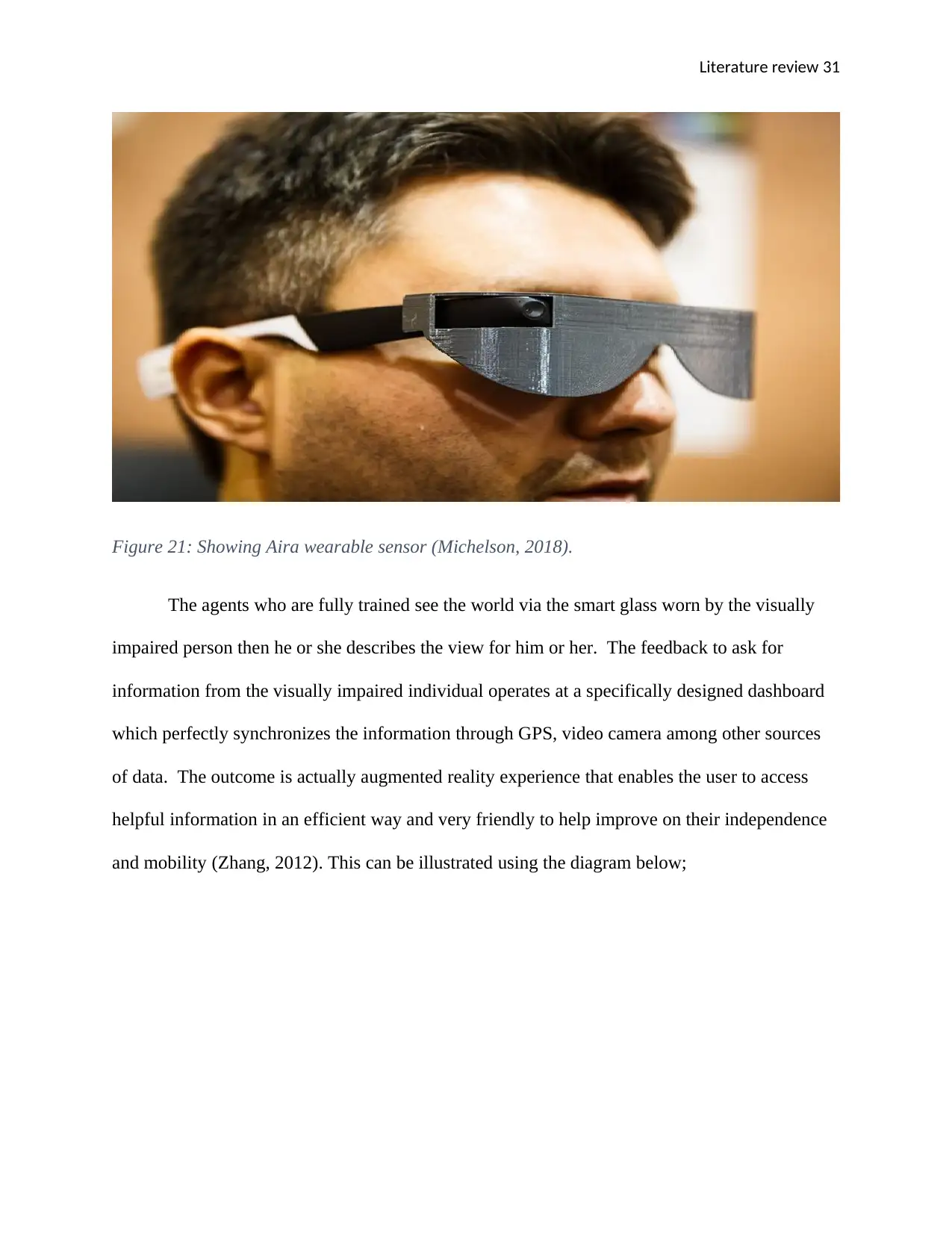
Literature review 31
Figure 21: Showing Aira wearable sensor (Michelson, 2018).
The agents who are fully trained see the world via the smart glass worn by the visually
impaired person then he or she describes the view for him or her. The feedback to ask for
information from the visually impaired individual operates at a specifically designed dashboard
which perfectly synchronizes the information through GPS, video camera among other sources
of data. The outcome is actually augmented reality experience that enables the user to access
helpful information in an efficient way and very friendly to help improve on their independence
and mobility (Zhang, 2012). This can be illustrated using the diagram below;
Figure 21: Showing Aira wearable sensor (Michelson, 2018).
The agents who are fully trained see the world via the smart glass worn by the visually
impaired person then he or she describes the view for him or her. The feedback to ask for
information from the visually impaired individual operates at a specifically designed dashboard
which perfectly synchronizes the information through GPS, video camera among other sources
of data. The outcome is actually augmented reality experience that enables the user to access
helpful information in an efficient way and very friendly to help improve on their independence
and mobility (Zhang, 2012). This can be illustrated using the diagram below;
Paraphrase This Document
Need a fresh take? Get an instant paraphrase of this document with our AI Paraphraser
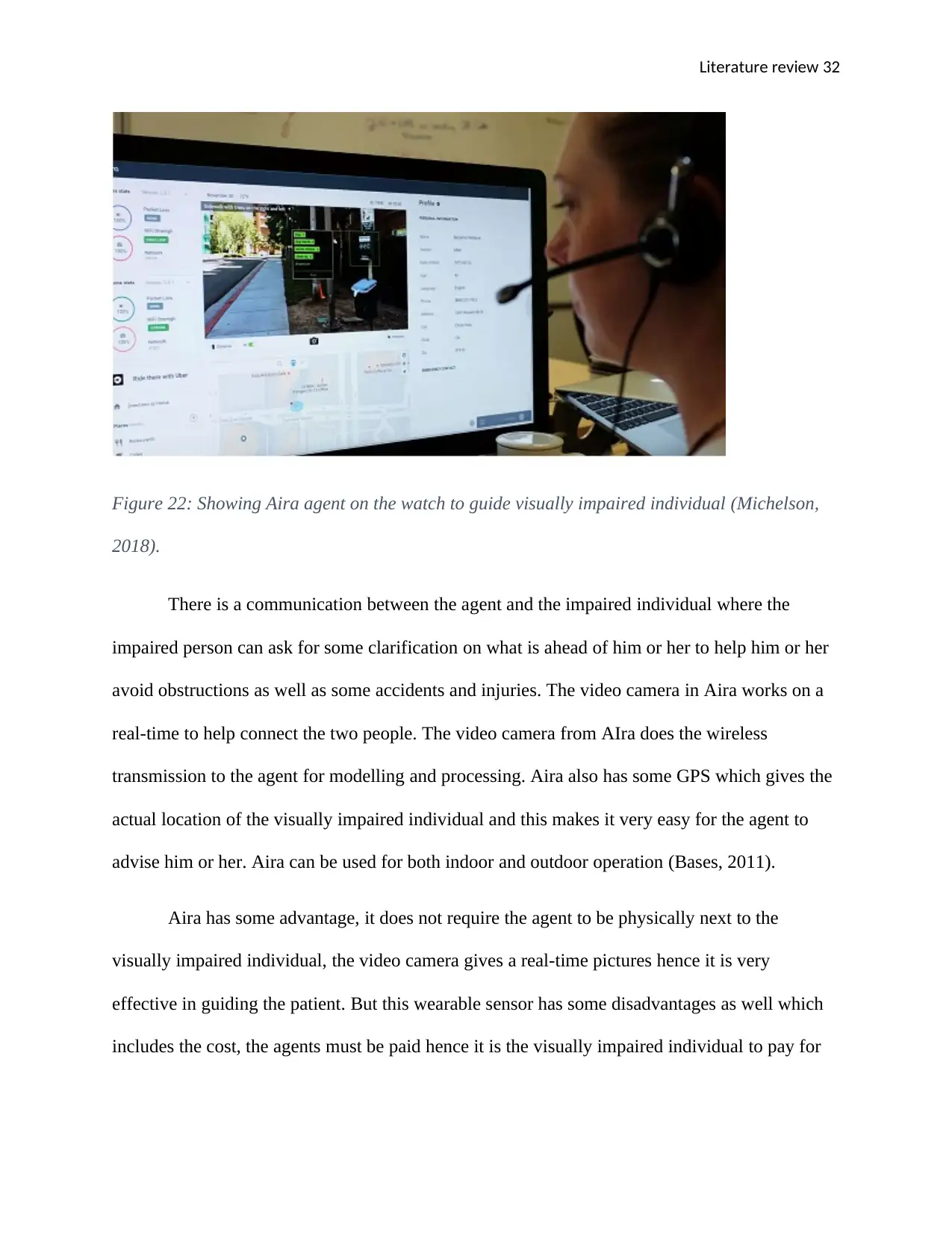
Literature review 32
Figure 22: Showing Aira agent on the watch to guide visually impaired individual (Michelson,
2018).
There is a communication between the agent and the impaired individual where the
impaired person can ask for some clarification on what is ahead of him or her to help him or her
avoid obstructions as well as some accidents and injuries. The video camera in Aira works on a
real-time to help connect the two people. The video camera from AIra does the wireless
transmission to the agent for modelling and processing. Aira also has some GPS which gives the
actual location of the visually impaired individual and this makes it very easy for the agent to
advise him or her. Aira can be used for both indoor and outdoor operation (Bases, 2011).
Aira has some advantage, it does not require the agent to be physically next to the
visually impaired individual, the video camera gives a real-time pictures hence it is very
effective in guiding the patient. But this wearable sensor has some disadvantages as well which
includes the cost, the agents must be paid hence it is the visually impaired individual to pay for
Figure 22: Showing Aira agent on the watch to guide visually impaired individual (Michelson,
2018).
There is a communication between the agent and the impaired individual where the
impaired person can ask for some clarification on what is ahead of him or her to help him or her
avoid obstructions as well as some accidents and injuries. The video camera in Aira works on a
real-time to help connect the two people. The video camera from AIra does the wireless
transmission to the agent for modelling and processing. Aira also has some GPS which gives the
actual location of the visually impaired individual and this makes it very easy for the agent to
advise him or her. Aira can be used for both indoor and outdoor operation (Bases, 2011).
Aira has some advantage, it does not require the agent to be physically next to the
visually impaired individual, the video camera gives a real-time pictures hence it is very
effective in guiding the patient. But this wearable sensor has some disadvantages as well which
includes the cost, the agents must be paid hence it is the visually impaired individual to pay for
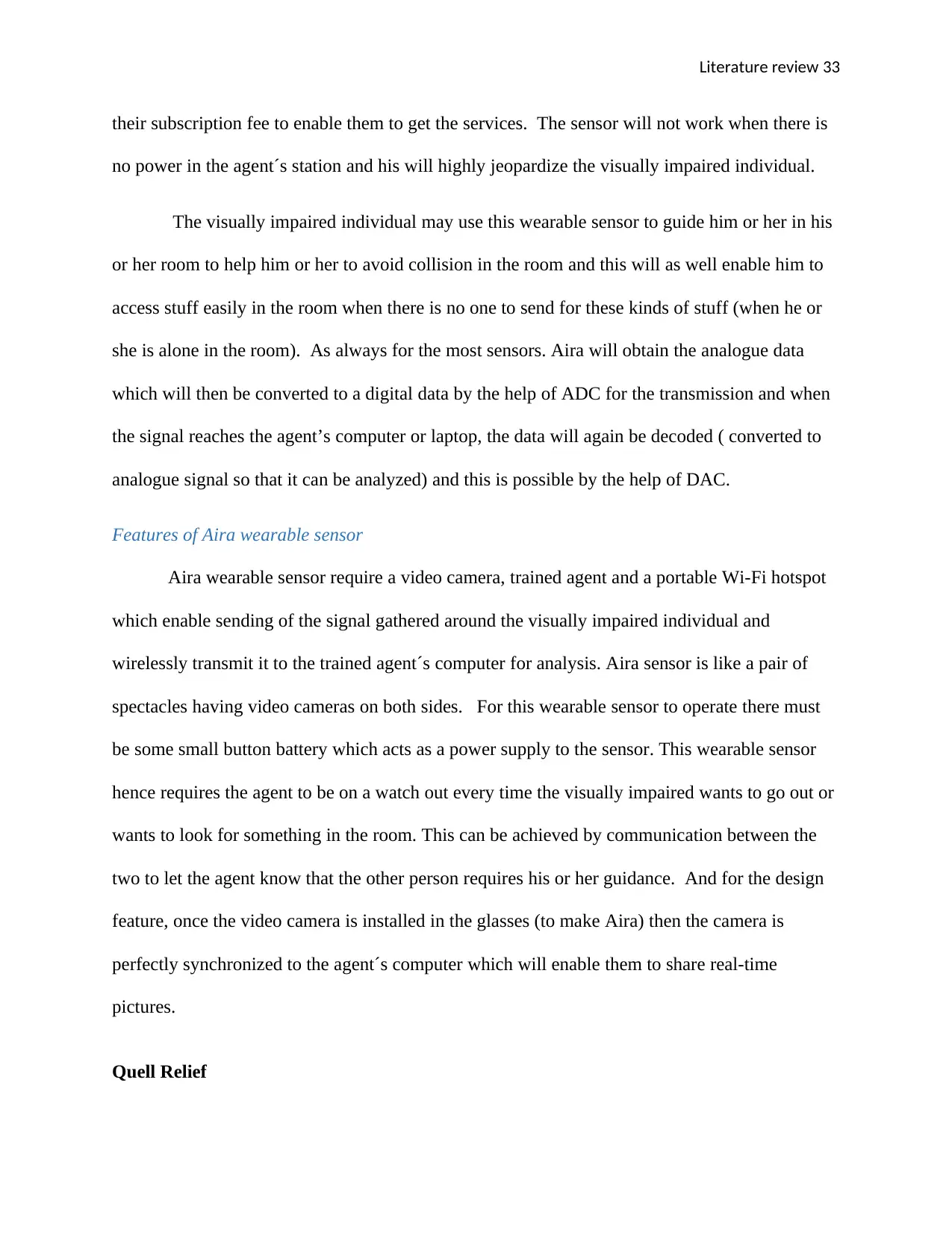
Literature review 33
their subscription fee to enable them to get the services. The sensor will not work when there is
no power in the agent´s station and his will highly jeopardize the visually impaired individual.
The visually impaired individual may use this wearable sensor to guide him or her in his
or her room to help him or her to avoid collision in the room and this will as well enable him to
access stuff easily in the room when there is no one to send for these kinds of stuff (when he or
she is alone in the room). As always for the most sensors. Aira will obtain the analogue data
which will then be converted to a digital data by the help of ADC for the transmission and when
the signal reaches the agent’s computer or laptop, the data will again be decoded ( converted to
analogue signal so that it can be analyzed) and this is possible by the help of DAC.
Features of Aira wearable sensor
Aira wearable sensor require a video camera, trained agent and a portable Wi-Fi hotspot
which enable sending of the signal gathered around the visually impaired individual and
wirelessly transmit it to the trained agent´s computer for analysis. Aira sensor is like a pair of
spectacles having video cameras on both sides. For this wearable sensor to operate there must
be some small button battery which acts as a power supply to the sensor. This wearable sensor
hence requires the agent to be on a watch out every time the visually impaired wants to go out or
wants to look for something in the room. This can be achieved by communication between the
two to let the agent know that the other person requires his or her guidance. And for the design
feature, once the video camera is installed in the glasses (to make Aira) then the camera is
perfectly synchronized to the agent´s computer which will enable them to share real-time
pictures.
Quell Relief
their subscription fee to enable them to get the services. The sensor will not work when there is
no power in the agent´s station and his will highly jeopardize the visually impaired individual.
The visually impaired individual may use this wearable sensor to guide him or her in his
or her room to help him or her to avoid collision in the room and this will as well enable him to
access stuff easily in the room when there is no one to send for these kinds of stuff (when he or
she is alone in the room). As always for the most sensors. Aira will obtain the analogue data
which will then be converted to a digital data by the help of ADC for the transmission and when
the signal reaches the agent’s computer or laptop, the data will again be decoded ( converted to
analogue signal so that it can be analyzed) and this is possible by the help of DAC.
Features of Aira wearable sensor
Aira wearable sensor require a video camera, trained agent and a portable Wi-Fi hotspot
which enable sending of the signal gathered around the visually impaired individual and
wirelessly transmit it to the trained agent´s computer for analysis. Aira sensor is like a pair of
spectacles having video cameras on both sides. For this wearable sensor to operate there must
be some small button battery which acts as a power supply to the sensor. This wearable sensor
hence requires the agent to be on a watch out every time the visually impaired wants to go out or
wants to look for something in the room. This can be achieved by communication between the
two to let the agent know that the other person requires his or her guidance. And for the design
feature, once the video camera is installed in the glasses (to make Aira) then the camera is
perfectly synchronized to the agent´s computer which will enable them to share real-time
pictures.
Quell Relief
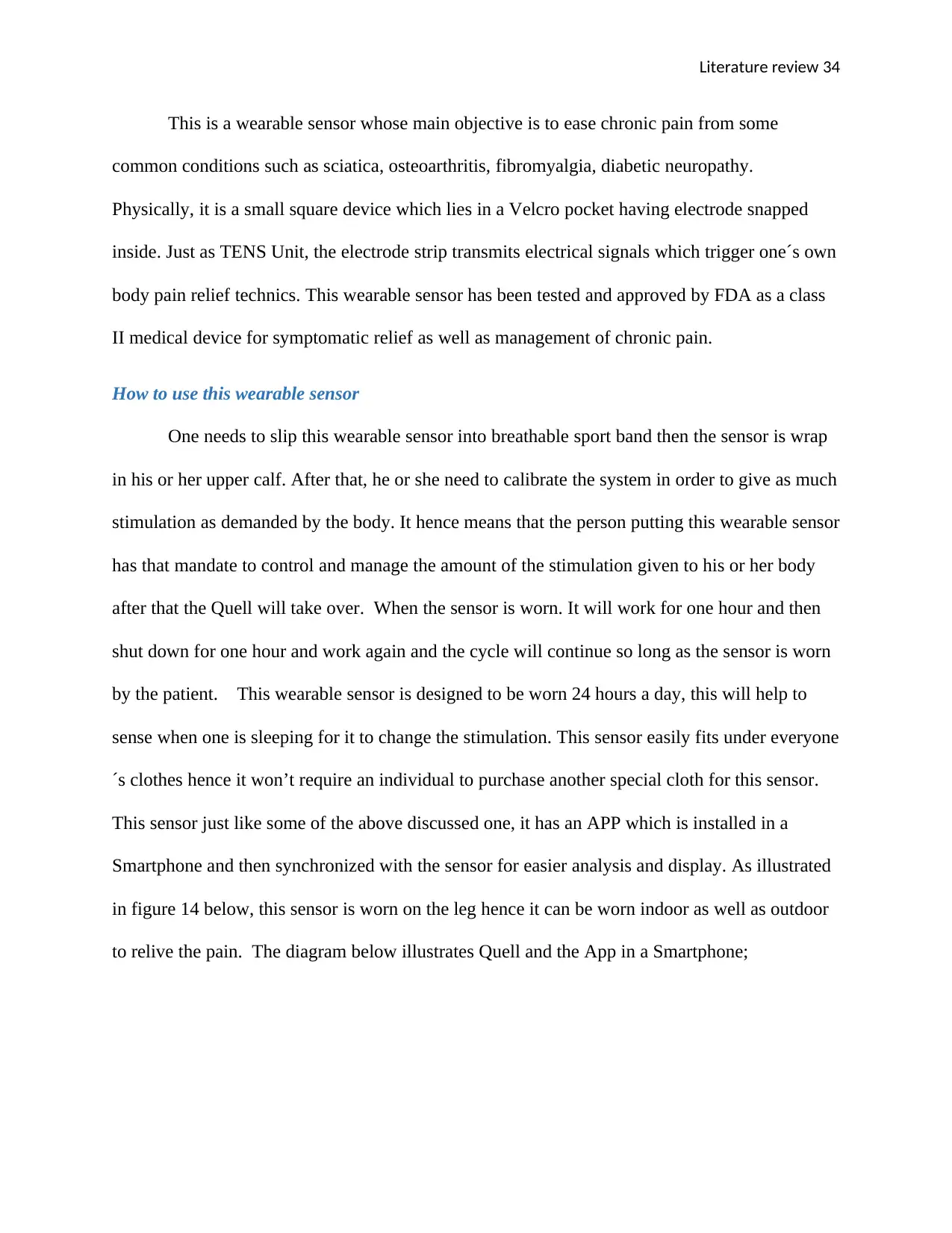
Literature review 34
This is a wearable sensor whose main objective is to ease chronic pain from some
common conditions such as sciatica, osteoarthritis, fibromyalgia, diabetic neuropathy.
Physically, it is a small square device which lies in a Velcro pocket having electrode snapped
inside. Just as TENS Unit, the electrode strip transmits electrical signals which trigger one´s own
body pain relief technics. This wearable sensor has been tested and approved by FDA as a class
II medical device for symptomatic relief as well as management of chronic pain.
How to use this wearable sensor
One needs to slip this wearable sensor into breathable sport band then the sensor is wrap
in his or her upper calf. After that, he or she need to calibrate the system in order to give as much
stimulation as demanded by the body. It hence means that the person putting this wearable sensor
has that mandate to control and manage the amount of the stimulation given to his or her body
after that the Quell will take over. When the sensor is worn. It will work for one hour and then
shut down for one hour and work again and the cycle will continue so long as the sensor is worn
by the patient. This wearable sensor is designed to be worn 24 hours a day, this will help to
sense when one is sleeping for it to change the stimulation. This sensor easily fits under everyone
´s clothes hence it won’t require an individual to purchase another special cloth for this sensor.
This sensor just like some of the above discussed one, it has an APP which is installed in a
Smartphone and then synchronized with the sensor for easier analysis and display. As illustrated
in figure 14 below, this sensor is worn on the leg hence it can be worn indoor as well as outdoor
to relive the pain. The diagram below illustrates Quell and the App in a Smartphone;
This is a wearable sensor whose main objective is to ease chronic pain from some
common conditions such as sciatica, osteoarthritis, fibromyalgia, diabetic neuropathy.
Physically, it is a small square device which lies in a Velcro pocket having electrode snapped
inside. Just as TENS Unit, the electrode strip transmits electrical signals which trigger one´s own
body pain relief technics. This wearable sensor has been tested and approved by FDA as a class
II medical device for symptomatic relief as well as management of chronic pain.
How to use this wearable sensor
One needs to slip this wearable sensor into breathable sport band then the sensor is wrap
in his or her upper calf. After that, he or she need to calibrate the system in order to give as much
stimulation as demanded by the body. It hence means that the person putting this wearable sensor
has that mandate to control and manage the amount of the stimulation given to his or her body
after that the Quell will take over. When the sensor is worn. It will work for one hour and then
shut down for one hour and work again and the cycle will continue so long as the sensor is worn
by the patient. This wearable sensor is designed to be worn 24 hours a day, this will help to
sense when one is sleeping for it to change the stimulation. This sensor easily fits under everyone
´s clothes hence it won’t require an individual to purchase another special cloth for this sensor.
This sensor just like some of the above discussed one, it has an APP which is installed in a
Smartphone and then synchronized with the sensor for easier analysis and display. As illustrated
in figure 14 below, this sensor is worn on the leg hence it can be worn indoor as well as outdoor
to relive the pain. The diagram below illustrates Quell and the App in a Smartphone;
Secure Best Marks with AI Grader
Need help grading? Try our AI Grader for instant feedback on your assignments.
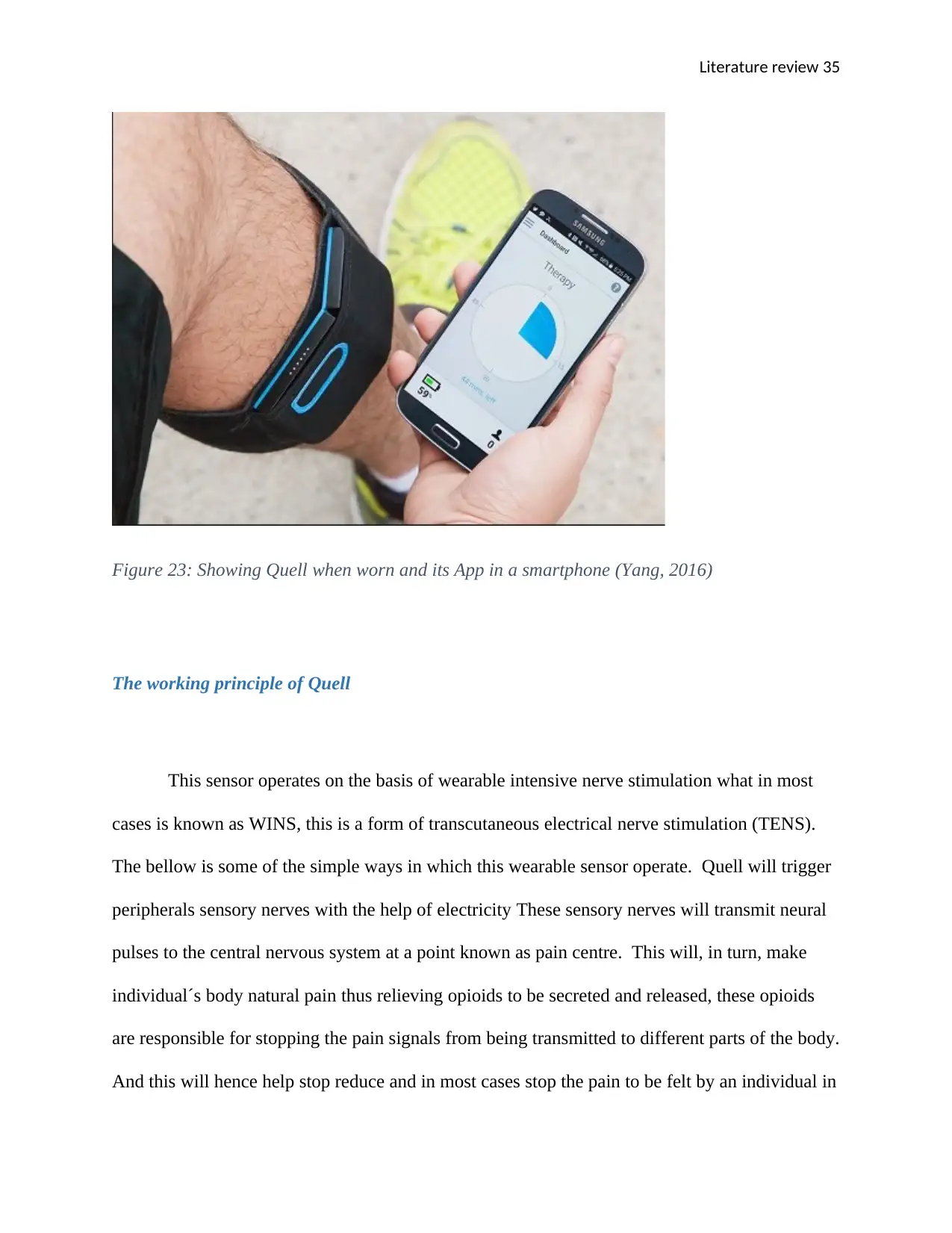
Literature review 35
Figure 23: Showing Quell when worn and its App in a smartphone (Yang, 2016)
The working principle of Quell
This sensor operates on the basis of wearable intensive nerve stimulation what in most
cases is known as WINS, this is a form of transcutaneous electrical nerve stimulation (TENS).
The bellow is some of the simple ways in which this wearable sensor operate. Quell will trigger
peripherals sensory nerves with the help of electricity These sensory nerves will transmit neural
pulses to the central nervous system at a point known as pain centre. This will, in turn, make
individual´s body natural pain thus relieving opioids to be secreted and released, these opioids
are responsible for stopping the pain signals from being transmitted to different parts of the body.
And this will hence help stop reduce and in most cases stop the pain to be felt by an individual in
Figure 23: Showing Quell when worn and its App in a smartphone (Yang, 2016)
The working principle of Quell
This sensor operates on the basis of wearable intensive nerve stimulation what in most
cases is known as WINS, this is a form of transcutaneous electrical nerve stimulation (TENS).
The bellow is some of the simple ways in which this wearable sensor operate. Quell will trigger
peripherals sensory nerves with the help of electricity These sensory nerves will transmit neural
pulses to the central nervous system at a point known as pain centre. This will, in turn, make
individual´s body natural pain thus relieving opioids to be secreted and released, these opioids
are responsible for stopping the pain signals from being transmitted to different parts of the body.
And this will hence help stop reduce and in most cases stop the pain to be felt by an individual in
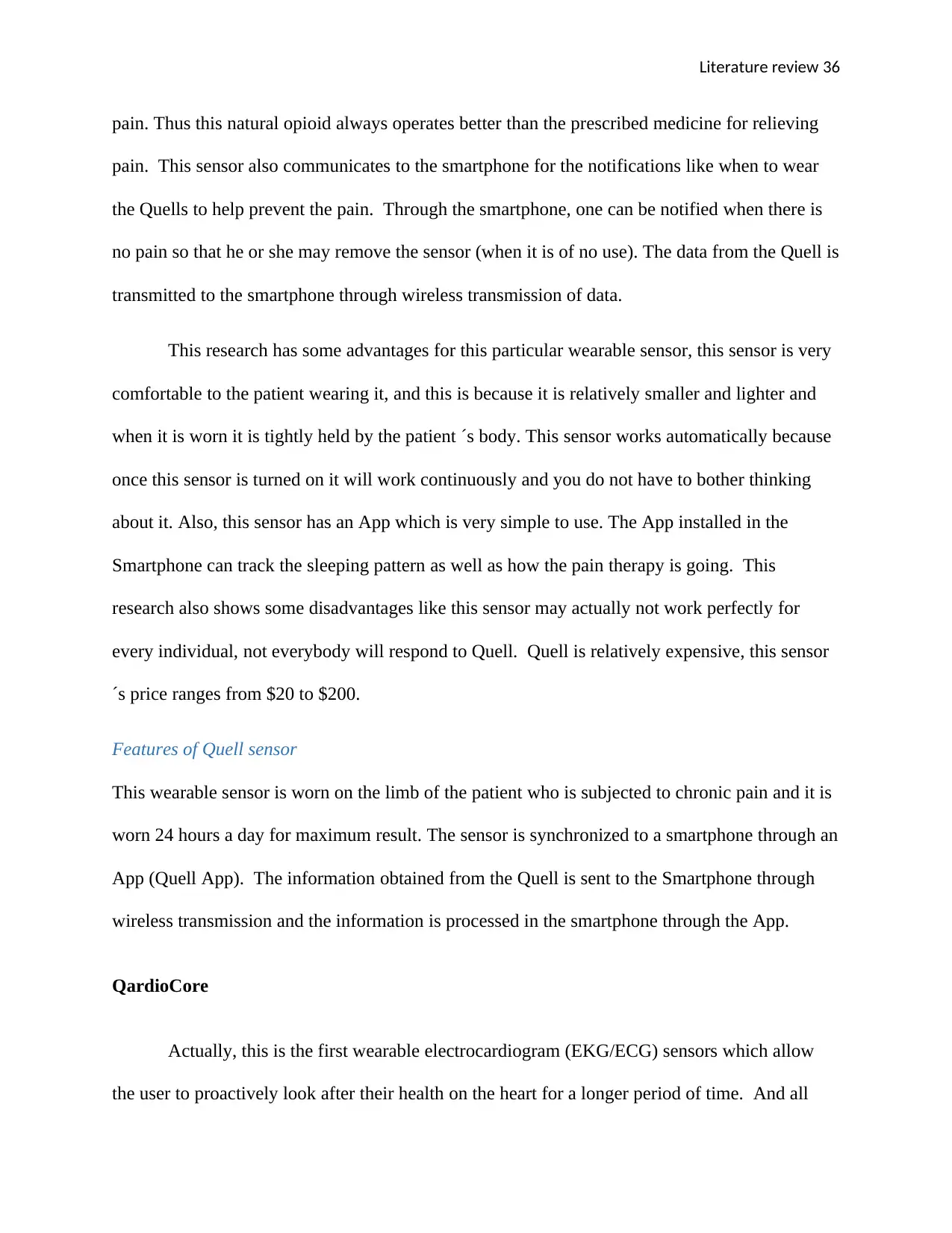
Literature review 36
pain. Thus this natural opioid always operates better than the prescribed medicine for relieving
pain. This sensor also communicates to the smartphone for the notifications like when to wear
the Quells to help prevent the pain. Through the smartphone, one can be notified when there is
no pain so that he or she may remove the sensor (when it is of no use). The data from the Quell is
transmitted to the smartphone through wireless transmission of data.
This research has some advantages for this particular wearable sensor, this sensor is very
comfortable to the patient wearing it, and this is because it is relatively smaller and lighter and
when it is worn it is tightly held by the patient ´s body. This sensor works automatically because
once this sensor is turned on it will work continuously and you do not have to bother thinking
about it. Also, this sensor has an App which is very simple to use. The App installed in the
Smartphone can track the sleeping pattern as well as how the pain therapy is going. This
research also shows some disadvantages like this sensor may actually not work perfectly for
every individual, not everybody will respond to Quell. Quell is relatively expensive, this sensor
´s price ranges from $20 to $200.
Features of Quell sensor
This wearable sensor is worn on the limb of the patient who is subjected to chronic pain and it is
worn 24 hours a day for maximum result. The sensor is synchronized to a smartphone through an
App (Quell App). The information obtained from the Quell is sent to the Smartphone through
wireless transmission and the information is processed in the smartphone through the App.
QardioCore
Actually, this is the first wearable electrocardiogram (EKG/ECG) sensors which allow
the user to proactively look after their health on the heart for a longer period of time. And all
pain. Thus this natural opioid always operates better than the prescribed medicine for relieving
pain. This sensor also communicates to the smartphone for the notifications like when to wear
the Quells to help prevent the pain. Through the smartphone, one can be notified when there is
no pain so that he or she may remove the sensor (when it is of no use). The data from the Quell is
transmitted to the smartphone through wireless transmission of data.
This research has some advantages for this particular wearable sensor, this sensor is very
comfortable to the patient wearing it, and this is because it is relatively smaller and lighter and
when it is worn it is tightly held by the patient ´s body. This sensor works automatically because
once this sensor is turned on it will work continuously and you do not have to bother thinking
about it. Also, this sensor has an App which is very simple to use. The App installed in the
Smartphone can track the sleeping pattern as well as how the pain therapy is going. This
research also shows some disadvantages like this sensor may actually not work perfectly for
every individual, not everybody will respond to Quell. Quell is relatively expensive, this sensor
´s price ranges from $20 to $200.
Features of Quell sensor
This wearable sensor is worn on the limb of the patient who is subjected to chronic pain and it is
worn 24 hours a day for maximum result. The sensor is synchronized to a smartphone through an
App (Quell App). The information obtained from the Quell is sent to the Smartphone through
wireless transmission and the information is processed in the smartphone through the App.
QardioCore
Actually, this is the first wearable electrocardiogram (EKG/ECG) sensors which allow
the user to proactively look after their health on the heart for a longer period of time. And all
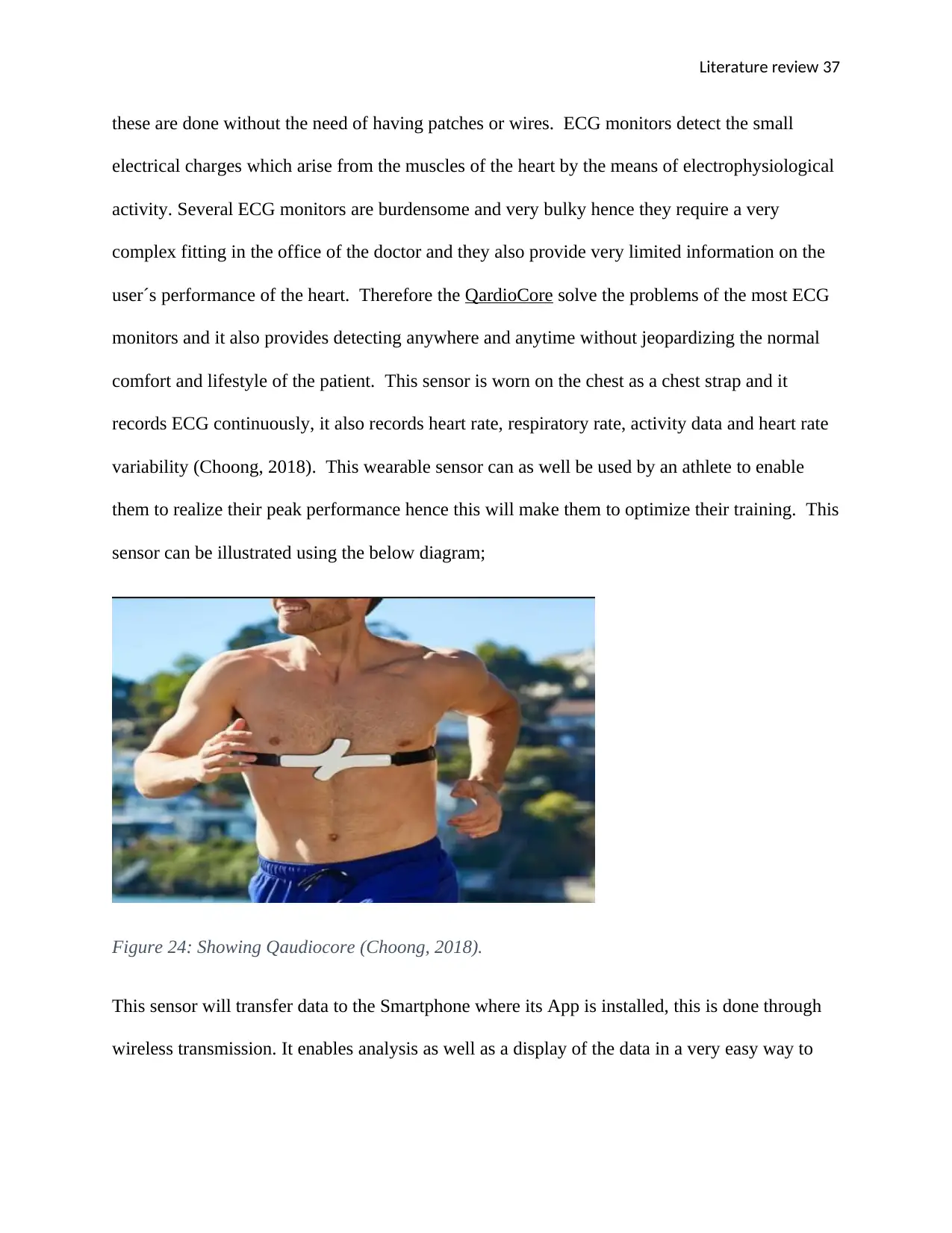
Literature review 37
these are done without the need of having patches or wires. ECG monitors detect the small
electrical charges which arise from the muscles of the heart by the means of electrophysiological
activity. Several ECG monitors are burdensome and very bulky hence they require a very
complex fitting in the office of the doctor and they also provide very limited information on the
user´s performance of the heart. Therefore the QardioCore solve the problems of the most ECG
monitors and it also provides detecting anywhere and anytime without jeopardizing the normal
comfort and lifestyle of the patient. This sensor is worn on the chest as a chest strap and it
records ECG continuously, it also records heart rate, respiratory rate, activity data and heart rate
variability (Choong, 2018). This wearable sensor can as well be used by an athlete to enable
them to realize their peak performance hence this will make them to optimize their training. This
sensor can be illustrated using the below diagram;
Figure 24: Showing Qaudiocore (Choong, 2018).
This sensor will transfer data to the Smartphone where its App is installed, this is done through
wireless transmission. It enables analysis as well as a display of the data in a very easy way to
these are done without the need of having patches or wires. ECG monitors detect the small
electrical charges which arise from the muscles of the heart by the means of electrophysiological
activity. Several ECG monitors are burdensome and very bulky hence they require a very
complex fitting in the office of the doctor and they also provide very limited information on the
user´s performance of the heart. Therefore the QardioCore solve the problems of the most ECG
monitors and it also provides detecting anywhere and anytime without jeopardizing the normal
comfort and lifestyle of the patient. This sensor is worn on the chest as a chest strap and it
records ECG continuously, it also records heart rate, respiratory rate, activity data and heart rate
variability (Choong, 2018). This wearable sensor can as well be used by an athlete to enable
them to realize their peak performance hence this will make them to optimize their training. This
sensor can be illustrated using the below diagram;
Figure 24: Showing Qaudiocore (Choong, 2018).
This sensor will transfer data to the Smartphone where its App is installed, this is done through
wireless transmission. It enables analysis as well as a display of the data in a very easy way to
Paraphrase This Document
Need a fresh take? Get an instant paraphrase of this document with our AI Paraphraser

Literature review 38
view. This sensor in most cases is worn outdoor mostly by the athletes. The sensor is worn
continuously when the athlete wants to analysis his heart rate.
Figure 25: Showing QardioCore with the App in the Smartphone (Choong, 2018).
Apart from ECG, these wearable sensor monitors heart rate variability, respiratory rate and skin
temperature.
Key features of QardioCore
This wearable sensor records continuous ECG wireless, skin temperature, activity tracking, heart
rate and HRV. The sensor tracks complete heart health on the individual´s smartphone, the
senor also gets a medically precise electrocardiograph trace for deeper insight health of the heart
view. This sensor in most cases is worn outdoor mostly by the athletes. The sensor is worn
continuously when the athlete wants to analysis his heart rate.
Figure 25: Showing QardioCore with the App in the Smartphone (Choong, 2018).
Apart from ECG, these wearable sensor monitors heart rate variability, respiratory rate and skin
temperature.
Key features of QardioCore
This wearable sensor records continuous ECG wireless, skin temperature, activity tracking, heart
rate and HRV. The sensor tracks complete heart health on the individual´s smartphone, the
senor also gets a medically precise electrocardiograph trace for deeper insight health of the heart
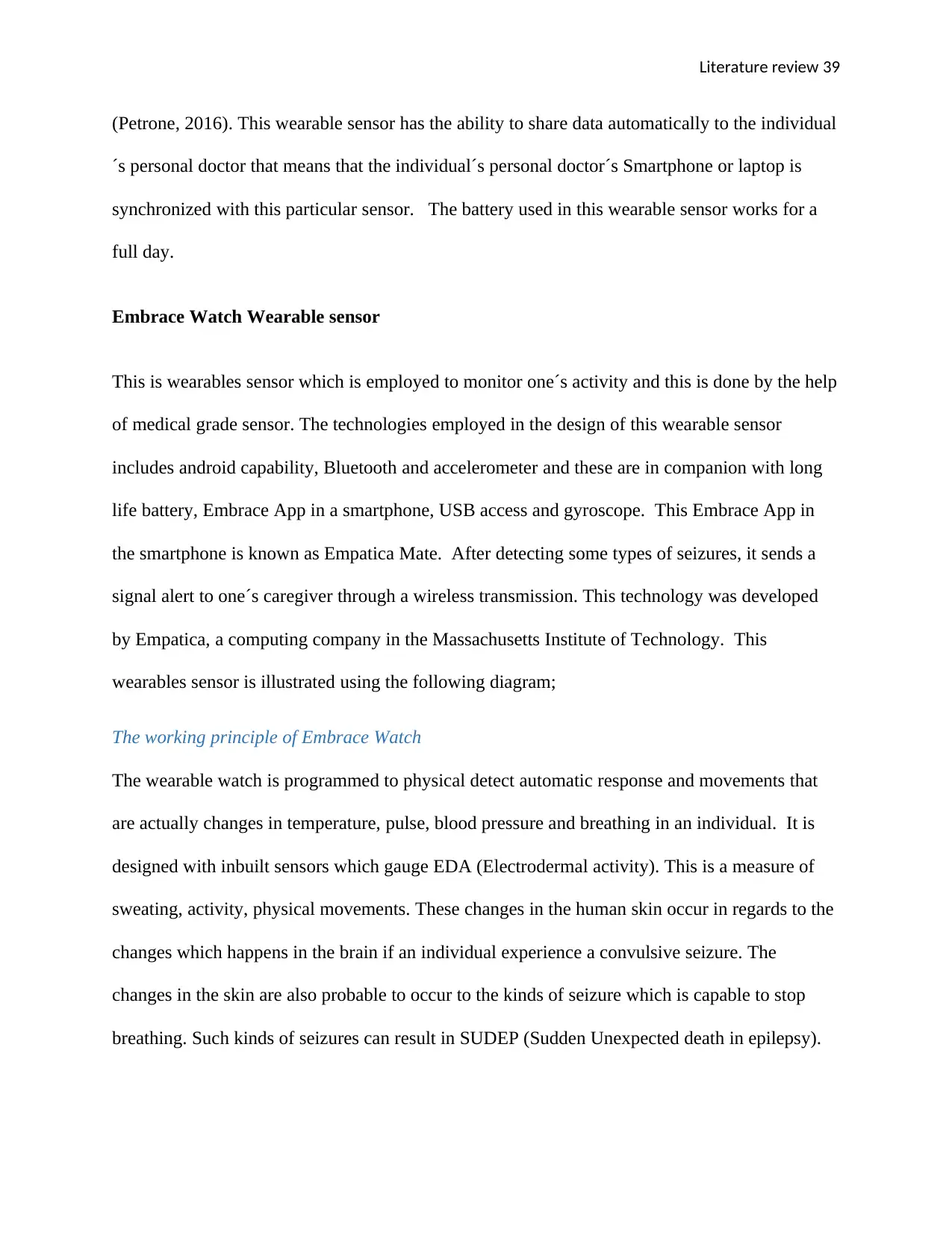
Literature review 39
(Petrone, 2016). This wearable sensor has the ability to share data automatically to the individual
´s personal doctor that means that the individual´s personal doctor´s Smartphone or laptop is
synchronized with this particular sensor. The battery used in this wearable sensor works for a
full day.
Embrace Watch Wearable sensor
This is wearables sensor which is employed to monitor one´s activity and this is done by the help
of medical grade sensor. The technologies employed in the design of this wearable sensor
includes android capability, Bluetooth and accelerometer and these are in companion with long
life battery, Embrace App in a smartphone, USB access and gyroscope. This Embrace App in
the smartphone is known as Empatica Mate. After detecting some types of seizures, it sends a
signal alert to one´s caregiver through a wireless transmission. This technology was developed
by Empatica, a computing company in the Massachusetts Institute of Technology. This
wearables sensor is illustrated using the following diagram;
The working principle of Embrace Watch
The wearable watch is programmed to physical detect automatic response and movements that
are actually changes in temperature, pulse, blood pressure and breathing in an individual. It is
designed with inbuilt sensors which gauge EDA (Electrodermal activity). This is a measure of
sweating, activity, physical movements. These changes in the human skin occur in regards to the
changes which happens in the brain if an individual experience a convulsive seizure. The
changes in the skin are also probable to occur to the kinds of seizure which is capable to stop
breathing. Such kinds of seizures can result in SUDEP (Sudden Unexpected death in epilepsy).
(Petrone, 2016). This wearable sensor has the ability to share data automatically to the individual
´s personal doctor that means that the individual´s personal doctor´s Smartphone or laptop is
synchronized with this particular sensor. The battery used in this wearable sensor works for a
full day.
Embrace Watch Wearable sensor
This is wearables sensor which is employed to monitor one´s activity and this is done by the help
of medical grade sensor. The technologies employed in the design of this wearable sensor
includes android capability, Bluetooth and accelerometer and these are in companion with long
life battery, Embrace App in a smartphone, USB access and gyroscope. This Embrace App in
the smartphone is known as Empatica Mate. After detecting some types of seizures, it sends a
signal alert to one´s caregiver through a wireless transmission. This technology was developed
by Empatica, a computing company in the Massachusetts Institute of Technology. This
wearables sensor is illustrated using the following diagram;
The working principle of Embrace Watch
The wearable watch is programmed to physical detect automatic response and movements that
are actually changes in temperature, pulse, blood pressure and breathing in an individual. It is
designed with inbuilt sensors which gauge EDA (Electrodermal activity). This is a measure of
sweating, activity, physical movements. These changes in the human skin occur in regards to the
changes which happens in the brain if an individual experience a convulsive seizure. The
changes in the skin are also probable to occur to the kinds of seizure which is capable to stop
breathing. Such kinds of seizures can result in SUDEP (Sudden Unexpected death in epilepsy).
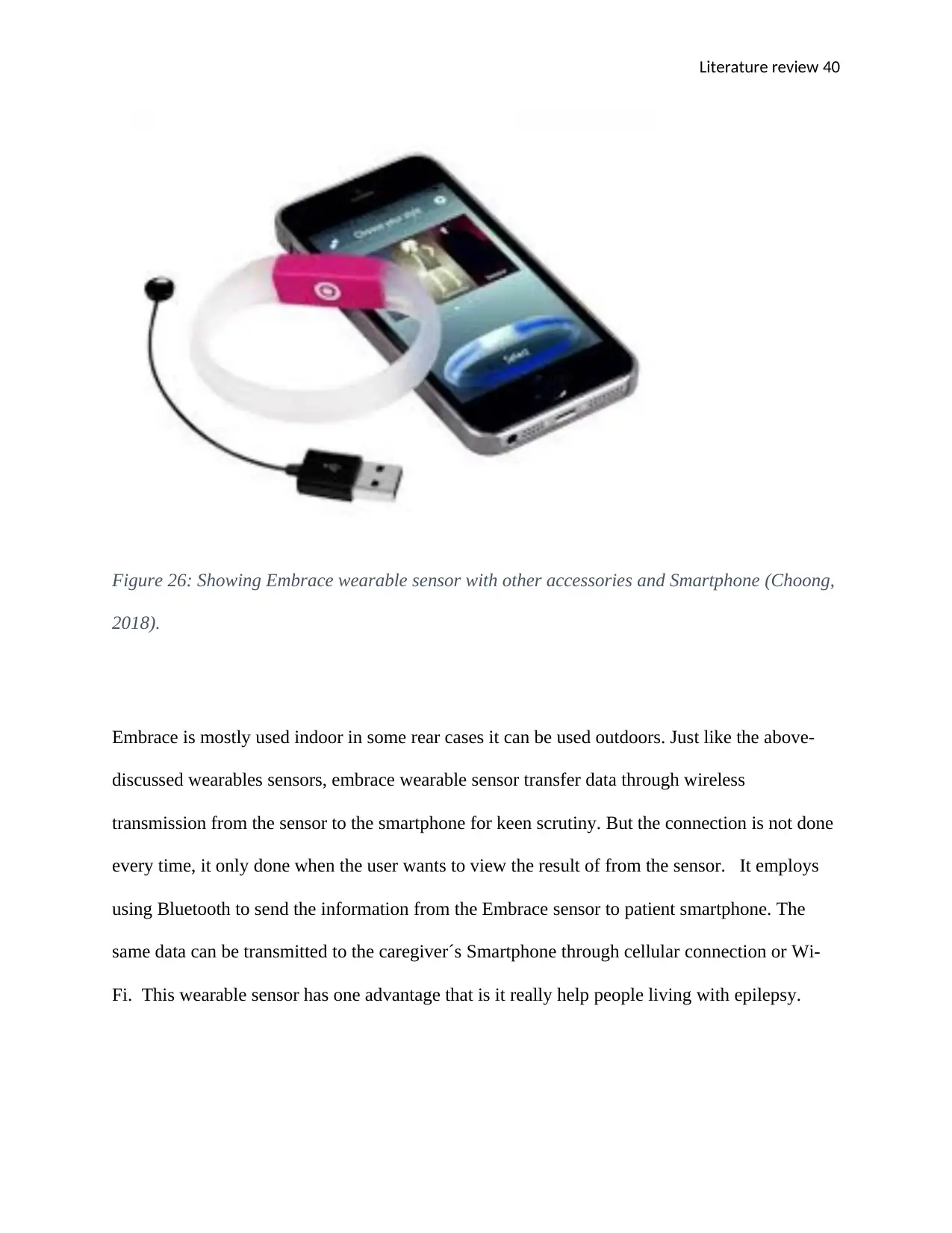
Literature review 40
Figure 26: Showing Embrace wearable sensor with other accessories and Smartphone (Choong,
2018).
Embrace is mostly used indoor in some rear cases it can be used outdoors. Just like the above-
discussed wearables sensors, embrace wearable sensor transfer data through wireless
transmission from the sensor to the smartphone for keen scrutiny. But the connection is not done
every time, it only done when the user wants to view the result of from the sensor. It employs
using Bluetooth to send the information from the Embrace sensor to patient smartphone. The
same data can be transmitted to the caregiver´s Smartphone through cellular connection or Wi-
Fi. This wearable sensor has one advantage that is it really help people living with epilepsy.
Figure 26: Showing Embrace wearable sensor with other accessories and Smartphone (Choong,
2018).
Embrace is mostly used indoor in some rear cases it can be used outdoors. Just like the above-
discussed wearables sensors, embrace wearable sensor transfer data through wireless
transmission from the sensor to the smartphone for keen scrutiny. But the connection is not done
every time, it only done when the user wants to view the result of from the sensor. It employs
using Bluetooth to send the information from the Embrace sensor to patient smartphone. The
same data can be transmitted to the caregiver´s Smartphone through cellular connection or Wi-
Fi. This wearable sensor has one advantage that is it really help people living with epilepsy.
Secure Best Marks with AI Grader
Need help grading? Try our AI Grader for instant feedback on your assignments.
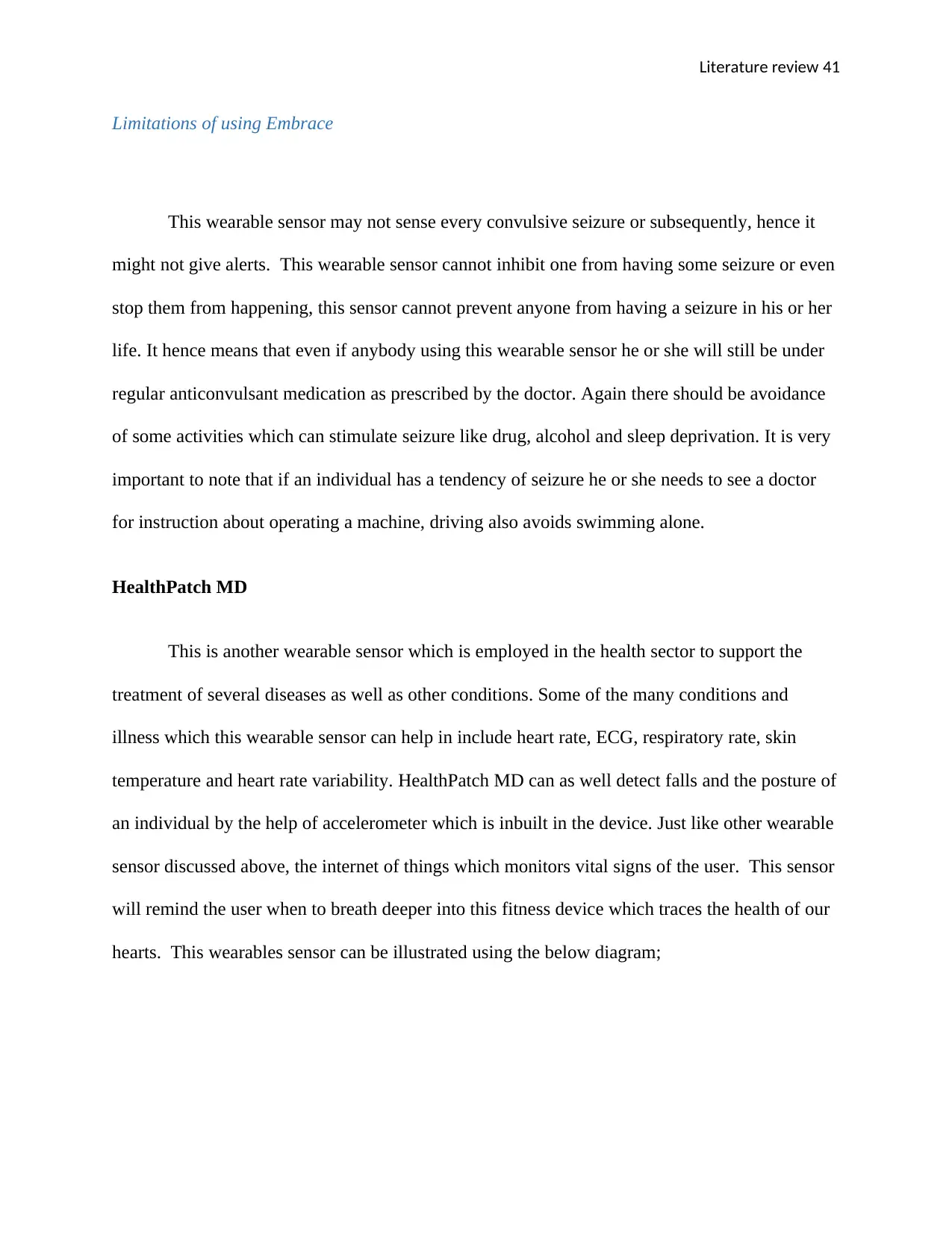
Literature review 41
Limitations of using Embrace
This wearable sensor may not sense every convulsive seizure or subsequently, hence it
might not give alerts. This wearable sensor cannot inhibit one from having some seizure or even
stop them from happening, this sensor cannot prevent anyone from having a seizure in his or her
life. It hence means that even if anybody using this wearable sensor he or she will still be under
regular anticonvulsant medication as prescribed by the doctor. Again there should be avoidance
of some activities which can stimulate seizure like drug, alcohol and sleep deprivation. It is very
important to note that if an individual has a tendency of seizure he or she needs to see a doctor
for instruction about operating a machine, driving also avoids swimming alone.
HealthPatch MD
This is another wearable sensor which is employed in the health sector to support the
treatment of several diseases as well as other conditions. Some of the many conditions and
illness which this wearable sensor can help in include heart rate, ECG, respiratory rate, skin
temperature and heart rate variability. HealthPatch MD can as well detect falls and the posture of
an individual by the help of accelerometer which is inbuilt in the device. Just like other wearable
sensor discussed above, the internet of things which monitors vital signs of the user. This sensor
will remind the user when to breath deeper into this fitness device which traces the health of our
hearts. This wearables sensor can be illustrated using the below diagram;
Limitations of using Embrace
This wearable sensor may not sense every convulsive seizure or subsequently, hence it
might not give alerts. This wearable sensor cannot inhibit one from having some seizure or even
stop them from happening, this sensor cannot prevent anyone from having a seizure in his or her
life. It hence means that even if anybody using this wearable sensor he or she will still be under
regular anticonvulsant medication as prescribed by the doctor. Again there should be avoidance
of some activities which can stimulate seizure like drug, alcohol and sleep deprivation. It is very
important to note that if an individual has a tendency of seizure he or she needs to see a doctor
for instruction about operating a machine, driving also avoids swimming alone.
HealthPatch MD
This is another wearable sensor which is employed in the health sector to support the
treatment of several diseases as well as other conditions. Some of the many conditions and
illness which this wearable sensor can help in include heart rate, ECG, respiratory rate, skin
temperature and heart rate variability. HealthPatch MD can as well detect falls and the posture of
an individual by the help of accelerometer which is inbuilt in the device. Just like other wearable
sensor discussed above, the internet of things which monitors vital signs of the user. This sensor
will remind the user when to breath deeper into this fitness device which traces the health of our
hearts. This wearables sensor can be illustrated using the below diagram;

Literature review 42
Figure 27: Showing HealthPatch MD wearable sensor (Choong, 2018).
HealthPatch MD also has an App installed in a smartphone which is synchronized to the
wearable sensor patched on the skin of an individual. The data connected from the individual
body by the use of HealthPatch MD will then be transmitted wirelessly to the smartphone by the
help of Bluetooth for analysis and viewing. In some cases, the information obtained from
HealthPatch MD can be shared to some family members as well as the doctor but all these are
done with the concert to the patient. HealthPatch MD can be used both as indoor and outdoor for
the health analysis in real time.
Key feature of HealthPatch MD
HealthPatch MD is a wearable sensor which is patched on the skin of an individual to
monitor the health conditions of the patient. The information from the sensor is sent to the user´s
Smartphone through Bluetooth (wireless transmission). The information obtained from the
sensor is processed in the Smartphone processor. HealthPatch MD has an inbuilt battery which
Figure 27: Showing HealthPatch MD wearable sensor (Choong, 2018).
HealthPatch MD also has an App installed in a smartphone which is synchronized to the
wearable sensor patched on the skin of an individual. The data connected from the individual
body by the use of HealthPatch MD will then be transmitted wirelessly to the smartphone by the
help of Bluetooth for analysis and viewing. In some cases, the information obtained from
HealthPatch MD can be shared to some family members as well as the doctor but all these are
done with the concert to the patient. HealthPatch MD can be used both as indoor and outdoor for
the health analysis in real time.
Key feature of HealthPatch MD
HealthPatch MD is a wearable sensor which is patched on the skin of an individual to
monitor the health conditions of the patient. The information from the sensor is sent to the user´s
Smartphone through Bluetooth (wireless transmission). The information obtained from the
sensor is processed in the Smartphone processor. HealthPatch MD has an inbuilt battery which
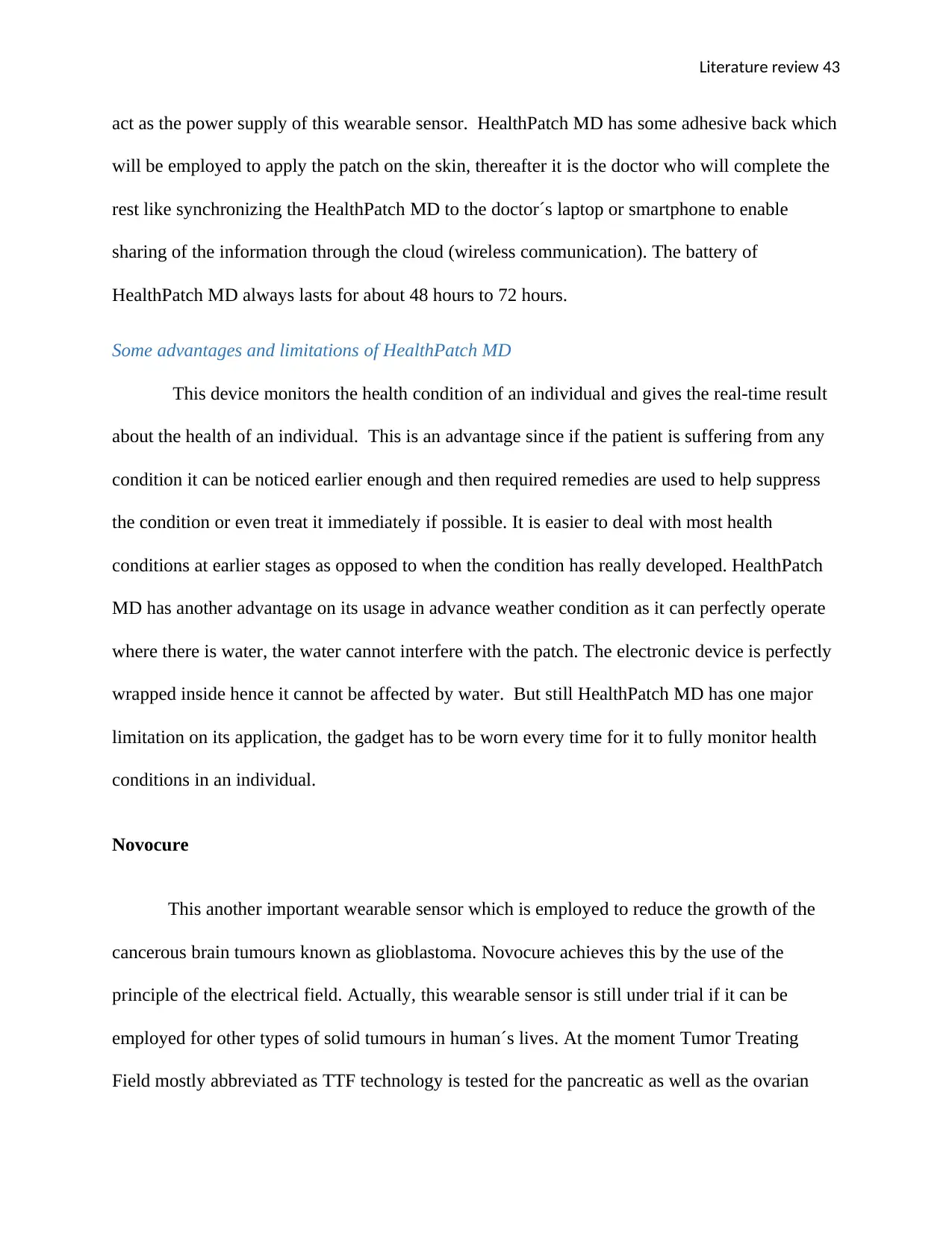
Literature review 43
act as the power supply of this wearable sensor. HealthPatch MD has some adhesive back which
will be employed to apply the patch on the skin, thereafter it is the doctor who will complete the
rest like synchronizing the HealthPatch MD to the doctor´s laptop or smartphone to enable
sharing of the information through the cloud (wireless communication). The battery of
HealthPatch MD always lasts for about 48 hours to 72 hours.
Some advantages and limitations of HealthPatch MD
This device monitors the health condition of an individual and gives the real-time result
about the health of an individual. This is an advantage since if the patient is suffering from any
condition it can be noticed earlier enough and then required remedies are used to help suppress
the condition or even treat it immediately if possible. It is easier to deal with most health
conditions at earlier stages as opposed to when the condition has really developed. HealthPatch
MD has another advantage on its usage in advance weather condition as it can perfectly operate
where there is water, the water cannot interfere with the patch. The electronic device is perfectly
wrapped inside hence it cannot be affected by water. But still HealthPatch MD has one major
limitation on its application, the gadget has to be worn every time for it to fully monitor health
conditions in an individual.
Novocure
This another important wearable sensor which is employed to reduce the growth of the
cancerous brain tumours known as glioblastoma. Novocure achieves this by the use of the
principle of the electrical field. Actually, this wearable sensor is still under trial if it can be
employed for other types of solid tumours in human´s lives. At the moment Tumor Treating
Field mostly abbreviated as TTF technology is tested for the pancreatic as well as the ovarian
act as the power supply of this wearable sensor. HealthPatch MD has some adhesive back which
will be employed to apply the patch on the skin, thereafter it is the doctor who will complete the
rest like synchronizing the HealthPatch MD to the doctor´s laptop or smartphone to enable
sharing of the information through the cloud (wireless communication). The battery of
HealthPatch MD always lasts for about 48 hours to 72 hours.
Some advantages and limitations of HealthPatch MD
This device monitors the health condition of an individual and gives the real-time result
about the health of an individual. This is an advantage since if the patient is suffering from any
condition it can be noticed earlier enough and then required remedies are used to help suppress
the condition or even treat it immediately if possible. It is easier to deal with most health
conditions at earlier stages as opposed to when the condition has really developed. HealthPatch
MD has another advantage on its usage in advance weather condition as it can perfectly operate
where there is water, the water cannot interfere with the patch. The electronic device is perfectly
wrapped inside hence it cannot be affected by water. But still HealthPatch MD has one major
limitation on its application, the gadget has to be worn every time for it to fully monitor health
conditions in an individual.
Novocure
This another important wearable sensor which is employed to reduce the growth of the
cancerous brain tumours known as glioblastoma. Novocure achieves this by the use of the
principle of the electrical field. Actually, this wearable sensor is still under trial if it can be
employed for other types of solid tumours in human´s lives. At the moment Tumor Treating
Field mostly abbreviated as TTF technology is tested for the pancreatic as well as the ovarian
Paraphrase This Document
Need a fresh take? Get an instant paraphrase of this document with our AI Paraphraser
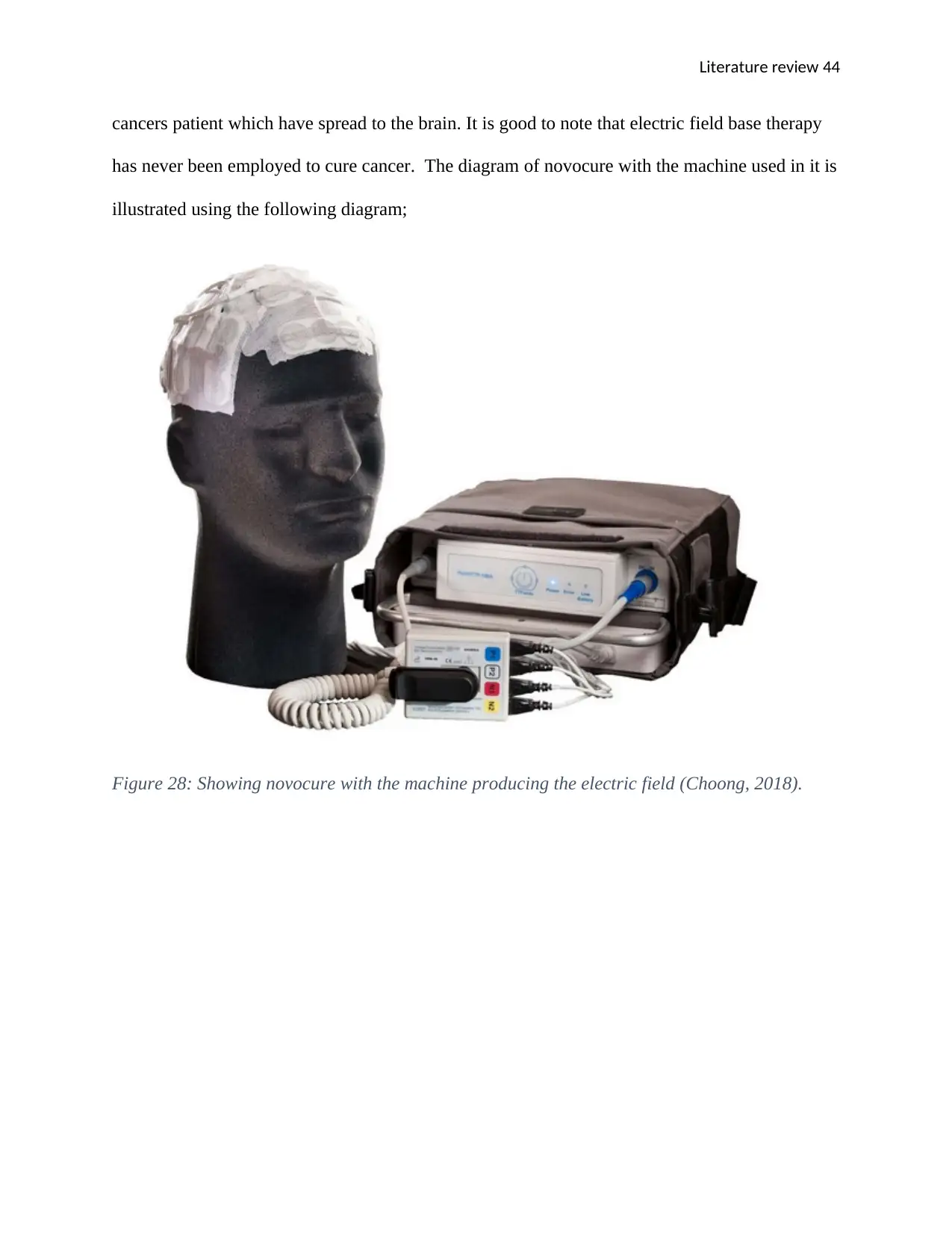
Literature review 44
cancers patient which have spread to the brain. It is good to note that electric field base therapy
has never been employed to cure cancer. The diagram of novocure with the machine used in it is
illustrated using the following diagram;
Figure 28: Showing novocure with the machine producing the electric field (Choong, 2018).
cancers patient which have spread to the brain. It is good to note that electric field base therapy
has never been employed to cure cancer. The diagram of novocure with the machine used in it is
illustrated using the following diagram;
Figure 28: Showing novocure with the machine producing the electric field (Choong, 2018).

Literature review 45
Figure 29: Showing an individual with novocure worn (Choong, 2018).
There are three types of brain cancer which are most common, these includes ; meningiomas
that in most cases benign, we also have intracranial metastases that always spread from other
primary places of the disease in the body and lastly we have glioblastoma multiforme, this is the
most lethal and most common primary in malignant in adult´s brain tumour.
The working principle of novocure
Novocure uses electric fields in its operation to help reduce the growth of brain tumours.
Tumour treating fields are basically low intensity and also intermediate frequency AC electric
field which always act on rapid dividing glioma as well as other cancer tissues. This always
occurs during the cell division in anaphase, telophase and metaphase of the mitotic cell division.
When the AC electric field is produced in the cells of the cancer tumour in the brain, charged
Figure 29: Showing an individual with novocure worn (Choong, 2018).
There are three types of brain cancer which are most common, these includes ; meningiomas
that in most cases benign, we also have intracranial metastases that always spread from other
primary places of the disease in the body and lastly we have glioblastoma multiforme, this is the
most lethal and most common primary in malignant in adult´s brain tumour.
The working principle of novocure
Novocure uses electric fields in its operation to help reduce the growth of brain tumours.
Tumour treating fields are basically low intensity and also intermediate frequency AC electric
field which always act on rapid dividing glioma as well as other cancer tissues. This always
occurs during the cell division in anaphase, telophase and metaphase of the mitotic cell division.
When the AC electric field is produced in the cells of the cancer tumour in the brain, charged

Literature review 46
molecules in the cell will then move to dipolar molecule and motility. The movement is back and
forth making the dipolar to circulate.
AT enough provided frequency, the motility like molecule will hence diminish.
Molecules having higher moments of electrical dipole like tubulin and saptins will be made to
align in the same direction as those of the TTFields in a uniform distribution of the field that is
produced in the cell at the stage of metaphase of mitosis. This distribution will hence interfere
with the formation of the microtubule spindle and the localization of the septin fibre during the
metaphase of the mitosis resulting to the mitotic catastrophe which may result in the death of the
mitotic cell. Most of the cells will be able to move with development to anaphase and telophase
from metaphase. In these phases, cell division will presume an hourglass shape when it begins to
divide into two distinct daughter cells resulting in a non-uniform AC electric field.
The non-uniform electric field makes the polarized components of the cell to migrate
towards cleavage of the two daughter cells hence dividing cell will not be able to properly
divide. The effect of overall antimitotic effect of the tumour treating electric field may ultimately
result in the death of the formation of the abnormal cell dividing with an unequal number of
chromosomes. The whole process of prevention of growth of the cancer cells using this TTField
can be summarized using the following diagram;
molecules in the cell will then move to dipolar molecule and motility. The movement is back and
forth making the dipolar to circulate.
AT enough provided frequency, the motility like molecule will hence diminish.
Molecules having higher moments of electrical dipole like tubulin and saptins will be made to
align in the same direction as those of the TTFields in a uniform distribution of the field that is
produced in the cell at the stage of metaphase of mitosis. This distribution will hence interfere
with the formation of the microtubule spindle and the localization of the septin fibre during the
metaphase of the mitosis resulting to the mitotic catastrophe which may result in the death of the
mitotic cell. Most of the cells will be able to move with development to anaphase and telophase
from metaphase. In these phases, cell division will presume an hourglass shape when it begins to
divide into two distinct daughter cells resulting in a non-uniform AC electric field.
The non-uniform electric field makes the polarized components of the cell to migrate
towards cleavage of the two daughter cells hence dividing cell will not be able to properly
divide. The effect of overall antimitotic effect of the tumour treating electric field may ultimately
result in the death of the formation of the abnormal cell dividing with an unequal number of
chromosomes. The whole process of prevention of growth of the cancer cells using this TTField
can be summarized using the following diagram;
Secure Best Marks with AI Grader
Need help grading? Try our AI Grader for instant feedback on your assignments.
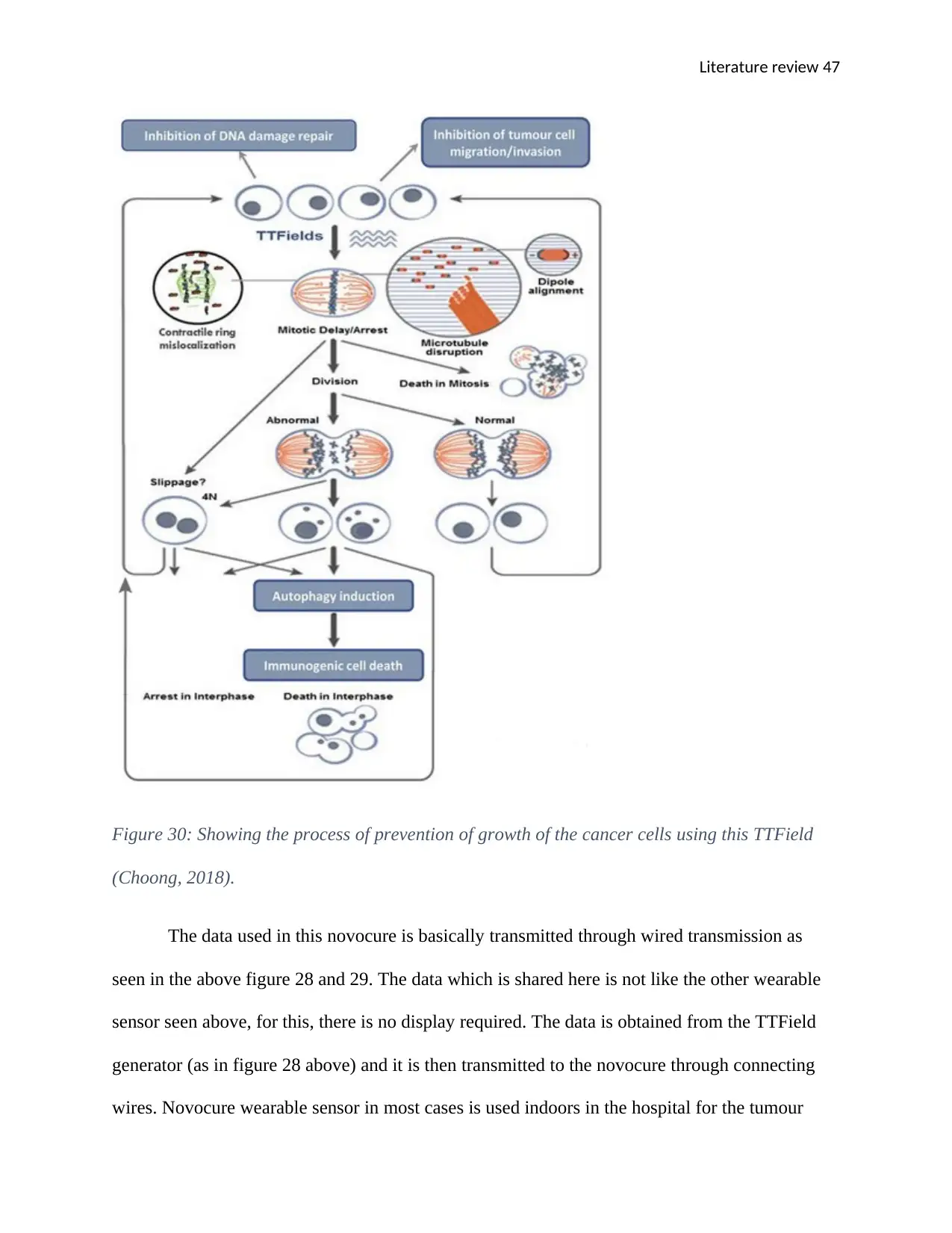
Literature review 47
Figure 30: Showing the process of prevention of growth of the cancer cells using this TTField
(Choong, 2018).
The data used in this novocure is basically transmitted through wired transmission as
seen in the above figure 28 and 29. The data which is shared here is not like the other wearable
sensor seen above, for this, there is no display required. The data is obtained from the TTField
generator (as in figure 28 above) and it is then transmitted to the novocure through connecting
wires. Novocure wearable sensor in most cases is used indoors in the hospital for the tumour
Figure 30: Showing the process of prevention of growth of the cancer cells using this TTField
(Choong, 2018).
The data used in this novocure is basically transmitted through wired transmission as
seen in the above figure 28 and 29. The data which is shared here is not like the other wearable
sensor seen above, for this, there is no display required. The data is obtained from the TTField
generator (as in figure 28 above) and it is then transmitted to the novocure through connecting
wires. Novocure wearable sensor in most cases is used indoors in the hospital for the tumour
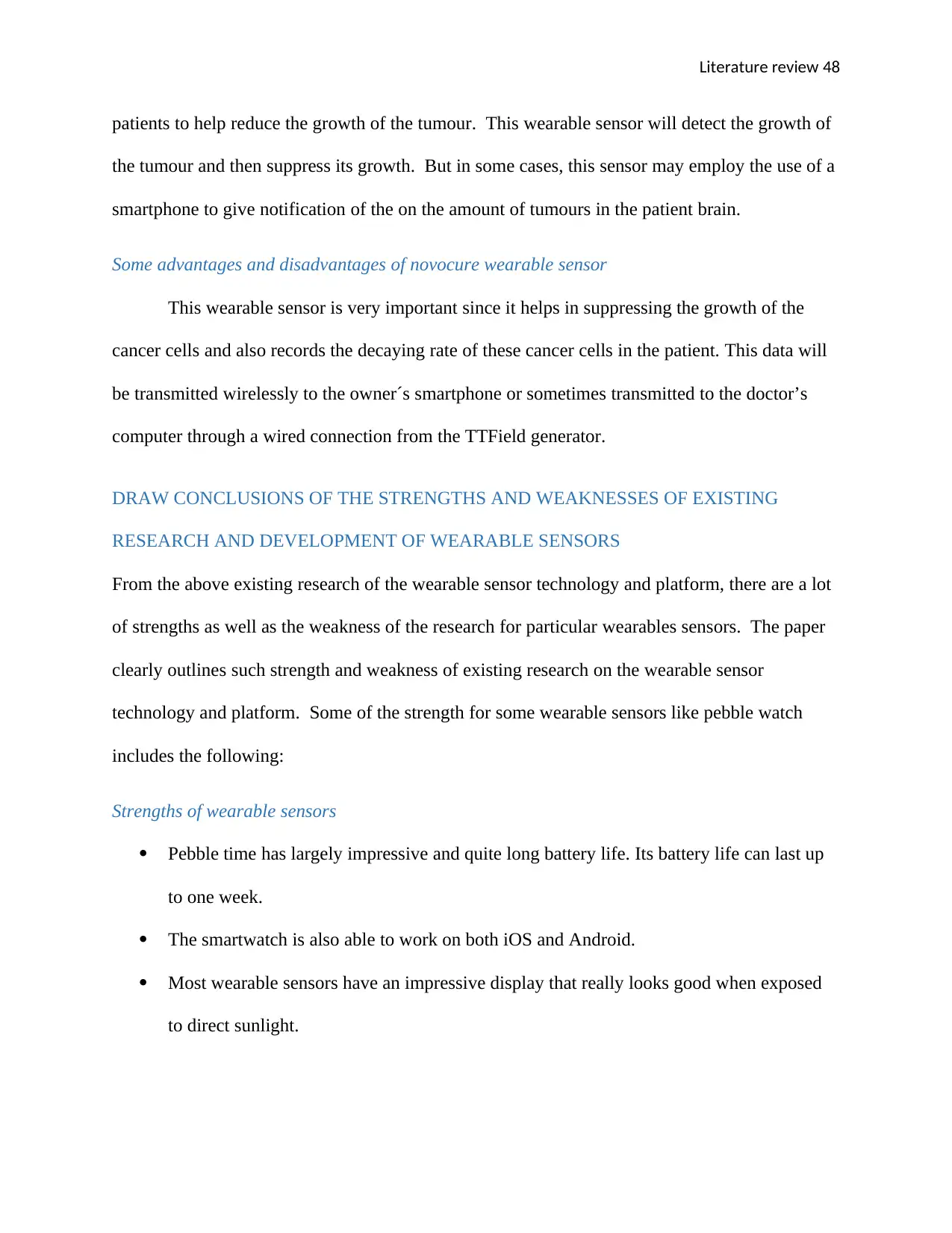
Literature review 48
patients to help reduce the growth of the tumour. This wearable sensor will detect the growth of
the tumour and then suppress its growth. But in some cases, this sensor may employ the use of a
smartphone to give notification of the on the amount of tumours in the patient brain.
Some advantages and disadvantages of novocure wearable sensor
This wearable sensor is very important since it helps in suppressing the growth of the
cancer cells and also records the decaying rate of these cancer cells in the patient. This data will
be transmitted wirelessly to the owner´s smartphone or sometimes transmitted to the doctor’s
computer through a wired connection from the TTField generator.
DRAW CONCLUSIONS OF THE STRENGTHS AND WEAKNESSES OF EXISTING
RESEARCH AND DEVELOPMENT OF WEARABLE SENSORS
From the above existing research of the wearable sensor technology and platform, there are a lot
of strengths as well as the weakness of the research for particular wearables sensors. The paper
clearly outlines such strength and weakness of existing research on the wearable sensor
technology and platform. Some of the strength for some wearable sensors like pebble watch
includes the following:
Strengths of wearable sensors
Pebble time has largely impressive and quite long battery life. Its battery life can last up
to one week.
The smartwatch is also able to work on both iOS and Android.
Most wearable sensors have an impressive display that really looks good when exposed
to direct sunlight.
patients to help reduce the growth of the tumour. This wearable sensor will detect the growth of
the tumour and then suppress its growth. But in some cases, this sensor may employ the use of a
smartphone to give notification of the on the amount of tumours in the patient brain.
Some advantages and disadvantages of novocure wearable sensor
This wearable sensor is very important since it helps in suppressing the growth of the
cancer cells and also records the decaying rate of these cancer cells in the patient. This data will
be transmitted wirelessly to the owner´s smartphone or sometimes transmitted to the doctor’s
computer through a wired connection from the TTField generator.
DRAW CONCLUSIONS OF THE STRENGTHS AND WEAKNESSES OF EXISTING
RESEARCH AND DEVELOPMENT OF WEARABLE SENSORS
From the above existing research of the wearable sensor technology and platform, there are a lot
of strengths as well as the weakness of the research for particular wearables sensors. The paper
clearly outlines such strength and weakness of existing research on the wearable sensor
technology and platform. Some of the strength for some wearable sensors like pebble watch
includes the following:
Strengths of wearable sensors
Pebble time has largely impressive and quite long battery life. Its battery life can last up
to one week.
The smartwatch is also able to work on both iOS and Android.
Most wearable sensors have an impressive display that really looks good when exposed
to direct sunlight.

Literature review 49
Most wearable sensors have a colour e-paper technology that brings an always on
display. It is an impressive display that looks awesome when under direct sunlight.
Wearable sensors definitely have a huge app library.
They are equipped with a microphone that brings up the ability to provide quick and
faster voice replies as well as memos.
They are also equipped with an exceptional timeline interface that has the ability to
decrease app clutter, therefore, making it quite easy to acquire the information that is
needed.
Most of the wearable sensors have great potential for extra features through smart straps.
While some of the weakness for existing research on most wearable are as below;
Weaknesses of most wearable sensor
Despite being able to work on ios, its functionality is a bit limited.
They only as the ability to choose from just one app for the activity of tracking.
The voice function is limited is that it does not extend to Siri or Google Now.
For all the features that it offers, the price does appear to be a bit higher and the users do
not really get full value as they may use.
There is also another strength of the existing reach on the wearable sensor which actually helps
most people in the society. Some of these may include; the wearable sensors has for sure
increased the health sector because most of them help to reduce improve the health conditions of
patients as well as those who are okay. For example, wearable sensors like iTBra help a lot to
detect breast cancer hence it possible to be treated before it develops. Others like Aira can enable
a blind individual to walk and manoeuvre by himself without being helped by anyone around
him or her. Others like FitBit help an individual to exercise perfectly without having a gym
Most wearable sensors have a colour e-paper technology that brings an always on
display. It is an impressive display that looks awesome when under direct sunlight.
Wearable sensors definitely have a huge app library.
They are equipped with a microphone that brings up the ability to provide quick and
faster voice replies as well as memos.
They are also equipped with an exceptional timeline interface that has the ability to
decrease app clutter, therefore, making it quite easy to acquire the information that is
needed.
Most of the wearable sensors have great potential for extra features through smart straps.
While some of the weakness for existing research on most wearable are as below;
Weaknesses of most wearable sensor
Despite being able to work on ios, its functionality is a bit limited.
They only as the ability to choose from just one app for the activity of tracking.
The voice function is limited is that it does not extend to Siri or Google Now.
For all the features that it offers, the price does appear to be a bit higher and the users do
not really get full value as they may use.
There is also another strength of the existing reach on the wearable sensor which actually helps
most people in the society. Some of these may include; the wearable sensors has for sure
increased the health sector because most of them help to reduce improve the health conditions of
patients as well as those who are okay. For example, wearable sensors like iTBra help a lot to
detect breast cancer hence it possible to be treated before it develops. Others like Aira can enable
a blind individual to walk and manoeuvre by himself without being helped by anyone around
him or her. Others like FitBit help an individual to exercise perfectly without having a gym
Paraphrase This Document
Need a fresh take? Get an instant paraphrase of this document with our AI Paraphraser
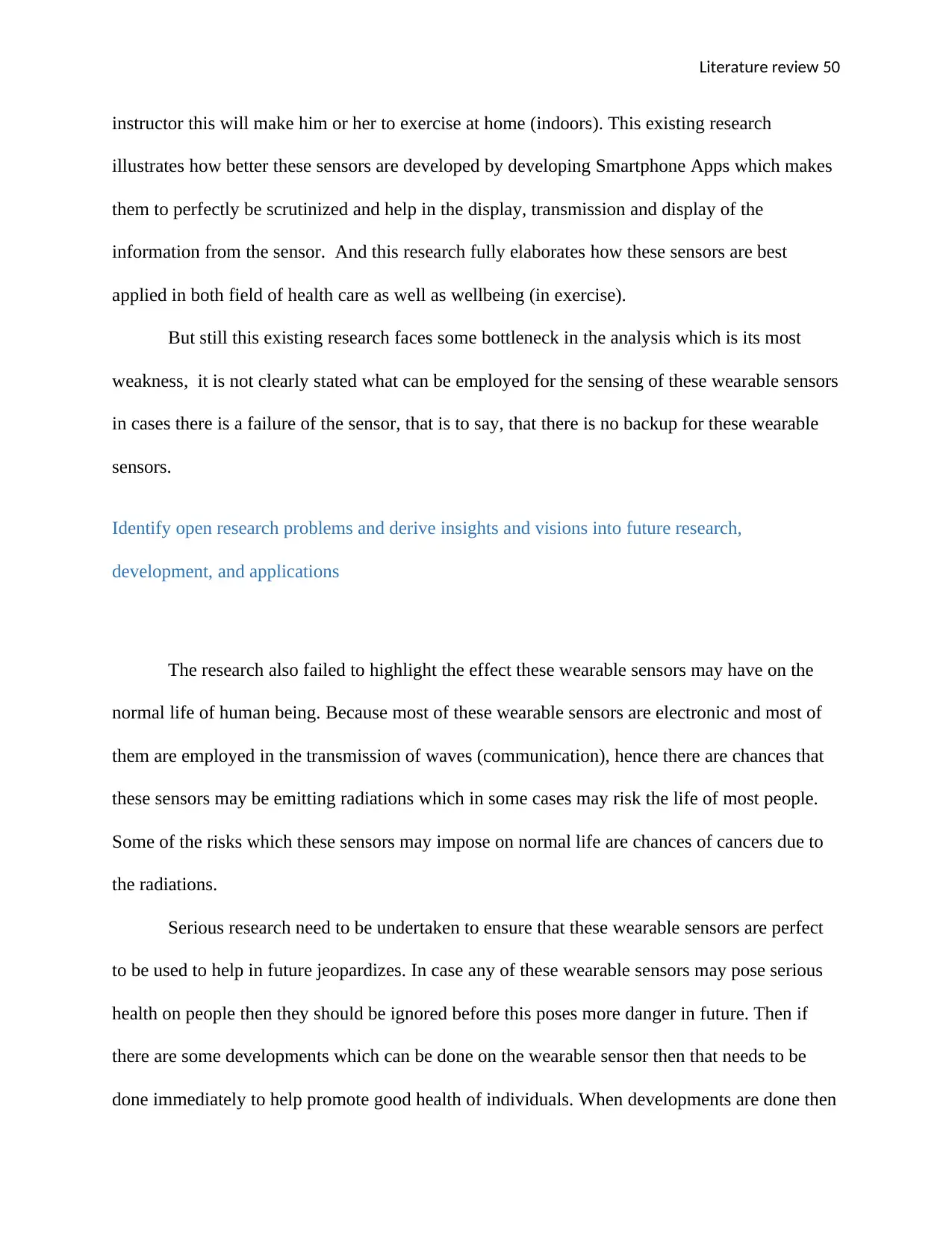
Literature review 50
instructor this will make him or her to exercise at home (indoors). This existing research
illustrates how better these sensors are developed by developing Smartphone Apps which makes
them to perfectly be scrutinized and help in the display, transmission and display of the
information from the sensor. And this research fully elaborates how these sensors are best
applied in both field of health care as well as wellbeing (in exercise).
But still this existing research faces some bottleneck in the analysis which is its most
weakness, it is not clearly stated what can be employed for the sensing of these wearable sensors
in cases there is a failure of the sensor, that is to say, that there is no backup for these wearable
sensors.
Identify open research problems and derive insights and visions into future research,
development, and applications
The research also failed to highlight the effect these wearable sensors may have on the
normal life of human being. Because most of these wearable sensors are electronic and most of
them are employed in the transmission of waves (communication), hence there are chances that
these sensors may be emitting radiations which in some cases may risk the life of most people.
Some of the risks which these sensors may impose on normal life are chances of cancers due to
the radiations.
Serious research need to be undertaken to ensure that these wearable sensors are perfect
to be used to help in future jeopardizes. In case any of these wearable sensors may pose serious
health on people then they should be ignored before this poses more danger in future. Then if
there are some developments which can be done on the wearable sensor then that needs to be
done immediately to help promote good health of individuals. When developments are done then
instructor this will make him or her to exercise at home (indoors). This existing research
illustrates how better these sensors are developed by developing Smartphone Apps which makes
them to perfectly be scrutinized and help in the display, transmission and display of the
information from the sensor. And this research fully elaborates how these sensors are best
applied in both field of health care as well as wellbeing (in exercise).
But still this existing research faces some bottleneck in the analysis which is its most
weakness, it is not clearly stated what can be employed for the sensing of these wearable sensors
in cases there is a failure of the sensor, that is to say, that there is no backup for these wearable
sensors.
Identify open research problems and derive insights and visions into future research,
development, and applications
The research also failed to highlight the effect these wearable sensors may have on the
normal life of human being. Because most of these wearable sensors are electronic and most of
them are employed in the transmission of waves (communication), hence there are chances that
these sensors may be emitting radiations which in some cases may risk the life of most people.
Some of the risks which these sensors may impose on normal life are chances of cancers due to
the radiations.
Serious research need to be undertaken to ensure that these wearable sensors are perfect
to be used to help in future jeopardizes. In case any of these wearable sensors may pose serious
health on people then they should be ignored before this poses more danger in future. Then if
there are some developments which can be done on the wearable sensor then that needs to be
done immediately to help promote good health of individuals. When developments are done then

Literature review 51
these wearable sensors would be announced fit for application and then they will be perfectly
used to promote health sector.
Speculate, conceive and design a novel sensing architecture and platform.
In the future, more sensors can be developed using the same design notion of the above
discussed wearable sensors. These sensors may help in promoting security in most homes which
will be in most smart homes. Sensors can be employed in a smart home to enable protect the
home from terrorists among other unauthorized intruders in our homes. And for the health care,
some sensors can be employed which operates like telemetry sensors to help scan any disease in
an individual and send information to the hospital with the details of an individual. The person
will then be called by the doctor and being informed of the kind of illness he is suffering from.
These sensors would be able to detect any type of infection in human at their early stages which
make them easier to be treated.
Even though there are some speculations of smart cities current but by the use of sensor
the existing smart cities can still be made better. When these sensors are employed, it would be
very easy in detecting which streets and avenues are experiencing traffic jam so that people
should avoid such roads to help them from wasting more of their times on the road. The
speculated smart cities would be able to spot places with robbers as well as terrorists and then
alerts the police as well as the intelligence authority. This will help to promote security in the
cities. In case of an accident, there should be a sensor which notifies the driver when he is about
to be involved in an accident through the sensor there should be a remedy for that to help avoid
these wearable sensors would be announced fit for application and then they will be perfectly
used to promote health sector.
Speculate, conceive and design a novel sensing architecture and platform.
In the future, more sensors can be developed using the same design notion of the above
discussed wearable sensors. These sensors may help in promoting security in most homes which
will be in most smart homes. Sensors can be employed in a smart home to enable protect the
home from terrorists among other unauthorized intruders in our homes. And for the health care,
some sensors can be employed which operates like telemetry sensors to help scan any disease in
an individual and send information to the hospital with the details of an individual. The person
will then be called by the doctor and being informed of the kind of illness he is suffering from.
These sensors would be able to detect any type of infection in human at their early stages which
make them easier to be treated.
Even though there are some speculations of smart cities current but by the use of sensor
the existing smart cities can still be made better. When these sensors are employed, it would be
very easy in detecting which streets and avenues are experiencing traffic jam so that people
should avoid such roads to help them from wasting more of their times on the road. The
speculated smart cities would be able to spot places with robbers as well as terrorists and then
alerts the police as well as the intelligence authority. This will help to promote security in the
cities. In case of an accident, there should be a sensor which notifies the driver when he is about
to be involved in an accident through the sensor there should be a remedy for that to help avoid
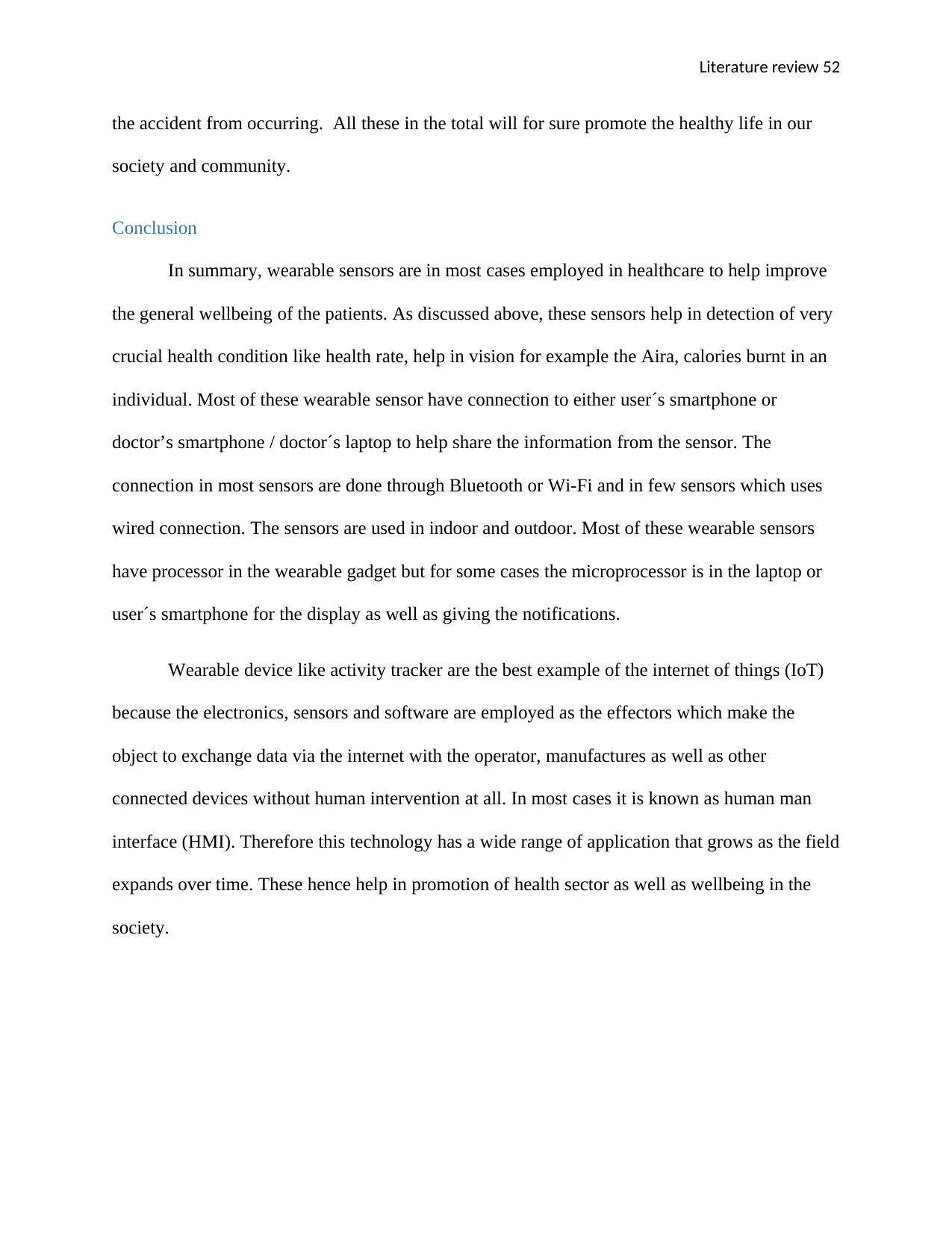
Literature review 52
the accident from occurring. All these in the total will for sure promote the healthy life in our
society and community.
Conclusion
In summary, wearable sensors are in most cases employed in healthcare to help improve
the general wellbeing of the patients. As discussed above, these sensors help in detection of very
crucial health condition like health rate, help in vision for example the Aira, calories burnt in an
individual. Most of these wearable sensor have connection to either user´s smartphone or
doctor’s smartphone / doctor´s laptop to help share the information from the sensor. The
connection in most sensors are done through Bluetooth or Wi-Fi and in few sensors which uses
wired connection. The sensors are used in indoor and outdoor. Most of these wearable sensors
have processor in the wearable gadget but for some cases the microprocessor is in the laptop or
user´s smartphone for the display as well as giving the notifications.
Wearable device like activity tracker are the best example of the internet of things (IoT)
because the electronics, sensors and software are employed as the effectors which make the
object to exchange data via the internet with the operator, manufactures as well as other
connected devices without human intervention at all. In most cases it is known as human man
interface (HMI). Therefore this technology has a wide range of application that grows as the field
expands over time. These hence help in promotion of health sector as well as wellbeing in the
society.
the accident from occurring. All these in the total will for sure promote the healthy life in our
society and community.
Conclusion
In summary, wearable sensors are in most cases employed in healthcare to help improve
the general wellbeing of the patients. As discussed above, these sensors help in detection of very
crucial health condition like health rate, help in vision for example the Aira, calories burnt in an
individual. Most of these wearable sensor have connection to either user´s smartphone or
doctor’s smartphone / doctor´s laptop to help share the information from the sensor. The
connection in most sensors are done through Bluetooth or Wi-Fi and in few sensors which uses
wired connection. The sensors are used in indoor and outdoor. Most of these wearable sensors
have processor in the wearable gadget but for some cases the microprocessor is in the laptop or
user´s smartphone for the display as well as giving the notifications.
Wearable device like activity tracker are the best example of the internet of things (IoT)
because the electronics, sensors and software are employed as the effectors which make the
object to exchange data via the internet with the operator, manufactures as well as other
connected devices without human intervention at all. In most cases it is known as human man
interface (HMI). Therefore this technology has a wide range of application that grows as the field
expands over time. These hence help in promotion of health sector as well as wellbeing in the
society.
Secure Best Marks with AI Grader
Need help grading? Try our AI Grader for instant feedback on your assignments.

Literature review 53
Bibliography
Ammari, H. (2013). The Art of Wireless Sensor Networks: Volume 2: Advanced Topics and Applications
(2nd ed.). Leicester: Springer Science & Business Media. Retrieved from
https://books.google.co.ke/books?
id=Ady4BAAAQBAJ&dq=State+or+arts+for+wearable+sensors&source=gbs_navlinks_s
Bases, S. S. (2011). Sensor Systems for Biological Agent Attacks (2nd ed.). Hull: National Academies Press.
Retrieved from https://books.google.co.ke/books?
id=G0CcAgAAQBAJ&dq=Aira+sensor&source=gbs_navlinks_s
Choong, L. W. (2018). NETWORKING 2008 Ad Hoc and Sensor Networks, Wireless Networks, Next
Generation Internet (3rd ed.). Florida: Springer. Retrieved from
https://books.google.co.ke/books?id=BXNqCQAAQBAJ&dq=Aira+sensor&source=gbs_navlinks_s
Lymberis, A. (2014). Wearable Ehealth Systems for Personalised Health Management: State of the Art
and Future Challenges (3rd ed.). London: IOS Press. Retrieved from
https://books.google.co.ke/books?
id=fQwZvwSuMrcC&dq=State+or+arts+for+wearable+sensors&source=gbs_navlinks_s
MacManus, R. (2016). Trackers (2nd ed.). Stoke: David Bateman Ltd. Retrieved from
https://books.google.co.ke/books?id=0AihBwAAQBAJ&dq=Fitbit+Aria&source=gbs_navlinks_s
Mähönen, P. (2010). International Workshop on Wearable and Implantable Body Sensor Networks (1st
ed.). New York: Springer Science & Business Media. Retrieved from
https://books.google.co.ke/books?
id=zxaO1RBfhfQC&dq=State+or+arts+for+wearable+sensors&source=gbs_navlinks_s
Management Association, I. R. (2018). Wearable Technologies: Concepts, Methodologies, Tools, and
Applications: Concepts, Methodologies, Tools, and Applications (3rd ed.). London: IGI Global.
Retrieved from https://books.google.co.ke/books?
id=ND1RDwAAQBAJ&dq=State+or+arts+for+wearable+sensors&source=gbs_navlinks_s
Martinsanz, G. P. (2018). State-of-the-Art Sensors Technology in Spain (3rd ed.). Madrid: MDPI.
Retrieved from https://books.google.co.ke/books?
id=PoFcDwAAQBAJ&pg=PA311&dq=State+or+arts+for+wearable+sensors&hl=en&sa=X&ved=0a
hUKEwiP6-3fisjhAhWHtIsKHQ7dC-MQ6AEILDAB#v=onepage&q=State%20or%20arts%20for
%20wearable%20sensors&f=false
Michelson, D. (2018). Fitbit Versa: An Easy Guide to the Best Features (1st ed.). Hull: First Rank
Publishing. Retrieved from https://books.google.co.ke/books?
id=CAVfDwAAQBAJ&dq=Fitbit+Aria&source=gbs_navlinks_s
Orlandini, A. (2017). State of the Art in AI Applied to Ambient Intelligence (1st ed.). Chicago: IOS Press.
Retrieved from https://books.google.co.ke/books?id=lvA-
DwAAQBAJ&dq=State+or+arts+for+wearable+sensors&source=gbs_navlinks_s
Petrone, N. (2016). Sensors and Wearable Technologies in Sport: Technologies, Trends and Approaches
for Implementation (2nd ed.). Sydney: Springer. Retrieved from
Bibliography
Ammari, H. (2013). The Art of Wireless Sensor Networks: Volume 2: Advanced Topics and Applications
(2nd ed.). Leicester: Springer Science & Business Media. Retrieved from
https://books.google.co.ke/books?
id=Ady4BAAAQBAJ&dq=State+or+arts+for+wearable+sensors&source=gbs_navlinks_s
Bases, S. S. (2011). Sensor Systems for Biological Agent Attacks (2nd ed.). Hull: National Academies Press.
Retrieved from https://books.google.co.ke/books?
id=G0CcAgAAQBAJ&dq=Aira+sensor&source=gbs_navlinks_s
Choong, L. W. (2018). NETWORKING 2008 Ad Hoc and Sensor Networks, Wireless Networks, Next
Generation Internet (3rd ed.). Florida: Springer. Retrieved from
https://books.google.co.ke/books?id=BXNqCQAAQBAJ&dq=Aira+sensor&source=gbs_navlinks_s
Lymberis, A. (2014). Wearable Ehealth Systems for Personalised Health Management: State of the Art
and Future Challenges (3rd ed.). London: IOS Press. Retrieved from
https://books.google.co.ke/books?
id=fQwZvwSuMrcC&dq=State+or+arts+for+wearable+sensors&source=gbs_navlinks_s
MacManus, R. (2016). Trackers (2nd ed.). Stoke: David Bateman Ltd. Retrieved from
https://books.google.co.ke/books?id=0AihBwAAQBAJ&dq=Fitbit+Aria&source=gbs_navlinks_s
Mähönen, P. (2010). International Workshop on Wearable and Implantable Body Sensor Networks (1st
ed.). New York: Springer Science & Business Media. Retrieved from
https://books.google.co.ke/books?
id=zxaO1RBfhfQC&dq=State+or+arts+for+wearable+sensors&source=gbs_navlinks_s
Management Association, I. R. (2018). Wearable Technologies: Concepts, Methodologies, Tools, and
Applications: Concepts, Methodologies, Tools, and Applications (3rd ed.). London: IGI Global.
Retrieved from https://books.google.co.ke/books?
id=ND1RDwAAQBAJ&dq=State+or+arts+for+wearable+sensors&source=gbs_navlinks_s
Martinsanz, G. P. (2018). State-of-the-Art Sensors Technology in Spain (3rd ed.). Madrid: MDPI.
Retrieved from https://books.google.co.ke/books?
id=PoFcDwAAQBAJ&pg=PA311&dq=State+or+arts+for+wearable+sensors&hl=en&sa=X&ved=0a
hUKEwiP6-3fisjhAhWHtIsKHQ7dC-MQ6AEILDAB#v=onepage&q=State%20or%20arts%20for
%20wearable%20sensors&f=false
Michelson, D. (2018). Fitbit Versa: An Easy Guide to the Best Features (1st ed.). Hull: First Rank
Publishing. Retrieved from https://books.google.co.ke/books?
id=CAVfDwAAQBAJ&dq=Fitbit+Aria&source=gbs_navlinks_s
Orlandini, A. (2017). State of the Art in AI Applied to Ambient Intelligence (1st ed.). Chicago: IOS Press.
Retrieved from https://books.google.co.ke/books?id=lvA-
DwAAQBAJ&dq=State+or+arts+for+wearable+sensors&source=gbs_navlinks_s
Petrone, N. (2016). Sensors and Wearable Technologies in Sport: Technologies, Trends and Approaches
for Implementation (2nd ed.). Sydney: Springer. Retrieved from
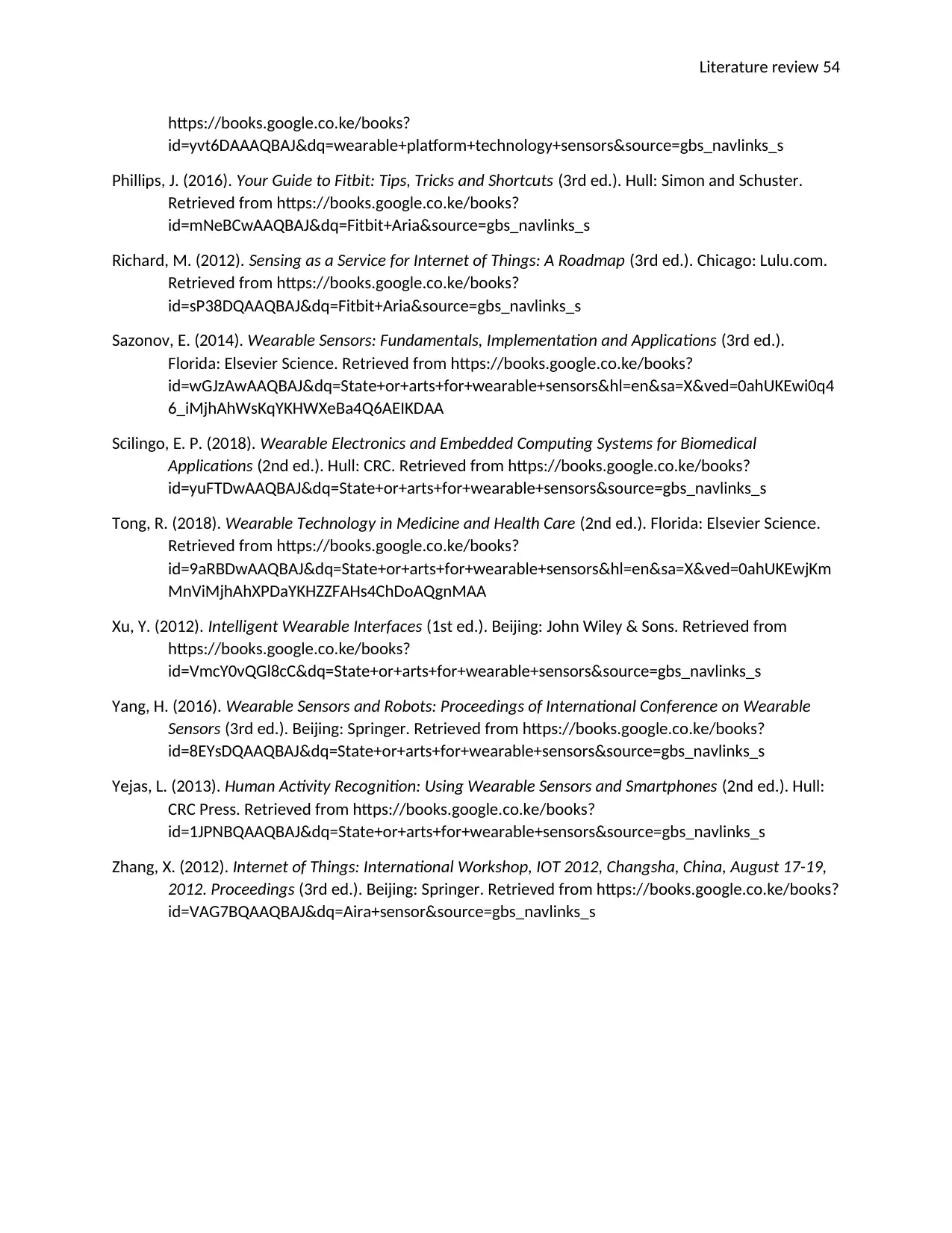
Literature review 54
https://books.google.co.ke/books?
id=yvt6DAAAQBAJ&dq=wearable+platform+technology+sensors&source=gbs_navlinks_s
Phillips, J. (2016). Your Guide to Fitbit: Tips, Tricks and Shortcuts (3rd ed.). Hull: Simon and Schuster.
Retrieved from https://books.google.co.ke/books?
id=mNeBCwAAQBAJ&dq=Fitbit+Aria&source=gbs_navlinks_s
Richard, M. (2012). Sensing as a Service for Internet of Things: A Roadmap (3rd ed.). Chicago: Lulu.com.
Retrieved from https://books.google.co.ke/books?
id=sP38DQAAQBAJ&dq=Fitbit+Aria&source=gbs_navlinks_s
Sazonov, E. (2014). Wearable Sensors: Fundamentals, Implementation and Applications (3rd ed.).
Florida: Elsevier Science. Retrieved from https://books.google.co.ke/books?
id=wGJzAwAAQBAJ&dq=State+or+arts+for+wearable+sensors&hl=en&sa=X&ved=0ahUKEwi0q4
6_iMjhAhWsKqYKHWXeBa4Q6AEIKDAA
Scilingo, E. P. (2018). Wearable Electronics and Embedded Computing Systems for Biomedical
Applications (2nd ed.). Hull: CRC. Retrieved from https://books.google.co.ke/books?
id=yuFTDwAAQBAJ&dq=State+or+arts+for+wearable+sensors&source=gbs_navlinks_s
Tong, R. (2018). Wearable Technology in Medicine and Health Care (2nd ed.). Florida: Elsevier Science.
Retrieved from https://books.google.co.ke/books?
id=9aRBDwAAQBAJ&dq=State+or+arts+for+wearable+sensors&hl=en&sa=X&ved=0ahUKEwjKm
MnViMjhAhXPDaYKHZZFAHs4ChDoAQgnMAA
Xu, Y. (2012). Intelligent Wearable Interfaces (1st ed.). Beijing: John Wiley & Sons. Retrieved from
https://books.google.co.ke/books?
id=VmcY0vQGl8cC&dq=State+or+arts+for+wearable+sensors&source=gbs_navlinks_s
Yang, H. (2016). Wearable Sensors and Robots: Proceedings of International Conference on Wearable
Sensors (3rd ed.). Beijing: Springer. Retrieved from https://books.google.co.ke/books?
id=8EYsDQAAQBAJ&dq=State+or+arts+for+wearable+sensors&source=gbs_navlinks_s
Yejas, L. (2013). Human Activity Recognition: Using Wearable Sensors and Smartphones (2nd ed.). Hull:
CRC Press. Retrieved from https://books.google.co.ke/books?
id=1JPNBQAAQBAJ&dq=State+or+arts+for+wearable+sensors&source=gbs_navlinks_s
Zhang, X. (2012). Internet of Things: International Workshop, IOT 2012, Changsha, China, August 17-19,
2012. Proceedings (3rd ed.). Beijing: Springer. Retrieved from https://books.google.co.ke/books?
id=VAG7BQAAQBAJ&dq=Aira+sensor&source=gbs_navlinks_s
https://books.google.co.ke/books?
id=yvt6DAAAQBAJ&dq=wearable+platform+technology+sensors&source=gbs_navlinks_s
Phillips, J. (2016). Your Guide to Fitbit: Tips, Tricks and Shortcuts (3rd ed.). Hull: Simon and Schuster.
Retrieved from https://books.google.co.ke/books?
id=mNeBCwAAQBAJ&dq=Fitbit+Aria&source=gbs_navlinks_s
Richard, M. (2012). Sensing as a Service for Internet of Things: A Roadmap (3rd ed.). Chicago: Lulu.com.
Retrieved from https://books.google.co.ke/books?
id=sP38DQAAQBAJ&dq=Fitbit+Aria&source=gbs_navlinks_s
Sazonov, E. (2014). Wearable Sensors: Fundamentals, Implementation and Applications (3rd ed.).
Florida: Elsevier Science. Retrieved from https://books.google.co.ke/books?
id=wGJzAwAAQBAJ&dq=State+or+arts+for+wearable+sensors&hl=en&sa=X&ved=0ahUKEwi0q4
6_iMjhAhWsKqYKHWXeBa4Q6AEIKDAA
Scilingo, E. P. (2018). Wearable Electronics and Embedded Computing Systems for Biomedical
Applications (2nd ed.). Hull: CRC. Retrieved from https://books.google.co.ke/books?
id=yuFTDwAAQBAJ&dq=State+or+arts+for+wearable+sensors&source=gbs_navlinks_s
Tong, R. (2018). Wearable Technology in Medicine and Health Care (2nd ed.). Florida: Elsevier Science.
Retrieved from https://books.google.co.ke/books?
id=9aRBDwAAQBAJ&dq=State+or+arts+for+wearable+sensors&hl=en&sa=X&ved=0ahUKEwjKm
MnViMjhAhXPDaYKHZZFAHs4ChDoAQgnMAA
Xu, Y. (2012). Intelligent Wearable Interfaces (1st ed.). Beijing: John Wiley & Sons. Retrieved from
https://books.google.co.ke/books?
id=VmcY0vQGl8cC&dq=State+or+arts+for+wearable+sensors&source=gbs_navlinks_s
Yang, H. (2016). Wearable Sensors and Robots: Proceedings of International Conference on Wearable
Sensors (3rd ed.). Beijing: Springer. Retrieved from https://books.google.co.ke/books?
id=8EYsDQAAQBAJ&dq=State+or+arts+for+wearable+sensors&source=gbs_navlinks_s
Yejas, L. (2013). Human Activity Recognition: Using Wearable Sensors and Smartphones (2nd ed.). Hull:
CRC Press. Retrieved from https://books.google.co.ke/books?
id=1JPNBQAAQBAJ&dq=State+or+arts+for+wearable+sensors&source=gbs_navlinks_s
Zhang, X. (2012). Internet of Things: International Workshop, IOT 2012, Changsha, China, August 17-19,
2012. Proceedings (3rd ed.). Beijing: Springer. Retrieved from https://books.google.co.ke/books?
id=VAG7BQAAQBAJ&dq=Aira+sensor&source=gbs_navlinks_s
1 out of 54
Your All-in-One AI-Powered Toolkit for Academic Success.
+13062052269
info@desklib.com
Available 24*7 on WhatsApp / Email
![[object Object]](/_next/static/media/star-bottom.7253800d.svg)
Unlock your academic potential
© 2024 | Zucol Services PVT LTD | All rights reserved.